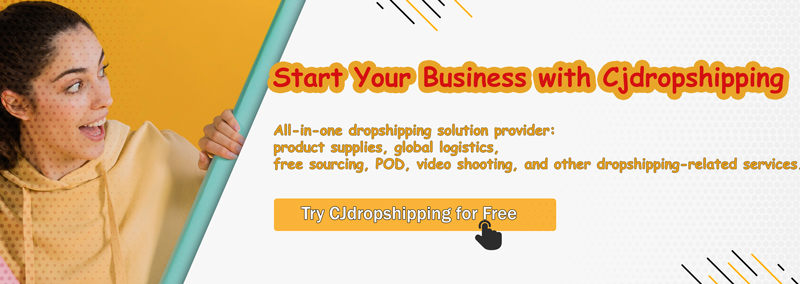Introduction: Selling on Amazon in 2025 remains one of the most accessible ways for new entrepreneurs to start an online business. With Amazon’s massive customer base and streamlined fulfillment options, even beginners can achieve success quickly. In fact, more than 60% of all sales on Amazon come from third-party sellers, many of them small businesses. Amazon’s marketplace boasts 310+ million global users and controls about 38% of U.S. e-commerce, giving new sellers an unparalleled audience reach. Crucially, 58% of new Amazon sellers turn a profit within their first year, thanks to Amazon’s built-in traffic and fulfillment infrastructure. This guide will provide deep insights and practical tips on how beginners can succeed on Amazon in 2025 – from choosing the right product categories to avoiding common pitfalls. Let’s dive in!
Why Amazon Is Still the Best Place for Beginners in 2025
Amazon continues to dominate e-commerce in 2025, making it the ideal platform for new sellers. Here’s why:
-
Massive Built-In Customer Base: Amazon has over 310 million users globally (with ~230 million in the US alone). By selling on Amazon, beginners instantly tap into this huge pool of ready-to-buy shoppers. There’s no need to drive your own traffic as you would on a standalone website; customers naturally flock to Amazon for just about everything.
-
High Marketplace Trust and Prime Membership: Consumers trust Amazon’s fast shipping and customer service. Over 200 million shoppers are Amazon Prime members, expecting fast Prime delivery on products. New sellers can leverage this by using Fulfillment by Amazon (FBA) to have their products Prime-eligible. Amazon’s trusted brand lowers the barrier for a customer to buy from a seller they’ve never heard of – a huge advantage for beginners.
-
Low Barrier to Entry: Setting up an Amazon seller account is straightforward. For a Professional Seller account, it costs $39.99/month plus selling fees (usually a ~15% referral fee per sale) – a reasonable entry cost compared to starting a brick-and-mortar store. Amazon’s tools (like the Revenue Calculator) make it easy to estimate fees and profits. You don’t need advanced technical skills to list products, and Amazon’s seller support resources can help new entrepreneurs get started quickly.
-
Fulfillment & Logistics Made Easy: Through FBA, Amazon will handle storage, packing, and shipping of your products to customers, as well as returns and customer service. It’s incredibly beginner-friendly – you can send a box of your products to an Amazon fulfillment center and let Amazon handle the rest. In fact, 82% of Amazon sellers use FBA to leverage this convenience. This means even if you’re a one-person business with no warehouse, you can offer Prime 2-day shipping to customers worldwide.
-
Proven Success of New Sellers: Thousands of new sellers join Amazon every year and find success. In 2024, 55,000+ small and medium independent sellers each surpassed $1 million in sales. The average annual sales for U.S. SMB sellers was about $290,000 in 2024. These figures show that Amazon is not saturated beyond opportunity – newcomers can still break in and thrive. Moreover, Amazon reports that more than 58% of sellers see profitability within their first year, demonstrating that with the right approach, beginners can recoup their investment and make money relatively quickly.
-
Global Reach and Expansion Opportunities: Starting on Amazon US is great, but sellers can expand to Amazon’s international marketplaces over time (Europe, Asia, etc.) to reach millions more customers. Amazon allows easy global listing if you choose to scale up. No other platform offers such seamless international reach for a beginner.
In summary, Amazon’s vast customer base, trusted shopping experience, and powerful fulfillment network combine to create an ecosystem where beginners can succeed. Selling on Amazon in 2025 remains absolutely worth it for new sellers, as long as you take the time to research products and follow best practices (which this guide will cover in detail).
Top Beginner-Friendly Product Categories
One key to success as a new seller is picking the right category. Certain product categories are especially beginner-friendly – meaning they have high demand, low entry barriers (no special approval needed), and manageable competition. Here are some of the best categories for new Amazon sellers in 2025:
-
Home & Kitchen: This broad category is consistently among the top sellers on Amazon and is ungated (open) for new sellers. Home and kitchen products – from cookware and utensils to home décor and small appliances – enjoy steady, year-round demand. Shoppers are always looking for items to improve their home life. As a beginner, you can launch simple kitchen tools (spatulas, food containers, coffee mugs) or home organizers knowing there’s a huge audience. For example, items like food scales, travel tumblers, water bottles, can openers, and dish cloths regularly feature on Amazon’s Best Sellers lists. Home & Kitchen also allows you to start with unbranded or private label products easily. Focus on solving everyday problems (storage solutions, convenient cooking gadgets) to stand out.
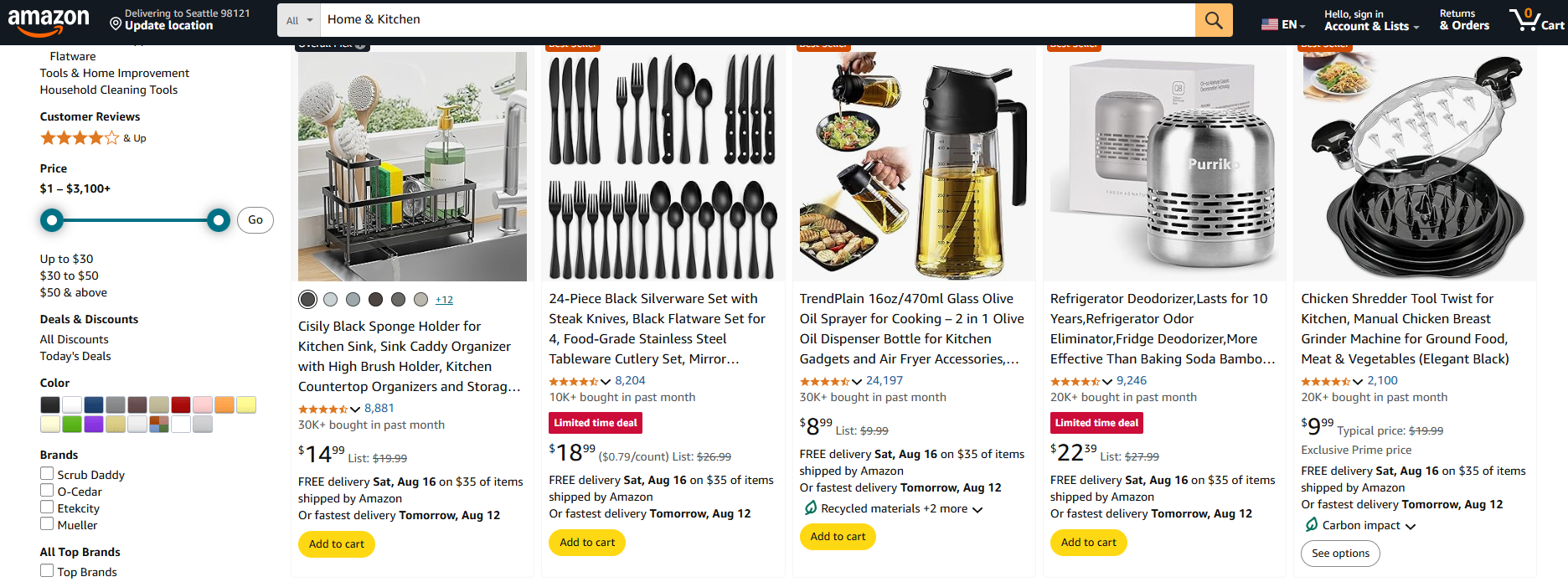
-
Sports & Outdoors: The sports/outdoors category is ungated and covers fitness gear, outdoor recreation, and more. Consumers are investing in home fitness and outdoor hobbies, a trend that remains strong post-pandemic. New sellers can capitalize on this by offering products like yoga mats, resistance bands, jump ropes, camping accessories, or water bottles. These are typically easy to source and ship. Sports equipment revenue in the U.S. is projected to grow steadily through 2029, indicating strong ongoing demand. Since many sports/outdoor items are simple (no electronics or complex sizes), they’re great for beginners. Just be sure any fitness products meet quality expectations to avoid returns.
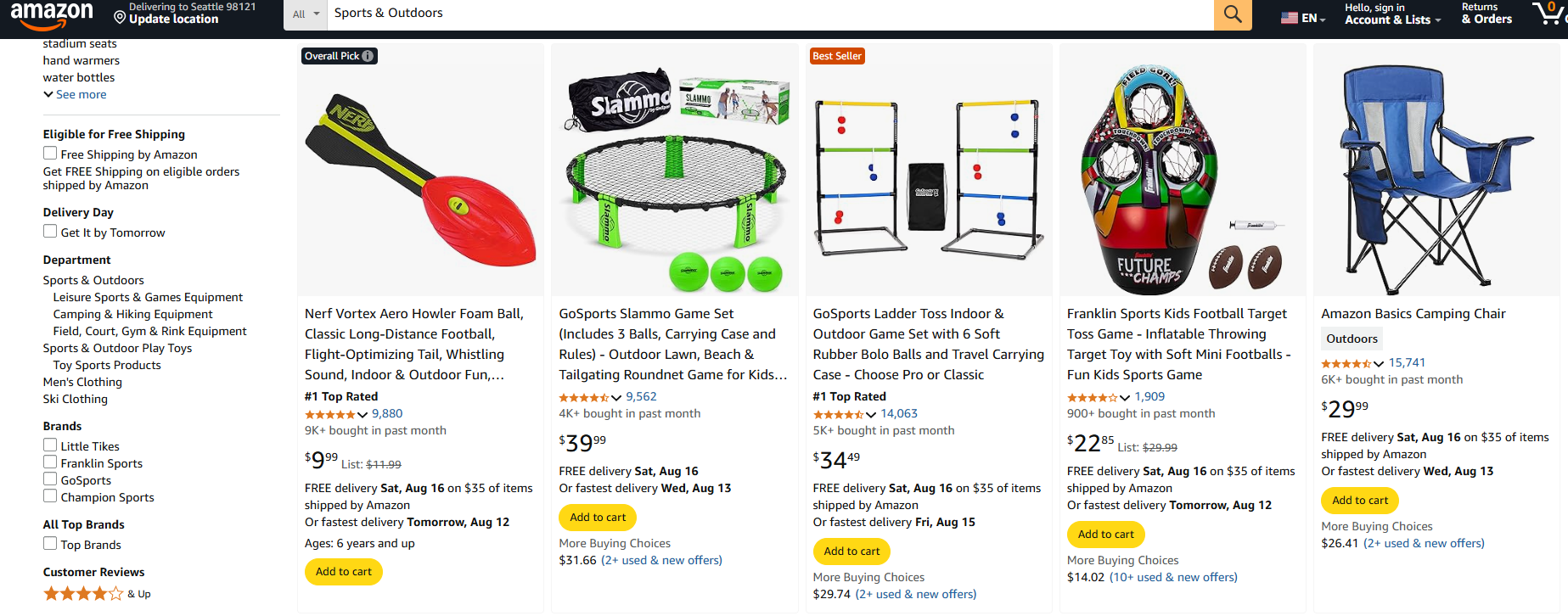
-
Pet Supplies: Pet owners are passionate and tend to spend generously on their furry friends. Pet Supplies is an open category on Amazon and always in demand. For a new seller, this niche offers lots of opportunities – think pet toys, pet grooming tools (brushes, nail grinders), pet beds, feeding bowls, etc. These items have repeat purchase potential (toys wear out, pets chew through things) and an emotional driver (people love spoiling pets). Pet products are also great for organic traffic: a unique pet accessory can attract search traffic since pet owners actively hunt for new solutions. Focus on quality and safety (pets can be rough on products). A bonus: pet items are often small/light, keeping FBA fees low.
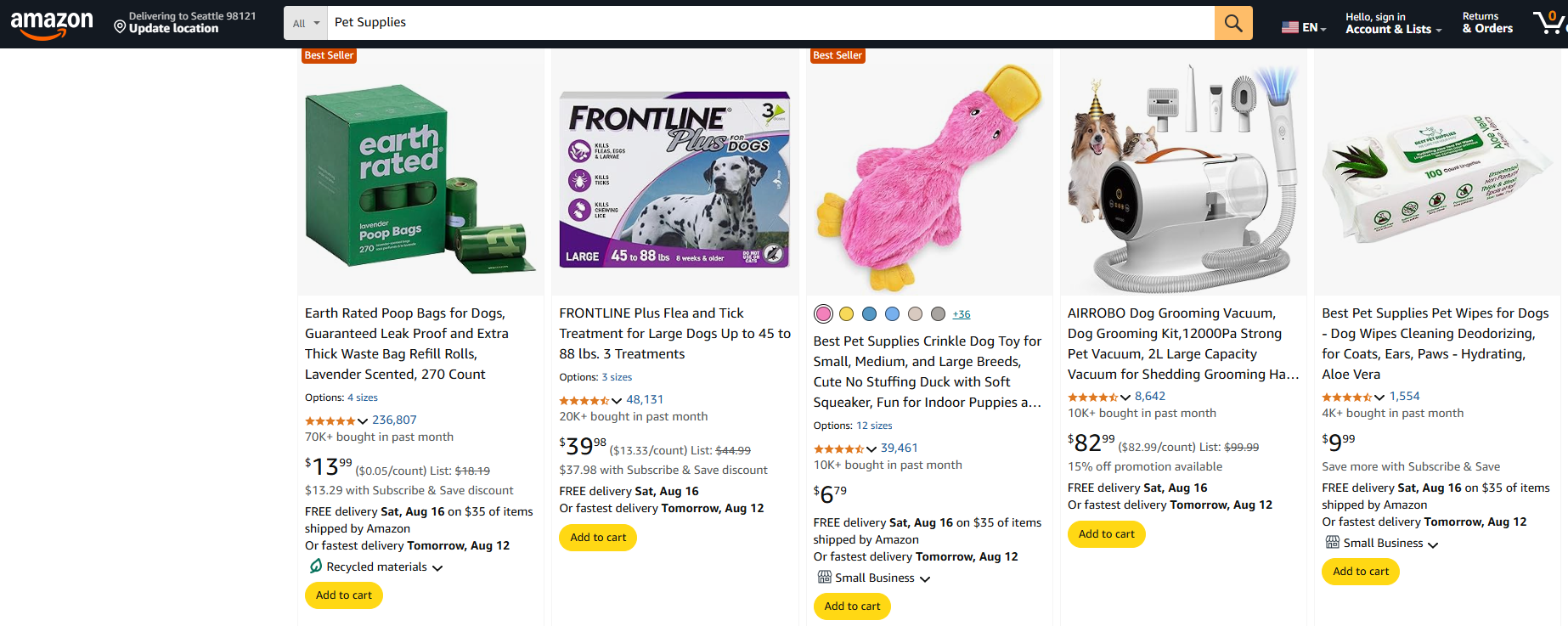
-
Beauty & Personal Care: This category is partially ungated and hugely popular on Amazon. While certain subcategories (topical medications, luxury brands) might require approval, many beauty products are open to new sellers – especially tools and accessories. Examples: makeup brushes, facial rollers, nail art kits, hair accessories, false eyelashes, etc. Beauty and self-care trends (like K-beauty, clean skincare) drive high demand for new products. In 2025, items like hair growth oils, acne patches, moisturizers, and exfoliating tools are top sellers. Beginners can tap into trends by sourcing popular beauty gadgets (e.g. LED face masks or gua sha massage stones). Important: Ensure product quality and compliance (no unsafe ingredients). Beauty buyers are discerning, so great packaging and branding help a lot here.
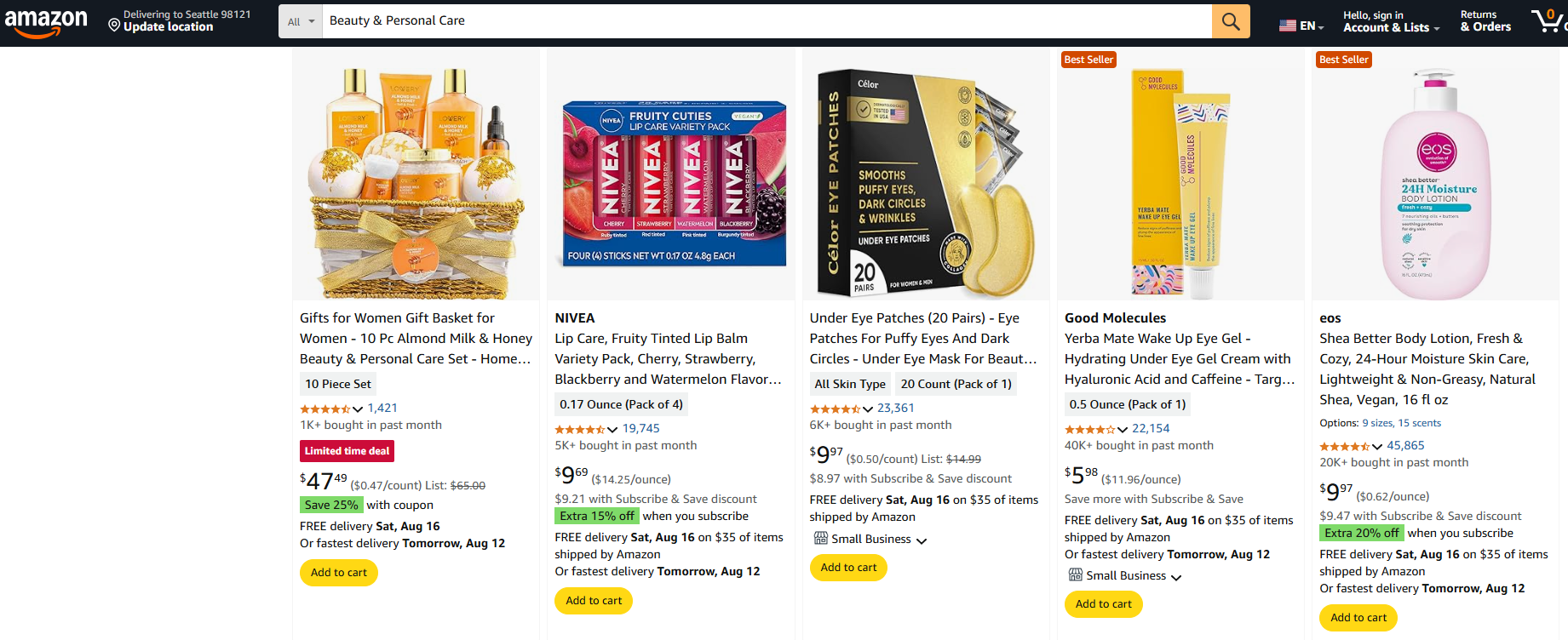
-
Baby Products: The Baby category is generally ungated and covers anything for infants and toddlers. Parents on Amazon are constantly searching for safe, helpful baby items – from baby toys and books to feeding accessories, baby proofing gear, and nursery items. New sellers can find success with innovative baby products that make parenthood easier (e.g. a baby bath kneeler, car seat organizers, diaper bag organizers). A big plus: baby product demand is continuous and renewing (new babies born every day), and parents often become repeat customers if they like your brand. For instance, a baby play mat with a detachable pillow has become a nursery essential with a strong profit margin over 60%. Be mindful of safety certifications (anything for baby use should meet safety standards and be BPA-free, etc.). If you provide a genuinely helpful baby product, reviews and word-of-mouth will drive free traffic to your listing.

-
Books (and Media): Books are one of Amazon’s original categories and remain ungated. If you have access to wholesale or used books, this can be a starting point with very low cost. Many new sellers start by selling used textbooks or niche books lying around. While the margins can be smaller and scaling requires volume, it’s a beginner-friendly way to learn Amazon’s system. Books demand is steady (especially during back-to-school season or holidays). Note: Used book selling involves listing on existing pages and condition grading – a simpler process than creating a new product listing from scratch. This category can teach you the ropes of order fulfillment and customer service on Amazon in a low-risk way. (Media items like DVDs or video games are more restricted and not recommended for beginners due to IP concerns).
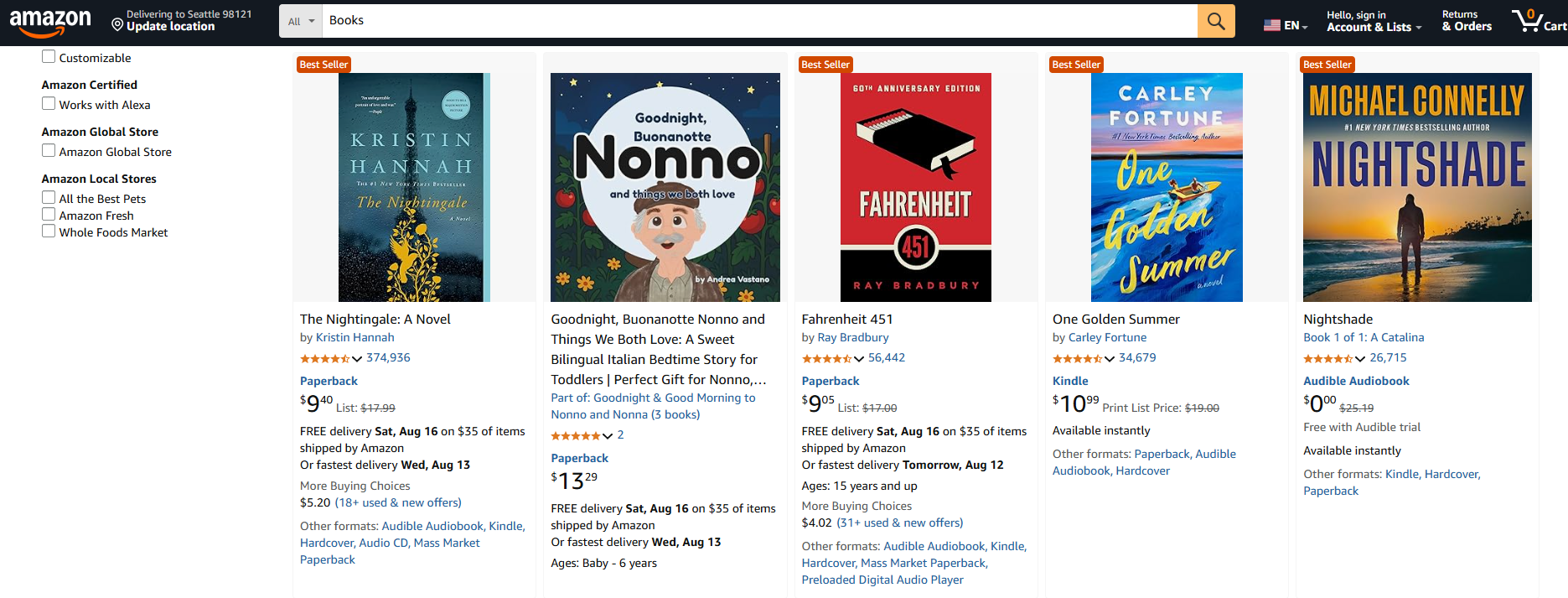
-
Clothing & Accessories: Fashion can be competitive, but sub-niches in clothing are ungated and beginner-friendly. Simple accessories like socks, hats, jewelry, or scarves are easy to source and ship. Trending items such as oversized hoodies (hugely popular on TikTok) are seeing high demand among young shoppers. The key here is to find a specific niche or style – for example, maternity wear, plus-size activewear, or funny slogan T-shirts (if using print-on-demand). Private labeling your own simple apparel (like plain hoodies or leggings) is possible for cheap via overseas suppliers. Keep in mind returns are higher in apparel due to sizing issues, so if you’re a complete novice you might proceed with caution. Still, many new sellers do well with accessories or one-size-fits-all items (like beanies or jewelry) which avoid the sizing problem. Use high-quality images and clear size charts to succeed in clothing.
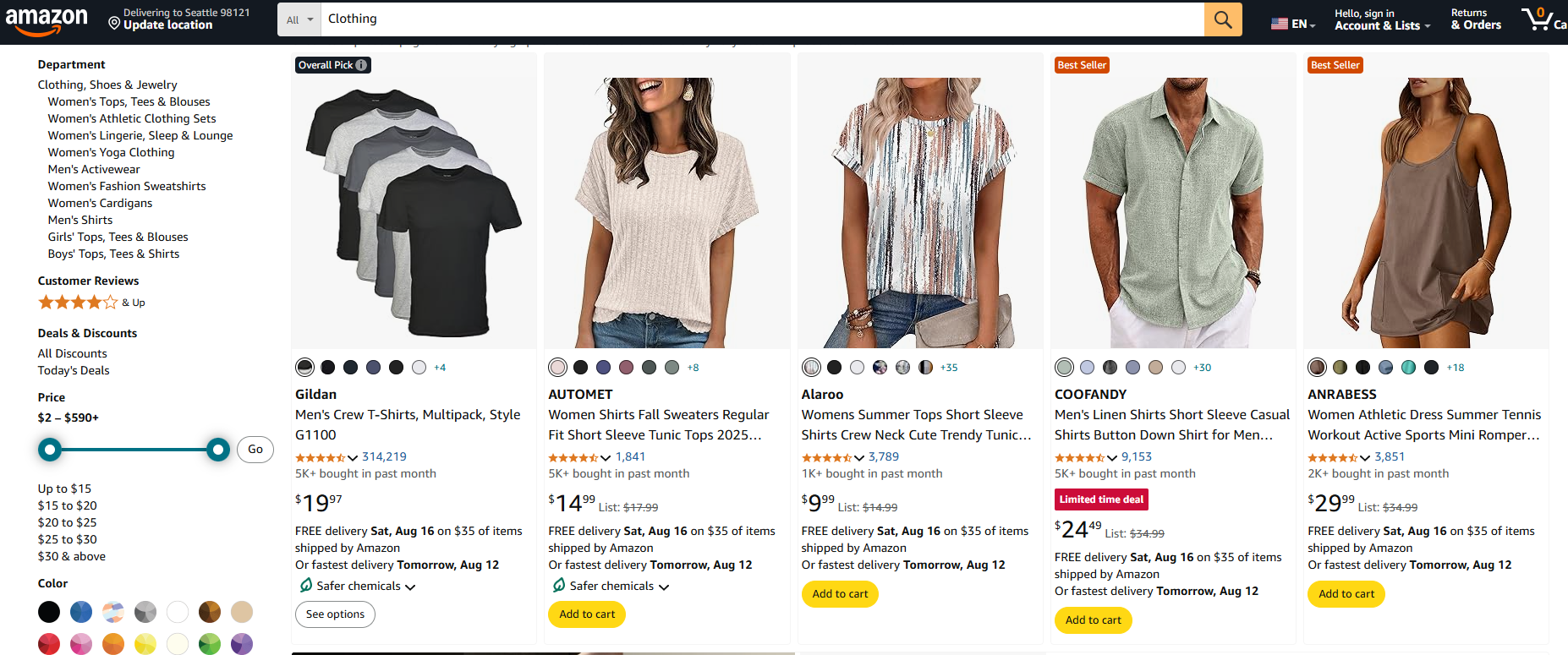
-
Arts, Crafts & DIY: Craft supplies and DIY tools are ungated and often overlooked gems. The crafting community is active on Amazon, seeking everything from painting supplies, yarns, and fabrics to scrapbooking tools, resin art kits, and more. If you enjoy or understand a particular craft, you can spot niche products to sell. For example, candle-making kits or embroidery starter sets can be excellent beginner products – they cater to hobbyists and often have stable demand. Arts & Crafts was highlighted as a profitable area in 2025, with items like specialty gilding wax for furniture selling over 800 units/month due to the ongoing DIY décor trend. Craft items are typically small and light, making fulfillment costs low. And passionate hobbyists tend to leave great reviews for products they love, which boosts your organic rankings.

These are just a few of the top categories open to new sellers. Other ungated categories worth exploring include Office Products, Tools & Home Improvement, Automotive Accessories, and Toys & Games. Each of these has its nuances, but all present opportunities for beginners without the hurdle of special approvals. For instance, Automotive Accessories (like car organizers or cleaning tools) consistently rank high in sales and are straightforward to source, while Toys & Games enjoy surges during holidays and when new kids’ movie releases drive toy trends. As a new seller, focus on categories where you can offer a simple, quality product that fulfills a clear need. Ungated categories allow you to list immediately and test the market. By starting in these beginner-friendly areas, you can build up sales history and reviews, then potentially expand into gated categories later (once you have more experience and resources to get approvals).
15 Best Products to Sell on Amazon for Beginners (Most Popular Picks)
Choosing a specific product to sell is arguably the most important decision for a new Amazon seller. To help spark ideas, here are 15 of the best products or niches for beginners – these items are popular in 2025, relatively easy to source, and have strong demand with reasonable competition. Each comes with a brief explanation of why it’s a great choice:
-
Reusable Water Bottles and Travel Tumblers – Eco-friendly reusable bottles are perennially popular as consumers move away from single-use plastics. In 2025, the trend is still going strong with products like the Stanley Quencher tumbler going viral on social media. New sellers can launch an unbranded stainless steel water bottle or insulated travel mug targeting a specific niche (e.g. a bottle with time-marked hydration reminders, or kid-friendly designs). Demand is huge – water bottles and tumblers frequently appear on Amazon’s top seller lists – and these items are simple to private label. They have healthy profit margins (since customers will pay $15-$30 for a good bottle that costs a few dollars to produce). Just ensure yours is BPA-free and has an appealing design. Reason to sell: Mass market demand, easy to differentiate with design, and supports sustainability trend.
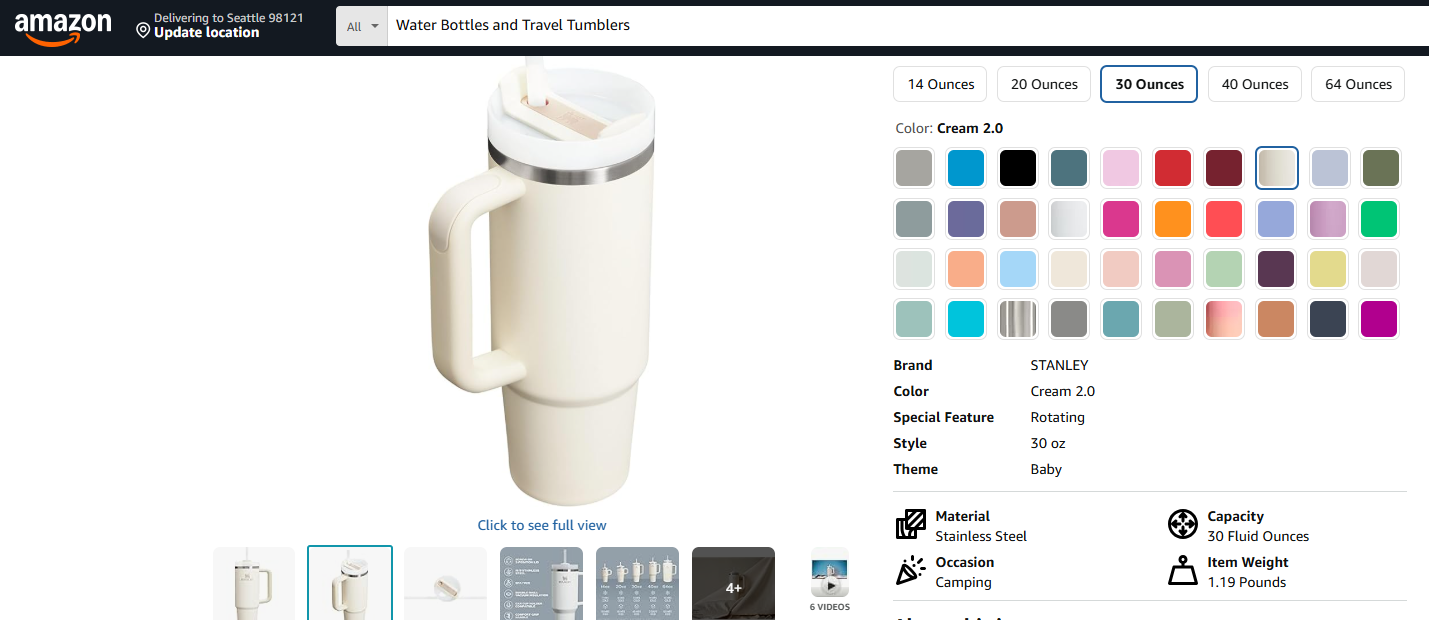
-
Phone Cases and Screen Protectors – Nearly everyone has a smartphone, and they love to customize and protect it. Phone cases, in particular, are a beginner-friendly product: they’re cheap to source (often <$1 each in bulk), extremely lightweight, and the demand is endless as new phone models release each year. In Amazon’s electronics and automotive accessory lists, phone screen protectors and cases are consistently top sellers. As a new seller, you could focus on cases for a specific brand (e.g. stylish iPhone cases) or a specific niche (rugged cases for outdoor enthusiasts, or cute printed cases for teens). Competition can be high, so differentiation is key – consider unique printed designs, added functionality (wallet cases, battery cases), or targeting a less-served phone model. Screen protectors are another volume play – selling multi-packs for new phone models can yield steady sales. Reason to sell: Huge user base, repeat purchases (people buy new cases often), and very low shipping cost due to small size.

-
Resistance Bands and Yoga Mats – Home fitness gear remains a hot niche for beginners. Resistance loop bands and yoga mats saw massive popularity during the pandemic and that momentum continues as many stick to home workouts. On Amazon, yoga mats routinely generate over $100,000 in monthly revenue with thousands of units sold. These products are relatively simple (no electronics or complex parts) and appeal to a broad market of fitness enthusiasts, from beginners to pros. A new seller can start by selling a set of resistance bands (with different tension levels) or a high-density yoga mat. The key is to differentiate via quality – e.g., bands that are snap-resistant or a mat that is extra thick or non-slip. Including a little workout guide or carrying bag can also add value. Reason to sell: Evergreen demand (fitness is year-round), easy to source, and unit costs are low (bands often <$5/set from suppliers) but perceived value is high.
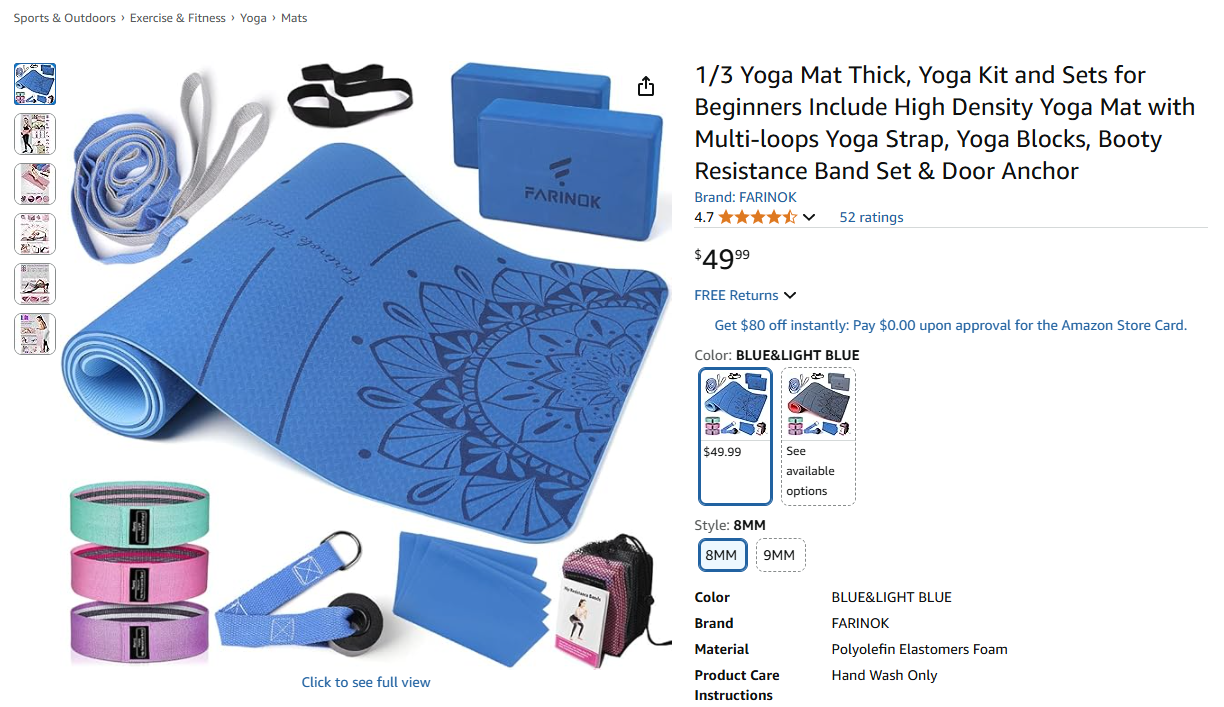
-
Pet Grooming Glove or Brush – Pet products are gold for Amazon sellers. A perfect starter item is a pet grooming glove (the kind with silicone tips that remove shedding fur) or a de-shedding brush. These solve a real pet owner problem (excess fur around the home) and have proven demand. Pet grooming tools sell strongly year-round; for example, a popular deshedding tool often ranks at the top of Pet Supplies. New sellers can source these gloves or brushes inexpensively and bundle them (e.g., a combo of glove + brush + pet nail clippers) to offer more value. Pet owners tend to impulse-buy useful gadgets for their dogs and cats, especially under $20. Just ensure the product material is safe and durable. Reason to sell: Large passionate customer base, low risk of returns (one-size-fits-all), and lots of opportunities to differentiate (through color, bundle, or targeting specific animals like long-hair cats vs. dogs).
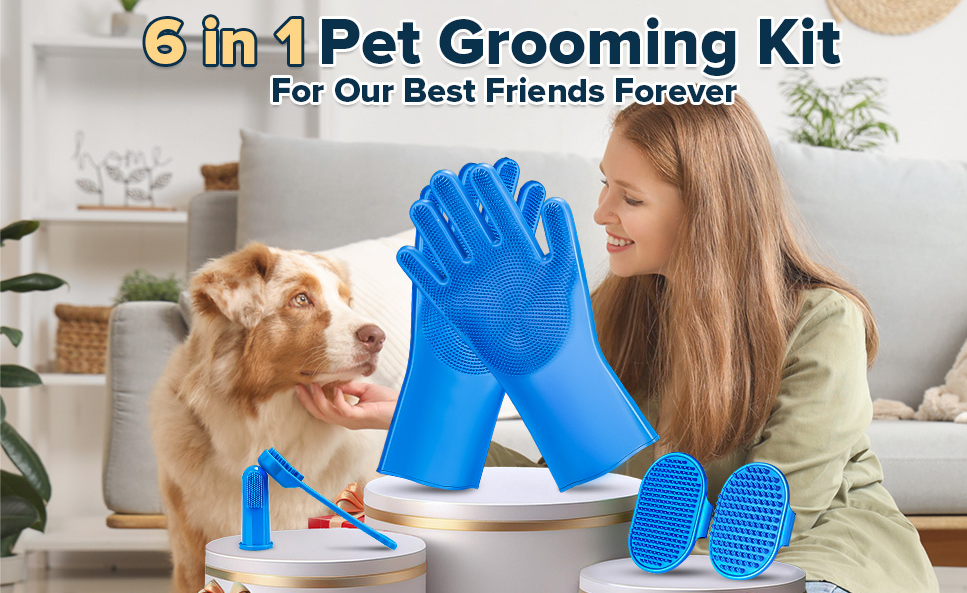
-
Coffee Accessories (Reusable Coffee Filters or French Press) – Coffee is a huge niche, and millions of Amazon shoppers are coffee enthusiasts looking for accessories. Beginner sellers can succeed with items like a stainless steel reusable coffee filter (for Keurig or drip machines) or a classic French press coffee maker. These items are relatively simple in design but have strong, stable demand. For instance, reusable filters appeal to eco-conscious consumers who want to avoid disposable paper filters or K-cups. A reusable coffee pod or filter can sell in high volumes and is small/lightweight. French presses likewise are popular as affordable gifts and starters for home coffee brewing. You’ll need to ensure any item touching food is FDA-safe material. There’s room to stand out with premium packaging or including a little recipe booklet for coffee drinks. Reason to sell: High demand from a broad demographic (nearly everyone drinks coffee), and these products aren’t seasonal – they sell all year. Plus, coffee lovers tend to leave positive reviews if the product enhances their daily ritual.
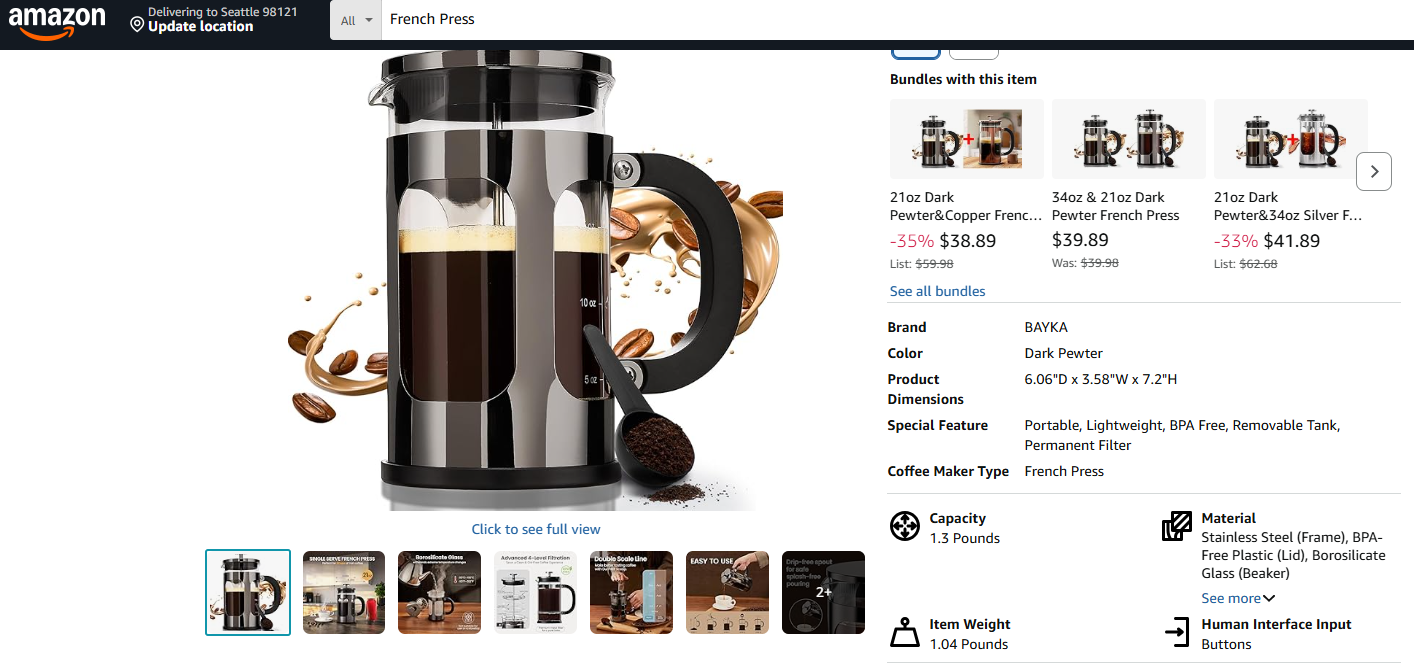
-
Baby Muslin Swaddle Blankets – In the baby category, swaddle blankets made of soft muslin cotton have been trending for a few years and remain a staple purchase for new parents. If you can source a set of 3-4 cute patterned swaddles, you’re tapping into a product that virtually every newborn baby will use. On Amazon, baby blankets and swaddles are consistently high-ranking items. They present a low risk for a new seller: no sizes to worry about, and parents often buy multiple sets. You can differentiate with unique designs (e.g., modern minimalist patterns or themes like jungle animals) or ultra-soft organic cotton material. Given that a baby directly uses it, focus on quality and safety (non-toxic dyes, breathable fabric). Reason to sell: Predictable demand (as the birth rate drives new customers constantly), relatively low manufacturing cost, and the potential for branding (you could build a baby brand starting with swaddles and expand to other baby textiles).

-
LED String Lights (Fairy Lights) – Small decorative LED string lights are extremely popular for home decor, dorm rooms, weddings, and holidays. These fairy lights or LED curtain lights sell like hotcakes especially around Q4, but also year-round for ambient decor. A beginner can easily source battery-powered or USB-powered string lights in various lengths. They are cheap to produce, light to ship, and have wide appeal (everyone from college students decorating a room to event planners needing inexpensive lights). On Amazon, some LED curtain light sets are making ~$25k per month in sales. To stand out, offer something special: maybe lights with remote control and different color modes, or uniquely shaped lights (stars, vines, etc.). Also ensure proper certifications (they should be safe, though low voltage LED lights are typically fine). Reason to sell: Lightweight, inexpensive, and a simple but in-demand product – great for learning the ropes of Amazon.
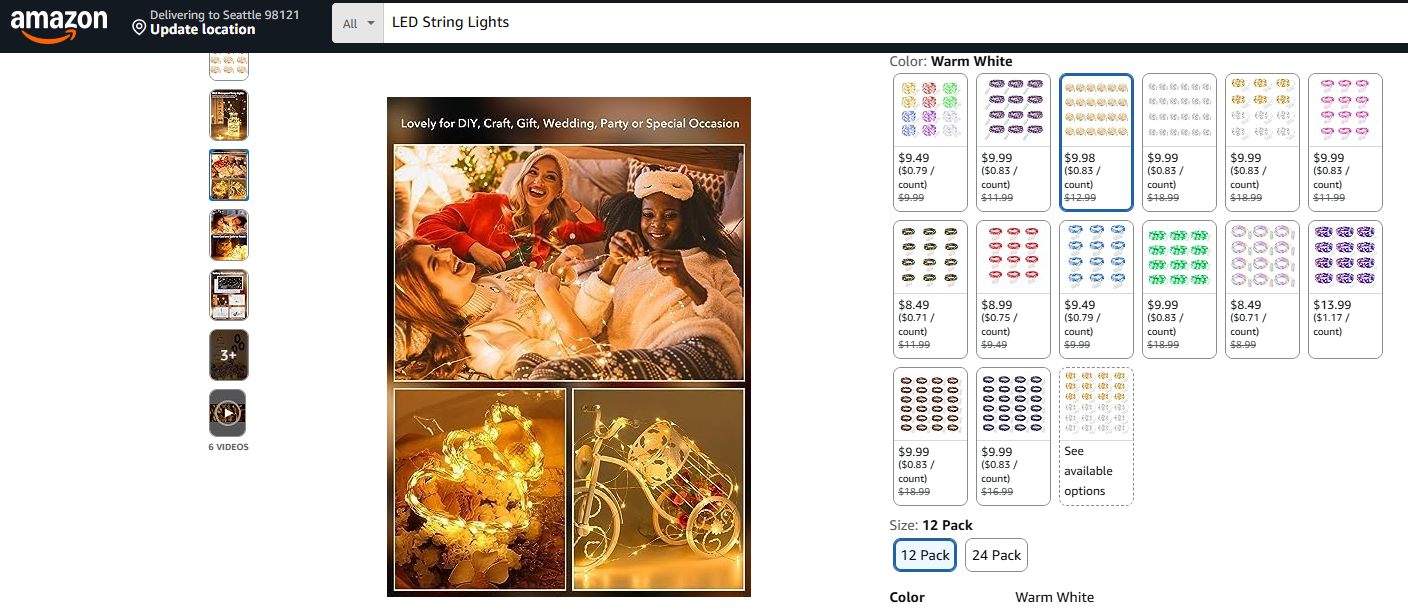
-
Kitchen Silicone Utensil Set – Beginner sellers often do well with bundled kitchen utensil sets made of silicone (spatulas, spoons, tongs, etc.). These sets meet a common need (especially for new households or students setting up a kitchen) and silicone is attractive because it’s heat-resistant and non-scratch for cookware. A 10-15 piece utensil set can be sourced relatively cheaply and sold at a decent price point (often $20-$30). Kitchen utensils frequently appear among Amazon’s Best Sellers in Kitchen & Dining. By bundling multiple tools together, you increase perceived value and differentiate from single-tool listings. Pay attention to reviews of similar products to improve quality (e.g., ensure handles don’t come loose, and use food-grade silicone). Since the kitchen niche is broad, even new sellers can carve out a spot by offering a stylish color theme or including a utensil holder. Reason to sell: High demand (everyone needs kitchen tools), easy to bundle for value, and not technically complex or prone to defects.

-
Holiday Decorations (e.g. Christmas Tree Storage Bag or Halloween Decor) – Seasonal products can be a boon for new sellers if timed right. For example, a Christmas tree storage bag (for storing artificial trees) spikes in demand right after the holidays and has consistent year-to-year need. Similarly, Halloween string lights or projectors, patriotic July 4th decor, etc., have predictable seasonal spikes. While not year-round sellers, these items can generate a lot of sales in a short window. Beginners can start with one season they’re familiar with – say, a high-quality Christmas storage solution or a bundle of popular holiday decorations – and capture that seasonal traffic. An Amazon snippet noted holiday decorations as a good niche for beginners. The trick is inventory planning: ensure you stock up well before the season and be prepared for a slow period after the holiday. Reason to sell: Seasonal items often face less competition from big brands, and customers need them urgently during the season – giving you a chance to rank and sell high volumes if you time it right. It’s a way for a new seller to make a splash during a peak demand time.
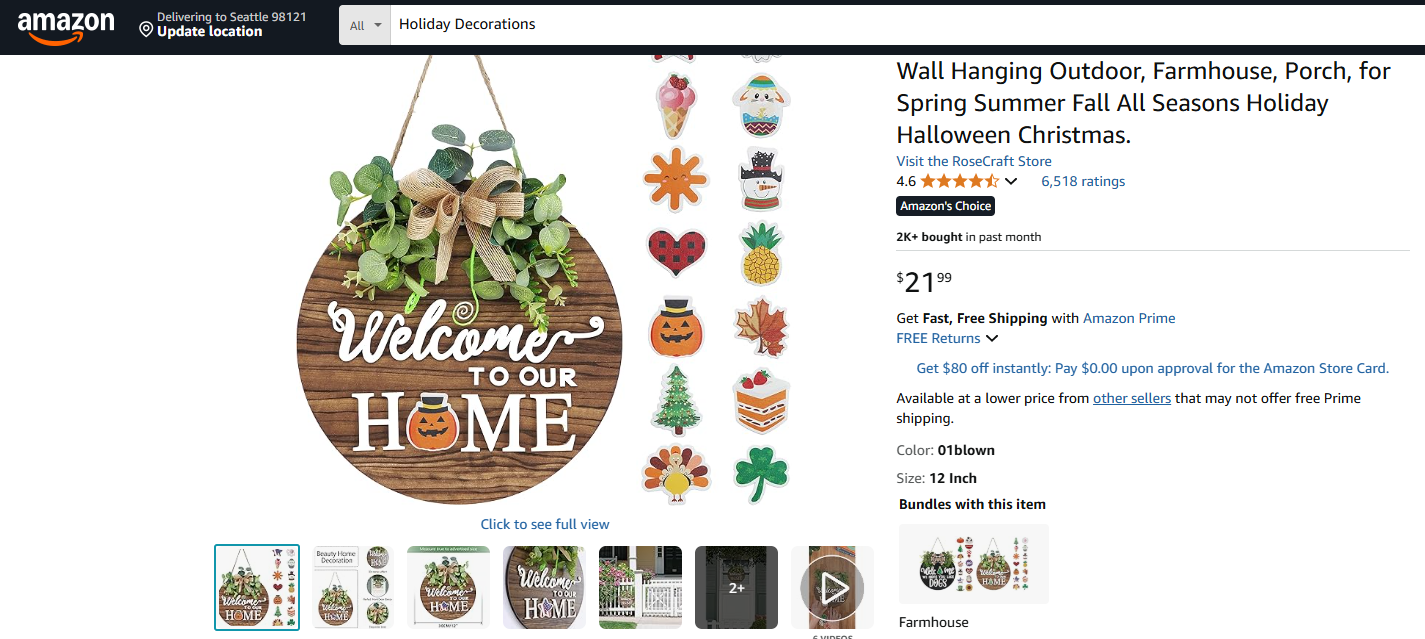
-
Personal Care Appliances (Electric Toothbrush or Facial Cleansing Brush) – Small personal care electronics, such as a rechargeable electric toothbrush or a vibrating facial cleansing brush, are trending as affordable at-home wellness devices. By 2025, these gadgets are mainstream and see strong sales on Amazon. For instance, electric toothbrushes generate tens of thousands in monthly revenue. As a new seller, entering the electronics category requires care (ensuring certifications like FCC for anything with Bluetooth or charging), but starting with a simpler device like a basic sonic toothbrush is feasible. Many ODM manufacturers offer generic models you can brand. These products sell well because they’re cheaper than name brands but still deliver function. Position yours with extra brush heads or a travel case to add value. Reason to sell: Recurring need (brush heads need replacing, new customers enter the market as old devices wear out), and people are increasingly health-conscious about oral care and skincare. Just make sure to comply with any safety regulations and provide clear instructions.
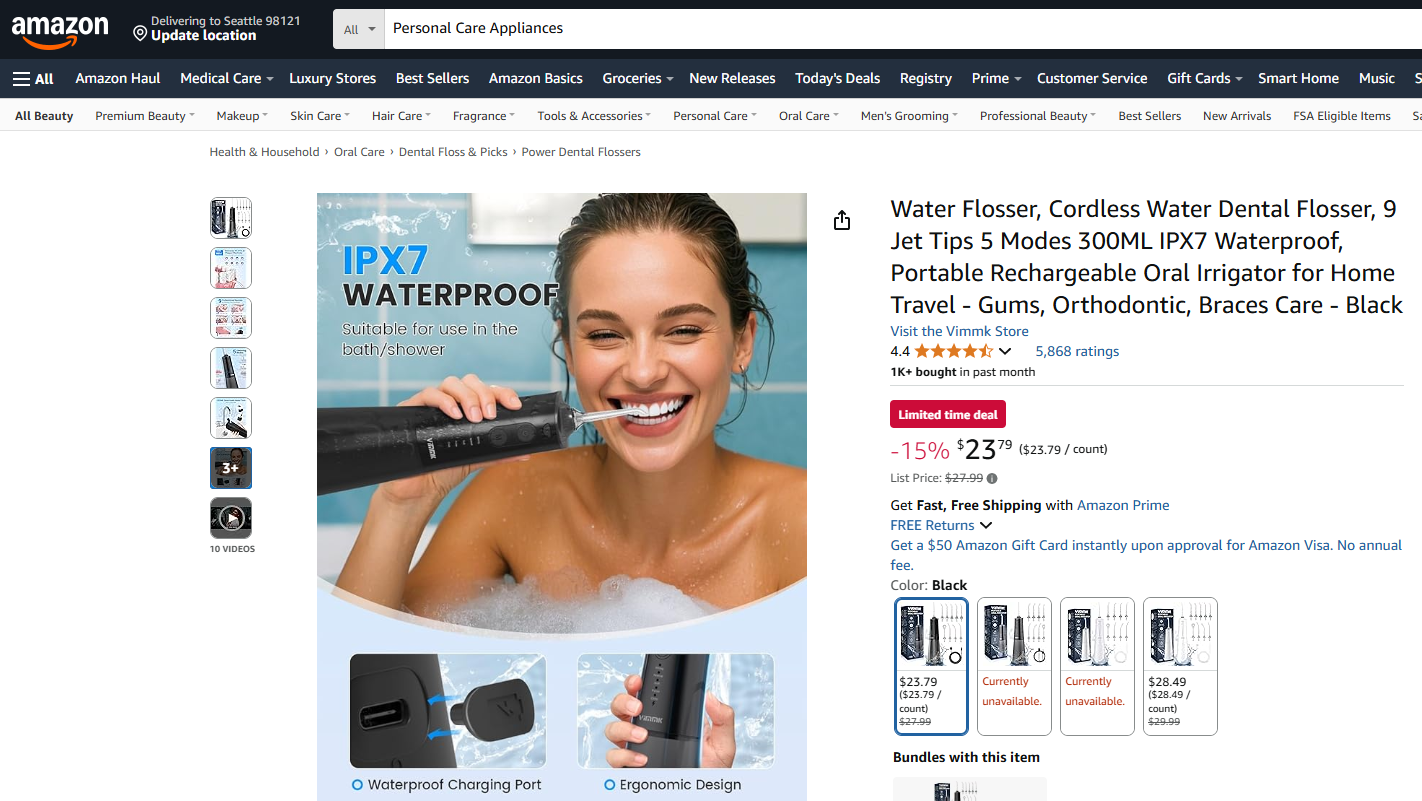
-
Puzzles and Board Games (Toy & Games niche) – The Toys & Games category is fun and can be profitable if you pick the right product. In recent years, puzzles have seen a resurgence in popularity (especially during lockdowns) and continue to sell well. A beginner could partner with a supplier to create a unique jigsaw puzzle – perhaps featuring original artwork or catering to a niche (e.g., a puzzle for kids that doubles as an educational tool, or a puzzle series of world landmarks). Board games can be more complex to create, but even simple card games (think along the lines of trivia cards, conversation starter cards) can do well. The advantage here is that these products encourage family time and make great gifts, so Q4 (holidays) in particular will see high sales. Puzzles are ungated and a new seller can list them without issue. Keep in mind intellectual property: use original designs or properly licensed images for puzzles/games. Reason to sell: High giftability, strong seasonal peaks, and people often buy multiple puzzles/games (collection mentality). Plus, you can build a brand with a series of related puzzles or games if one takes off.
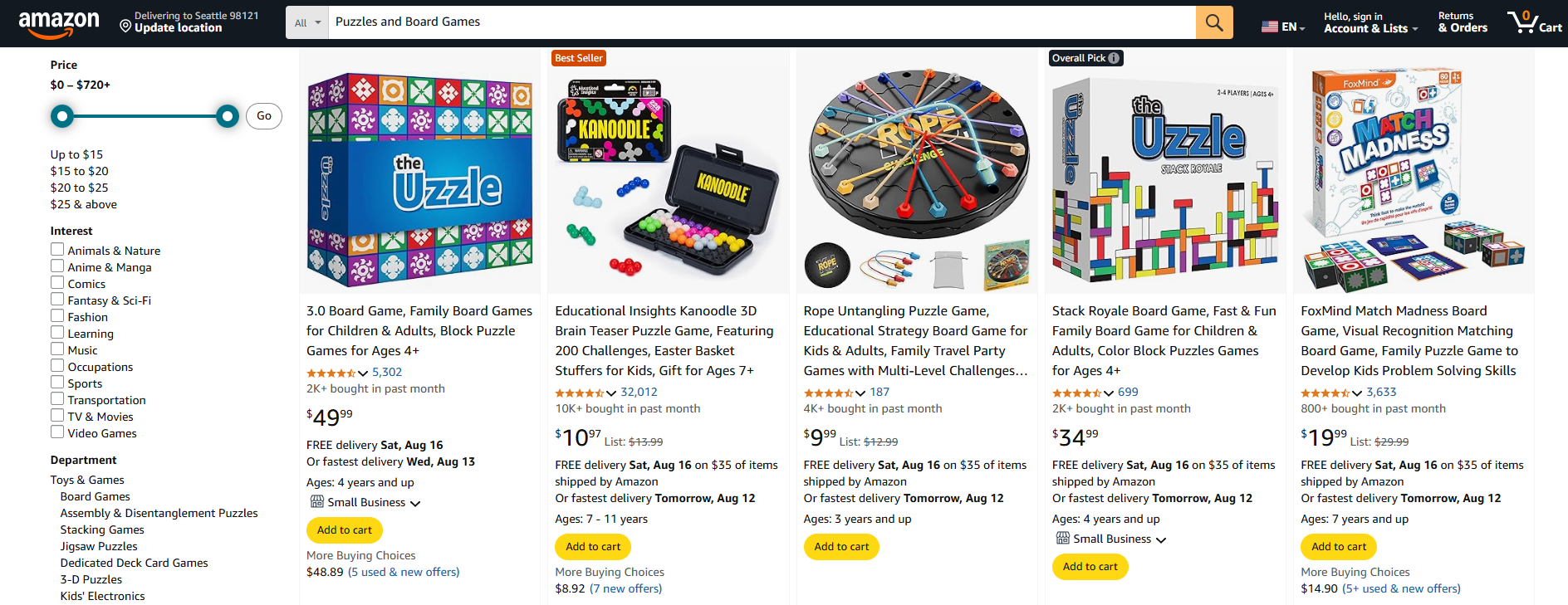
-
Car Accessories (Car Phone Mount or Organizers) – Automotive accessories offer a treasure trove of product ideas for beginners, because car owners constantly seek gadgets to enhance convenience. Two top picks: a car phone mount and a car backseat organizer. Car phone mounts are among Amazon’s best-selling automotive products – every driver with a smartphone is a potential customer. They’re small, inexpensive, and there are various types (dash mounts, vent mounts, magnetic, clamp style). A newcomer can introduce an improved design (for example, a mount that also wirelessly charges the phone). Similarly, car seat organizers (those multi-pocket organizers that hang on the back of a seat or trunk) solve the clutter problem and are popular with parents and rideshare drivers. They can be sourced cheaply in bulk. Focus on durability (reinforced straps, quality stitching) and consider bundling with related items (like a trash bin or sunshade). Reason to sell: Large market (millions of vehicles), constant replacement demand (products wear out or new car = new accessories), and relatively low competition from big brands (no “Nike of car mounts” dominating, for example).
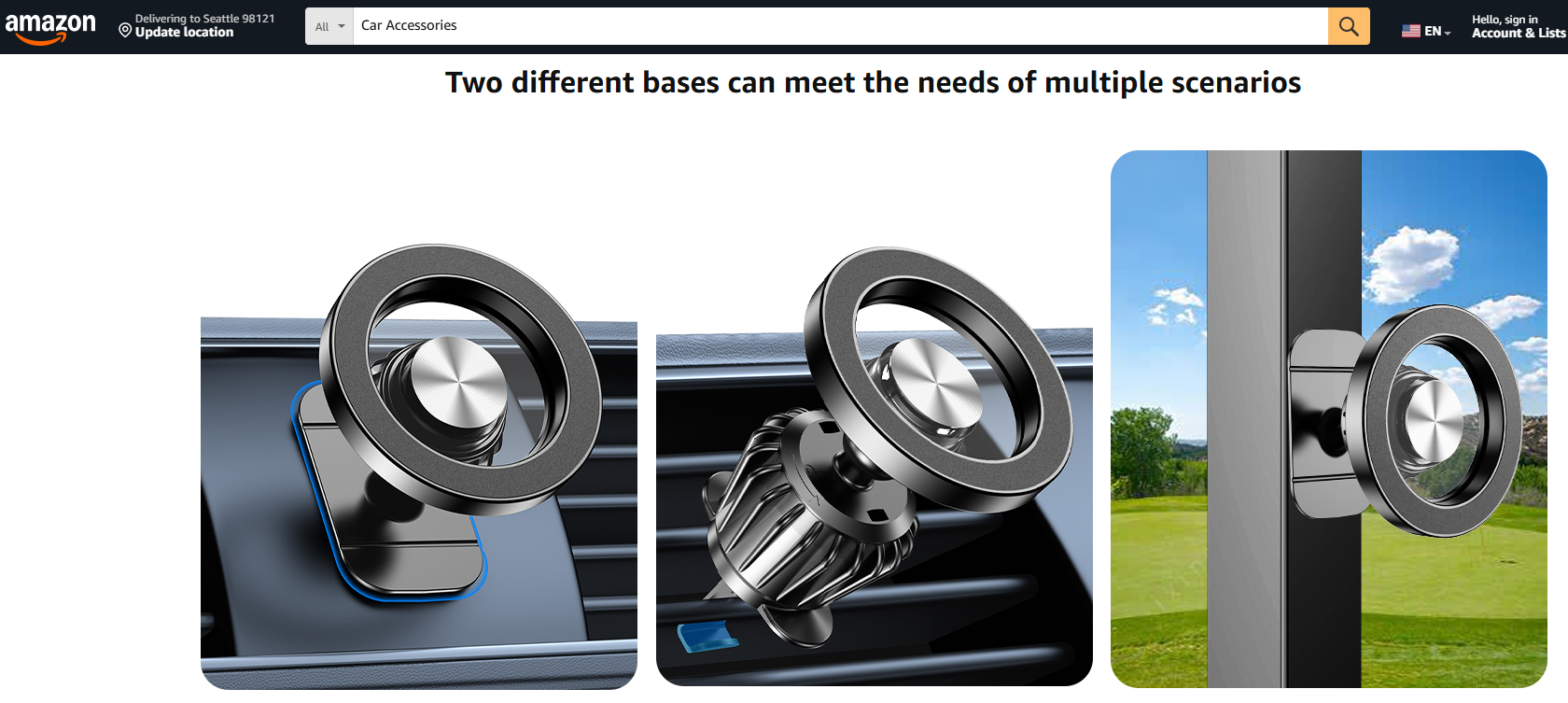
-
Eco-Friendly Bath Products (Bamboo Bath Accessories) – Many consumers actively seek eco-friendly versions of everyday products. This trend opens opportunities like bamboo bath accessories: think bamboo toothbrushes, biodegradable loofahs, or eco-friendly bath sponges. An eco-friendly bath sponge (perhaps made from natural plant fiber) reportedly sells about 1,000 units per month, indicating solid demand as people swap plastic sponges for greener options. Beginners can tap into this by selling a set of bamboo toothbrushes (usually come in multi-packs for the family) or a bath accessory kit (including things like a bamboo soap dish, brush, and loofah). Not only are these items lightweight and inexpensive, but they also allow you to tell a brand story about sustainability – which can attract organic, loyal customers. Be sure to highlight the eco aspects in the listing (recyclable packaging, compostable materials). Reason to sell: Rising demand for sustainable products, relatively simple to source (plenty of suppliers make bamboo goods), and you contribute to a positive cause which often translates into strong customer reviews and brand goodwill.
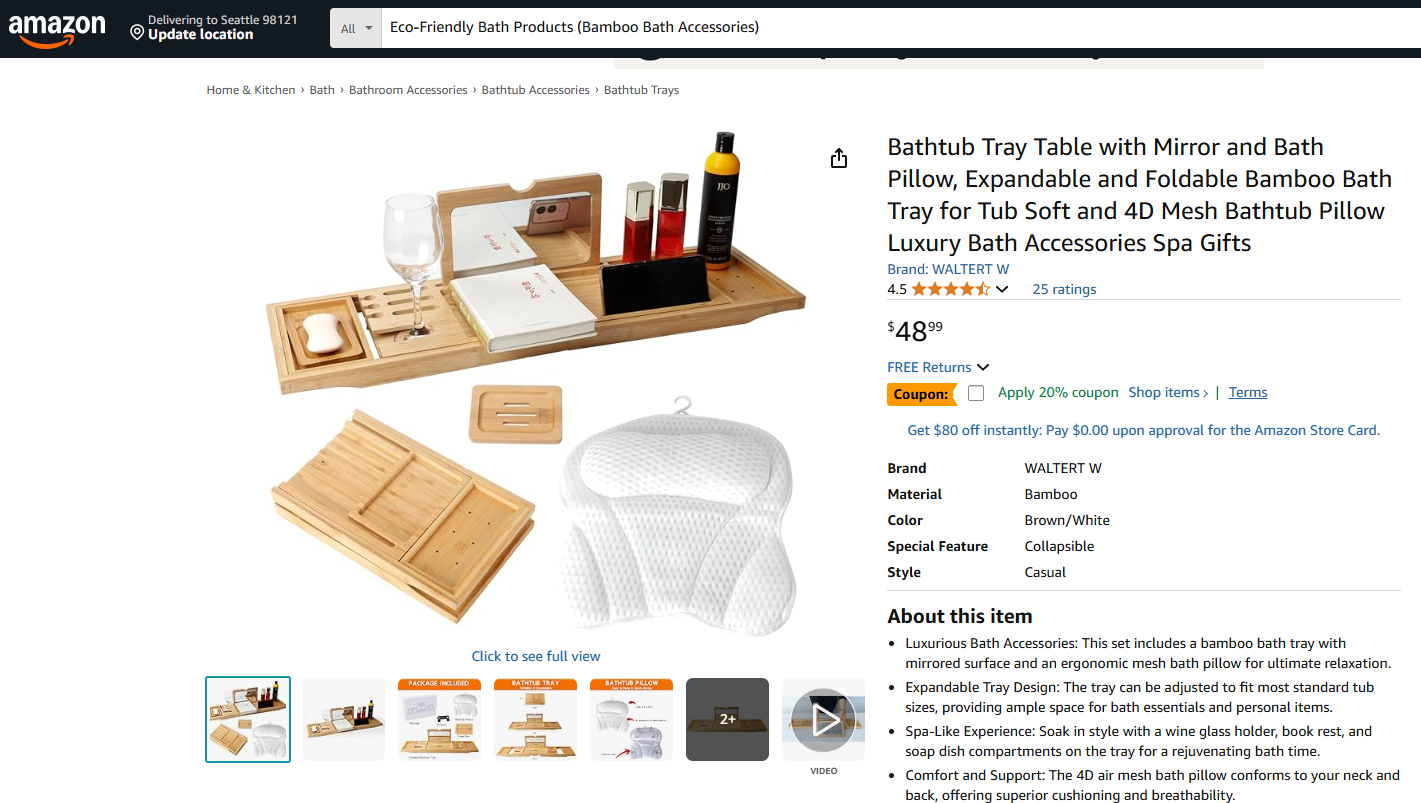
-
Laptop Stands and Desk Accessories – With remote and hybrid work now common, home office accessories stay in high demand. A great product for new sellers is a portable laptop stand or an adjustable monitor stand. These items cater to work-from-home ergonomics – people want to improve their desk setup for comfort and productivity. Laptop stands (foldable aluminum ones, for example) are popular due to their portability and health benefits (raising the screen to eye level). On Amazon, numerous listings for laptop stands do very well, and there’s room to come in with a feature tweak (maybe a stand with built-in fans for cooling, or one that doubles as a riser for tablets and books). Also consider cable organizers, desk pad blotters, or monitor stand risers with drawers – all are sought-after by the work-from-home crowd. These products are straightforward, with no electronics, and appeal to a broad base of professionals and students. Reason to sell: The shift to home offices is permanent for many, meaning ongoing demand. These items aren’t seasonal and often buyers purchase multiple accessories to optimize their space. A beginner can start with one accessory and later expand to a whole suite of office products, building a brand in the niche.
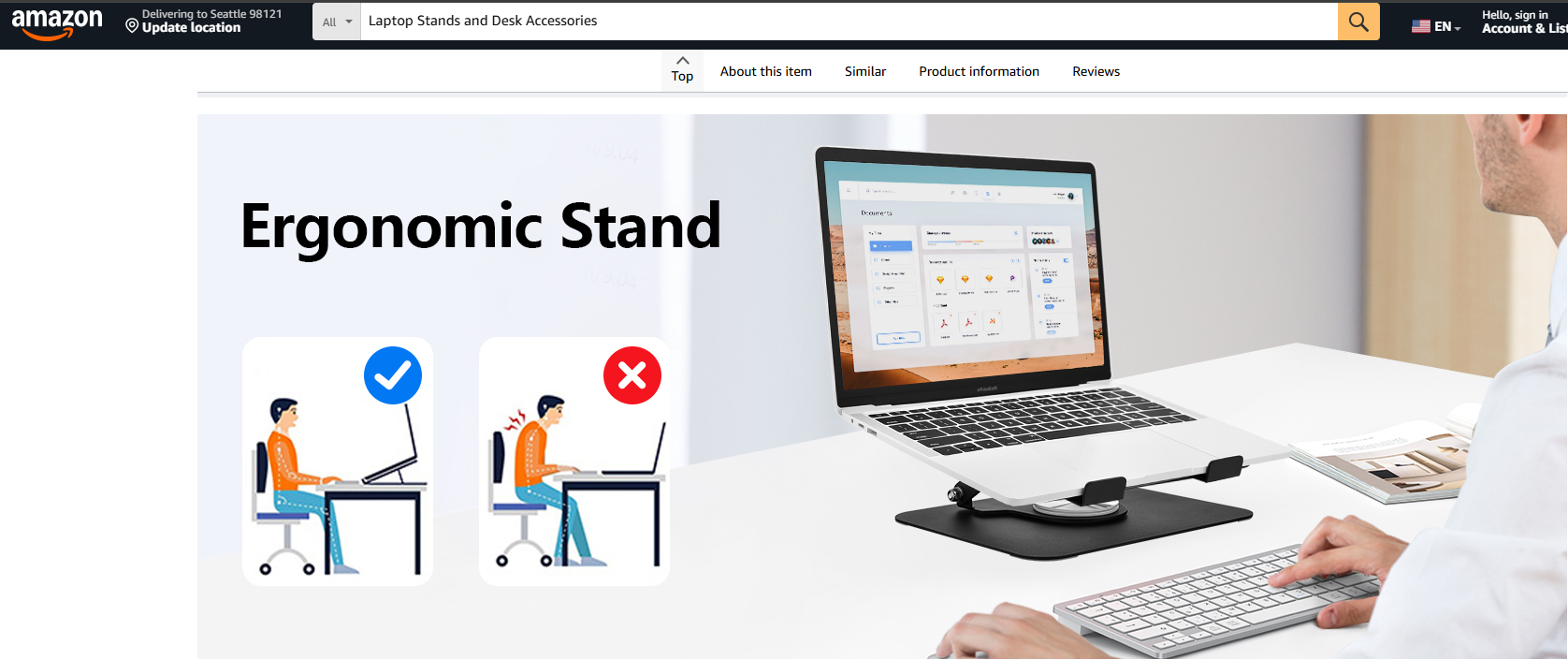
-
Magnetic Refrigerator Calendar/Whiteboard – Lastly, a slightly quirky but consistently well-selling item: magnetic fridge organizers, such as a dry erase whiteboard or weekly calendar that sticks to the refrigerator door. Thousands of families use these to plan meals, schedules, or grocery lists. It’s a simple product: basically a flexible magnetic sheet with a special coating to write on. Yet, it fulfills a common need (household organization) and is an impulse-friendly price (usually $15-$20). New sellers can easily source these and perhaps bundle with markers and an eraser. There’s room for creativity in design (colorful planners, or a combo that includes a magnetic notepad for shopping lists). Since it’s flat and lightweight, FBA fees are minimal. Pay attention to the quality of the whiteboard surface (so that it erases cleanly and can be rewritten many times). Reason to sell: Universally useful product, low manufacturing complexity, and often bought as a gift (e.g. a housewarming present), giving you multiple angles to market it.
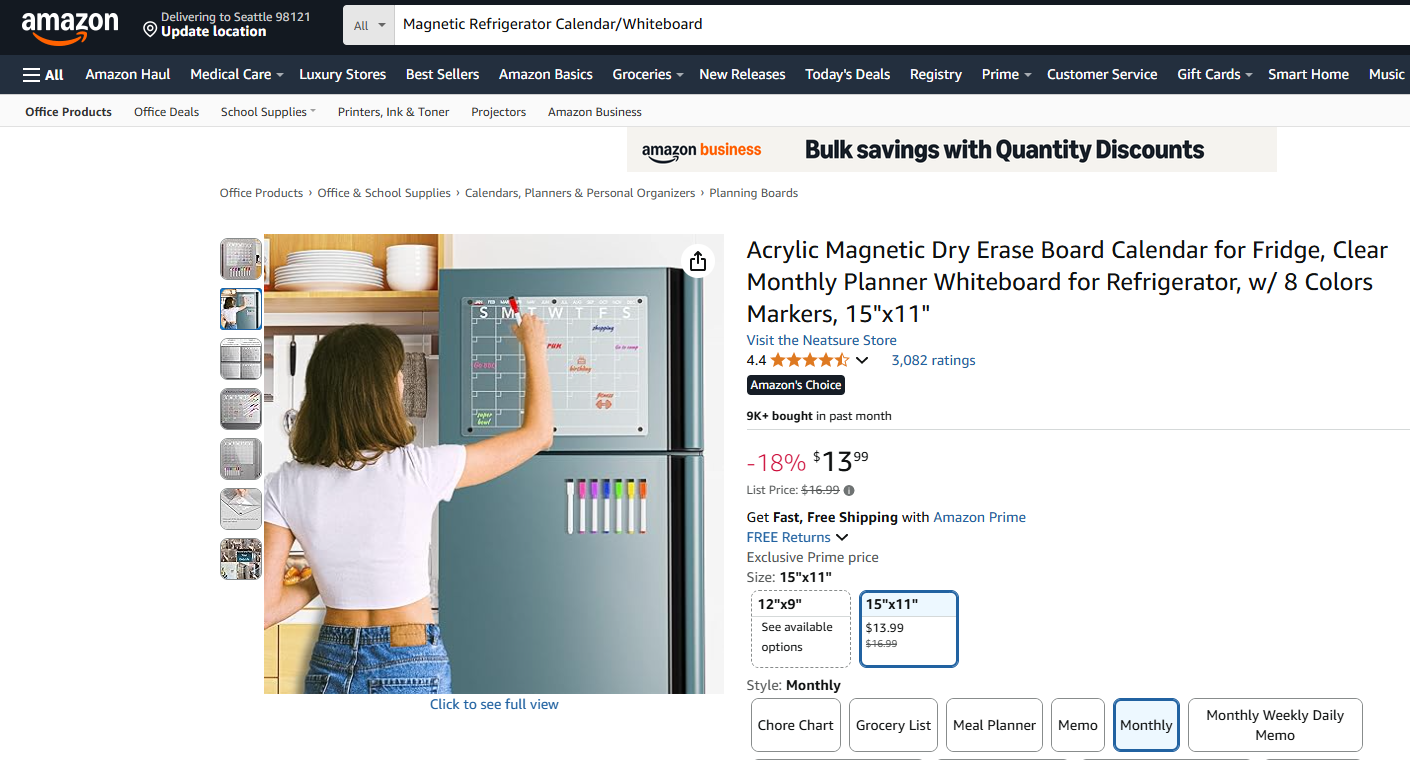
Each of these 15 product ideas has a strong market in 2025 and is suitable for beginners in terms of cost, complexity, and demand. Remember, when selecting a product, always do thorough research: check the current top sellers in that niche, read customer reviews to identify pain points, and ensure you can source a product that offers a small improvement or unique angle. The most successful new sellers often take a popular product and tweak it (better quality, bundling, niche targeting) to carve out their share of the market. Also verify that the product isn’t in a restricted category or violating any IP (avoid anything with trademarked logos/characters, as we’ll discuss in a later section about infringements). Start with one product, launch it well, and you’ll be on your way to joining those Amazon success statistics!
5 Best Low-Cost Products Under $10 for Beginners (2025)
If you’re starting with a very small budget or want to test the waters, selling low-cost items (under $10) can be a smart strategy. These products won’t have huge profit per unit, but they tend to sell in high volumes and can attract impulse buyers. Amazon even has a “Low-Price FBA” fee tier to encourage inexpensive products (after retiring the Small & Light program), making it more feasible to sell sub-$10 items with FBA. Here are 5 of the best cheap products to consider:
1.Digital Meat Thermometer (~$9-10): A kitchen gadget that almost every household could use, digital meat thermometers often sell for around $10 and are top-sellers especially during BBQ season and holidays. They allow people to cook meat to perfection without breaking the bank. According to a 2025 market analysis, a popular Alpha Grillers meat thermometer was listed at $9.99 and ranks among hot-selling kitchen items. For a new seller, these thermometers can be sourced cheaply (there are simple pen-style ones). They’re lightweight and small, keeping fulfillment costs low. Ensure any you sell are calibrated accurately and have an instant-read feature. You might bundle it with a little temperature guide magnet to make your offer stand out. Despite the low price, the demand is high (every grilling enthusiast or home cook is a potential customer), so volume can make up for the thinner margins.
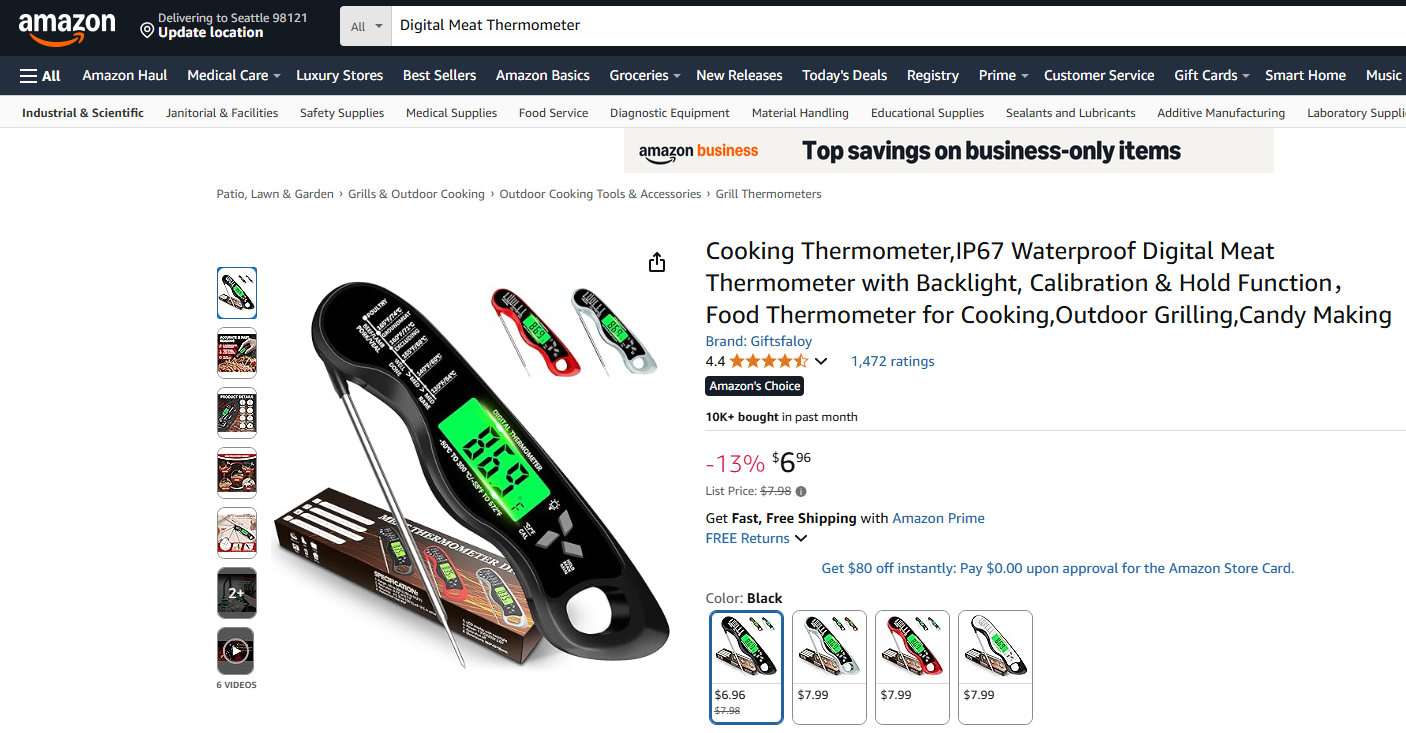
2.Silicone Ice Cube Trays (~$8): This is a great low-cost item that appeals to a broad audience. Fun silicone ice cube molds – be it for regular cubes, large whiskey spheres, or novelty shapes – frequently cost well under $10 and sell in large quantities. Shoppers buy them for home use or as small gifts. Being silicone, they’re cheap to manufacture and virtually unbreakable (low risk of returns). On Amazon, you’ll find ice tray sets (often 2-pack or 4-pack) around that price point performing well. As a beginner, you could introduce a mold with a unique shape (e.g., diamond-shaped ice for cocktail lovers, or cute animal-shaped cubes for kids’ drinks). The competition exists but new designs or better quality (food-grade silicone that doesn’t impart odor) can carve a niche. It’s also an easy product to add variations to (different colors or shapes) which can increase your listing’s visibility.
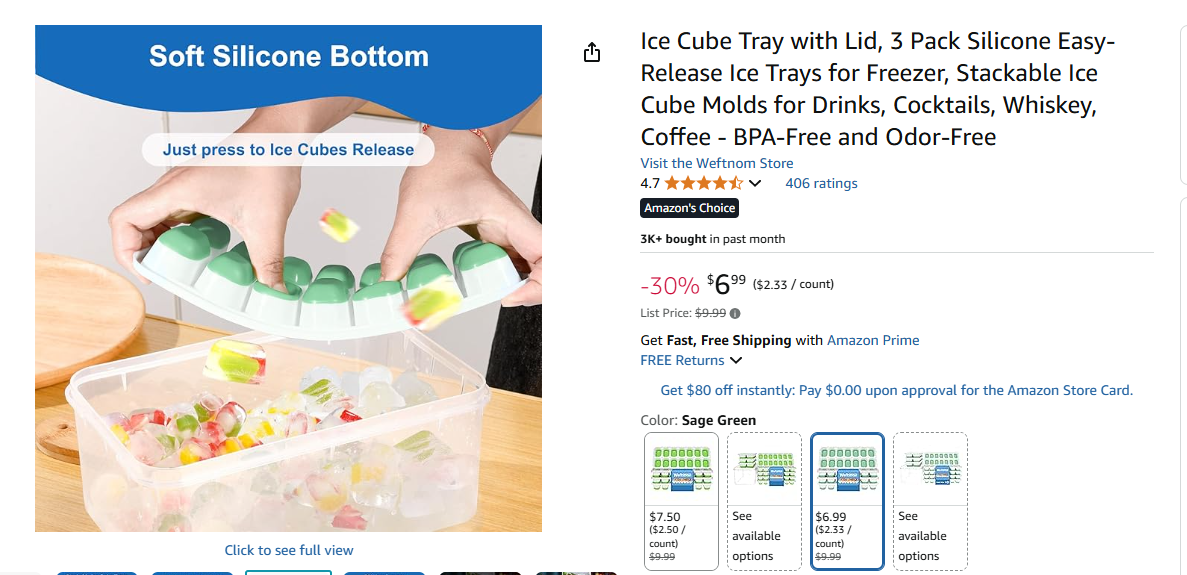
3.Stylus Pens for Touchscreens (~$7 for a 2-pack): With so many people using tablets and phones, a simple capacitive stylus pen is a popular accessory – and often costs only a few dollars. Selling stylus pens in a multi-pack (say, 2 or 3 pens in one set) for under $10 can attract frugal tech users, students, or artists with tablets. These are extremely low-cost to source (often < $0.50 each in bulk) and you don’t have to worry about electronic functionality (many styluses are just conductive rubber tips). You can differentiate by offering multiple colors in a pack or a stylus that doubles as a regular pen. Stylus sets frequently appear as Amazon’s choice in the cell phone accessories subcategory because they solve a need (precise touch input) at a very low price. They’re also add-on items people throw into their cart. Tip: Make sure to highlight device compatibility (works with iPad, Android, etc.) and consider bundling with cleaning cloths or pen loops to add value.
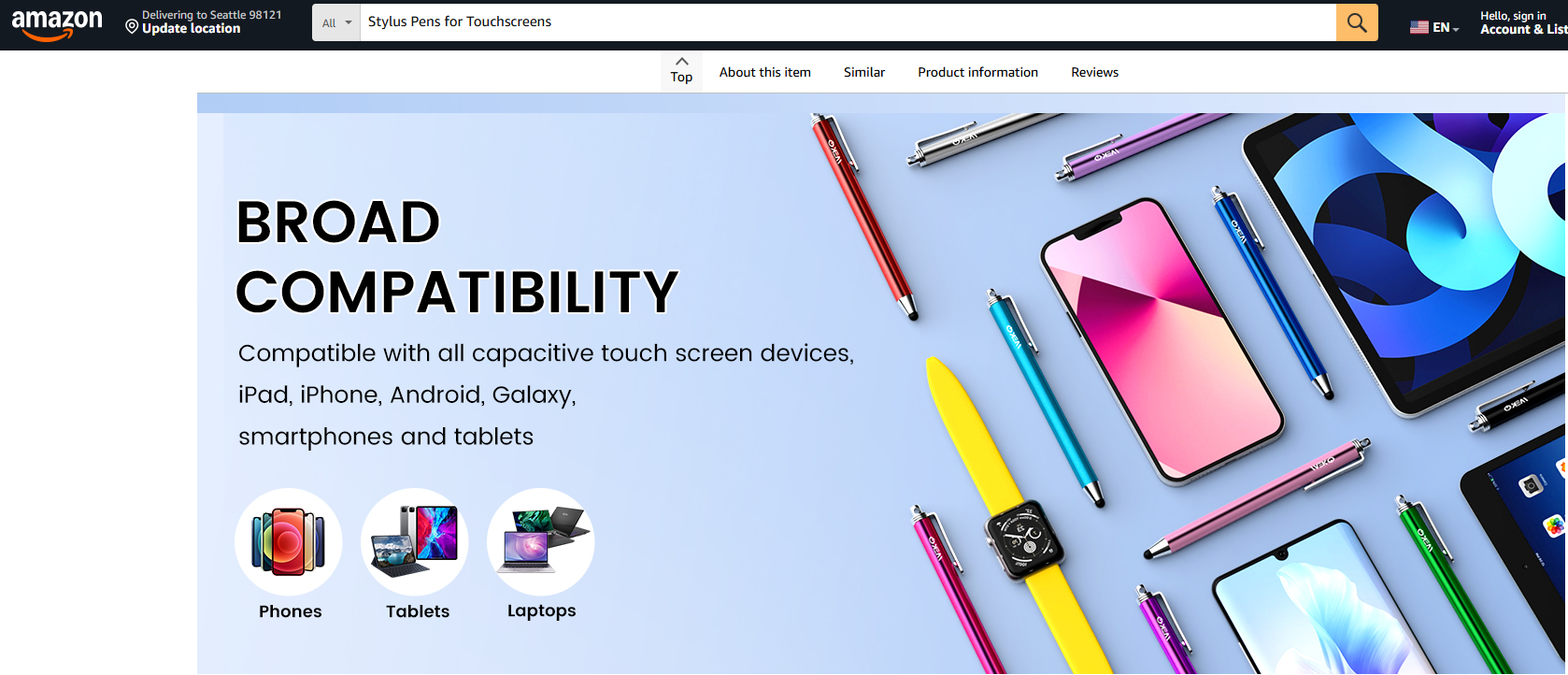
4.Reusable Metal Straws (~$6-8 for a set): Another eco-friendly choice, stainless steel drinking straws have been a hot low-cost item ever since the movement to reduce plastic straw waste gained momentum. They remain popular in 2025 as more consumers and even cities move away from disposables. A typical set might include 4-8 metal straws plus cleaning brushes, often priced under $10. The market is a bit saturated, but it’s still a great beginner product because the investment is minuscule and demand is sustained. You can make your set stand out with nice pouch packaging or including a silicone tip (for comfortable sipping). Some sets also include both straight and bent straws. Given that Amazon highlights sustainability, a well-presented reusable straw set can sell steadily. Ensure your stainless steel is food-grade 18/8 and won’t rust. This is the kind of product that appeals to environmentally conscious buyers who often share and recommend such items, possibly leading to organic traffic for your listing.
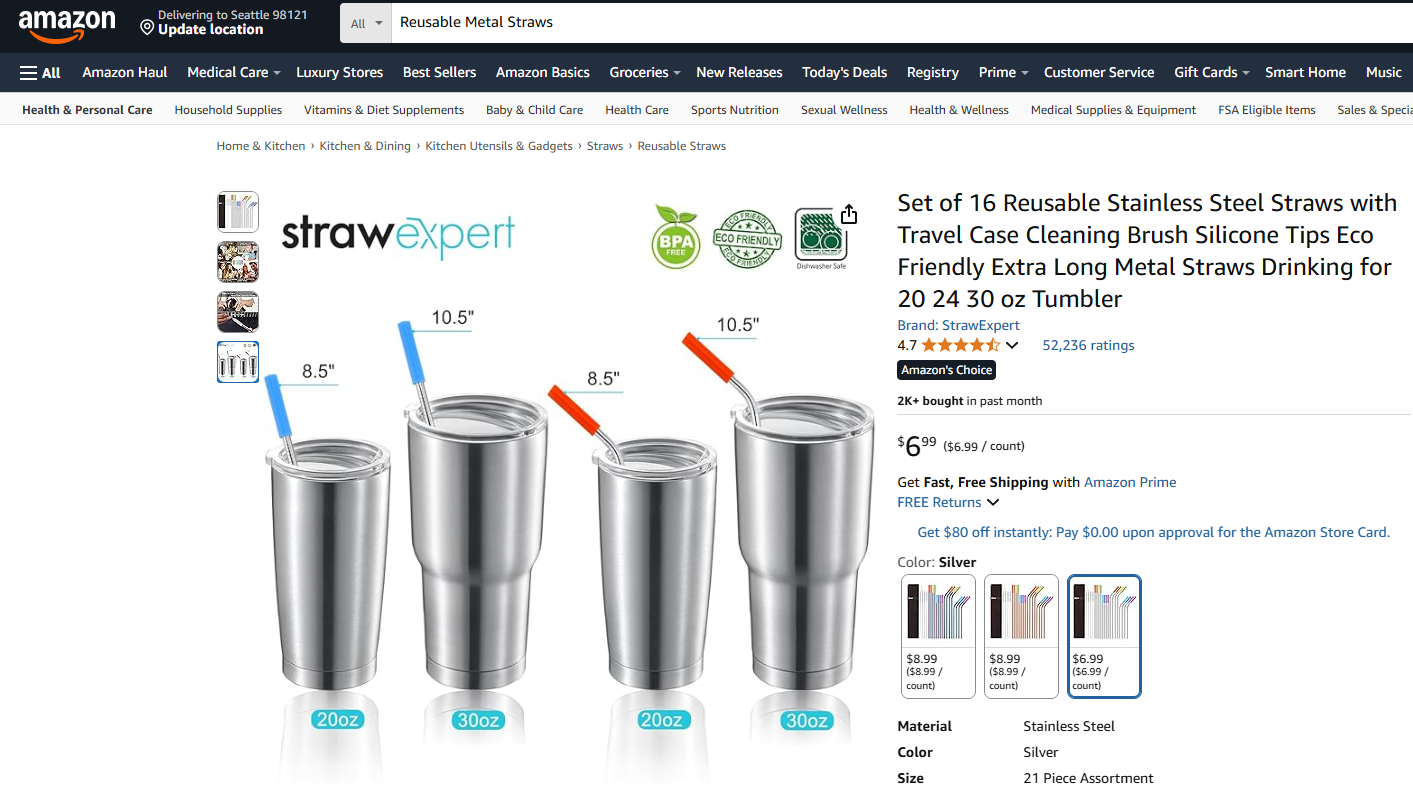
5.Portable Mini Fan (Handheld, ~$10): Small portable fans – whether handheld fans or those USB-powered desk fans – are excellent low-cost gadgets that see spikes in summer but also steady sales year-round (for office or travel use). They often sell around $8-$12. A Gaiatop mini portable fan was noted at about $8.99 and is a practical summer gadget for budget-conscious shoppers. As a new seller, a mini fan can be sourced from many electronics markets in Asia for a few dollars, and sold affordably. Despite the low price, customers love these for quick personal cooling. Pay attention to battery safety if it’s rechargeable (use certified batteries if possible). There are also necklace fans and other creative designs that do well. These fans are small enough to qualify for Amazon’s Low-Price FBA rates without huge fees. Marketing them with vibrant colors or including a stand/cradle can help your product stand out in this crowded space.
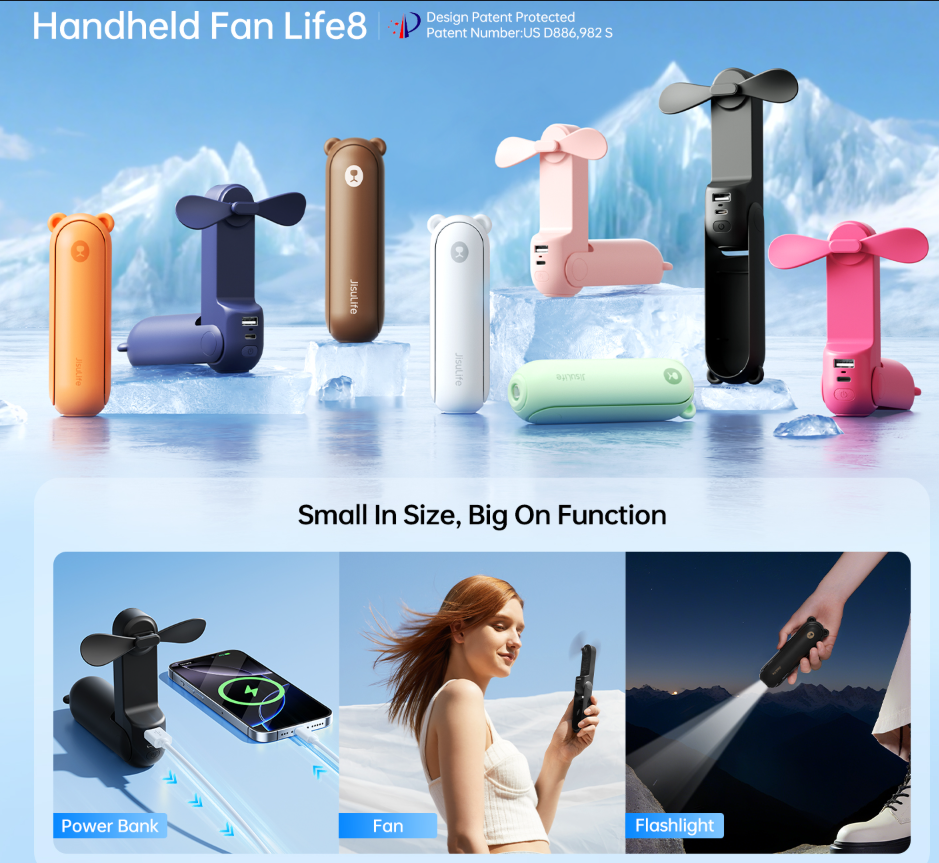
Selling items under $10 can indeed be profitable, but you must be mindful of Amazon fees relative to the price. As of 2025, Amazon’s referral fee for most categories is 15%, and FBA fulfillment fees for small, lightweight items might be around $2-$3. Low-price products benefit from Amazon’s fee adjustments (Low-Price FBA) which slightly reduce fulfillment fees for items under $10. For example, a $8 item might incur perhaps ~$1.20 referral fee + ~$2.50 FBA fee = $3.70 in Amazon fees. If your product cost is $1 and shipping to FBA $0.30, your total cost might be ~$5, leaving you about $3 profit per unit. That’s actually a decent margin (~37%) for a “cheap” product if you can sell at scale.
To succeed with low-cost products, focus on volume and reviews. These inexpensive items often sell hundreds of units a day if ranked well. Encourage satisfied buyers to leave positive feedback (many will, since the purchase is small and satisfying a simple need). Also, consider enrolling in the “Small and Light” (now Low-Price FBA) program officially if eligible, to get lower fulfillment fees. The bottom line: low-cost products can be a great entry point – they carry less risk (small upfront investment) and can teach you a lot about high-volume selling on Amazon.
Top 10 Ungated Amazon Products for New Sellers in 2025
One of the challenges for new Amazon sellers is navigating gated categories – areas that require special approval (for example, certain sub-categories in Beauty, Grocery, or Topicals). However, there are plenty of profitable products in ungated categories that you can start selling immediately without jumping through approval hoops. Here are 10 top ungated product ideas for 2025 that new sellers can jump on right away:
1. Books (Niche or Used Books): Books are a fully ungated category ideal for newbies. You could sell used books – sourcing them from thrift stores or your own shelf – or focus on new niche books (like self-published works in a particular genre). While margins on used books might be small, rare or niche topic books can command good prices. The advantage is you can list on existing Amazon product pages with zero gating. Example: College textbooks, if you can acquire them cheaply, resell well each semester. Reason it’s ungated: Books (except collectible or certain textbook categories) require no approval – Amazon wants as many book sellers as possible. Just be honest in condition descriptions to keep customers happy.
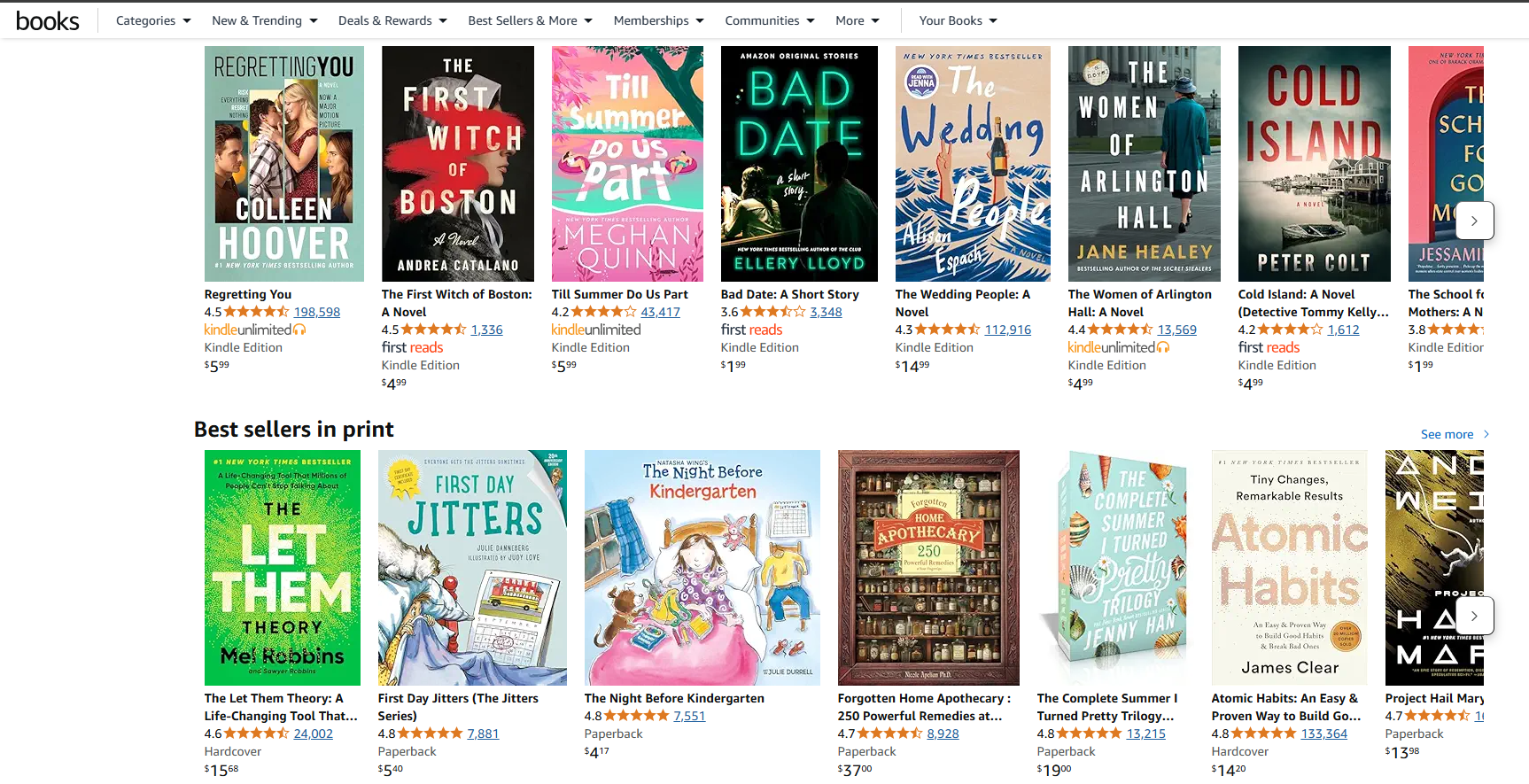
2. Home & Garden Tools: Basic home improvement tools or gardening accessories are ungated and always in demand. Think items like a multi-bit screwdriver set, a garden hose nozzle, or a plant hangers kit. These don’t require special approval and appeal to DIYers. For instance, a set of small gardening hand tools (trowel, cultivator, etc.) packaged together can be a great ungated product. The Home category covers these broadly and it’s open to all sellers. Bonus: such tools often have straightforward specs and low return rates.
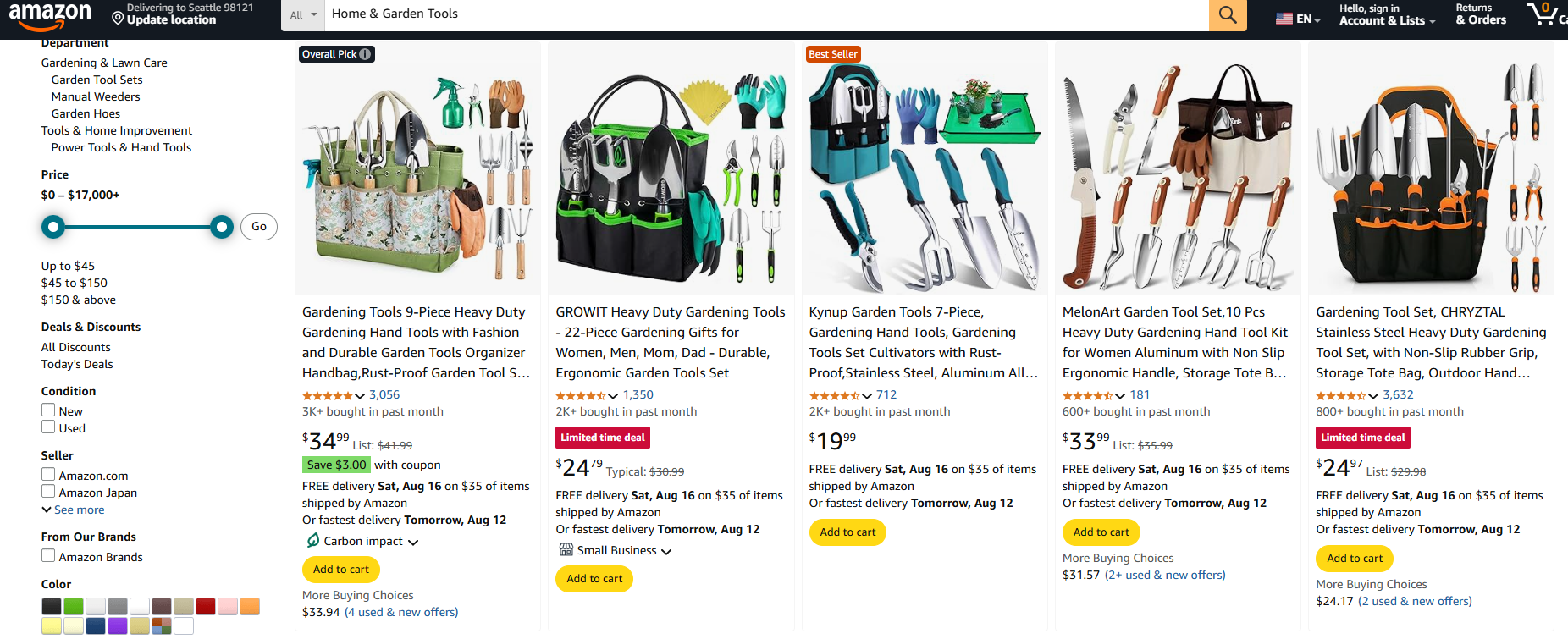
3. Cell Phone Accessories (non-branded): Amazon Device Accessories & Cell Phone Accessories are ungated, meaning you can sell things like phone chargers, charging cables, car chargers, phone rings/stands, etc., without special permission. Do avoid any branded counterfeit issues (e.g., don’t sell a fake “Apple” charger – but you can sell generic ones labeled for compatibility). A good idea is a 3-pack of 10ft durable lightning cables or wireless charging pads. These are ubiquitous items; competition exists but demand is gigantic. Ensure any electronics are certified for safety (UL certification for chargers, for example) because Amazon may ask for proof if issues arise, but category-wise, it’s open.

4. Kitchen & Dining Products: As mentioned earlier, Kitchen & Dining is open to new sellers. A specific ungated hit could be a manual kitchen gadget like a handheld spiralizer (for veggie noodles) or a garlic press. These types of gadgets feature prominently in Amazon’s Best Sellers and require no approvals. They’re simple mechanical items – no electronics or patents if you pick a common design – so you can dive in and start selling. Another example: silicone baking mats (for non-stick baking) are popular and ungated. Just avoid any that might border on food appliances which sometimes need certifications. Plain cooking tools are fair game.

5. Office Supplies (Planners, Notebooks): Office Products is an ungated category with lots of opportunity. 2025 planners, calendars, notebooks, pens, desk organizers – all open to sell. A beginner-friendly item might be a desk organizer caddy or a pack of gel pens. These don’t require approvals and cater to professionals, students, and teachers. For instance, a stylish acrylic pen holder or an ergonomic mouse pad can do well. These products often get organic traffic from people searching to spruce up their workspace or school supplies. Plus, they tend to be straightforward in terms of quality (just make sure a notebook’s binding is good or a pen doesn’t leak).
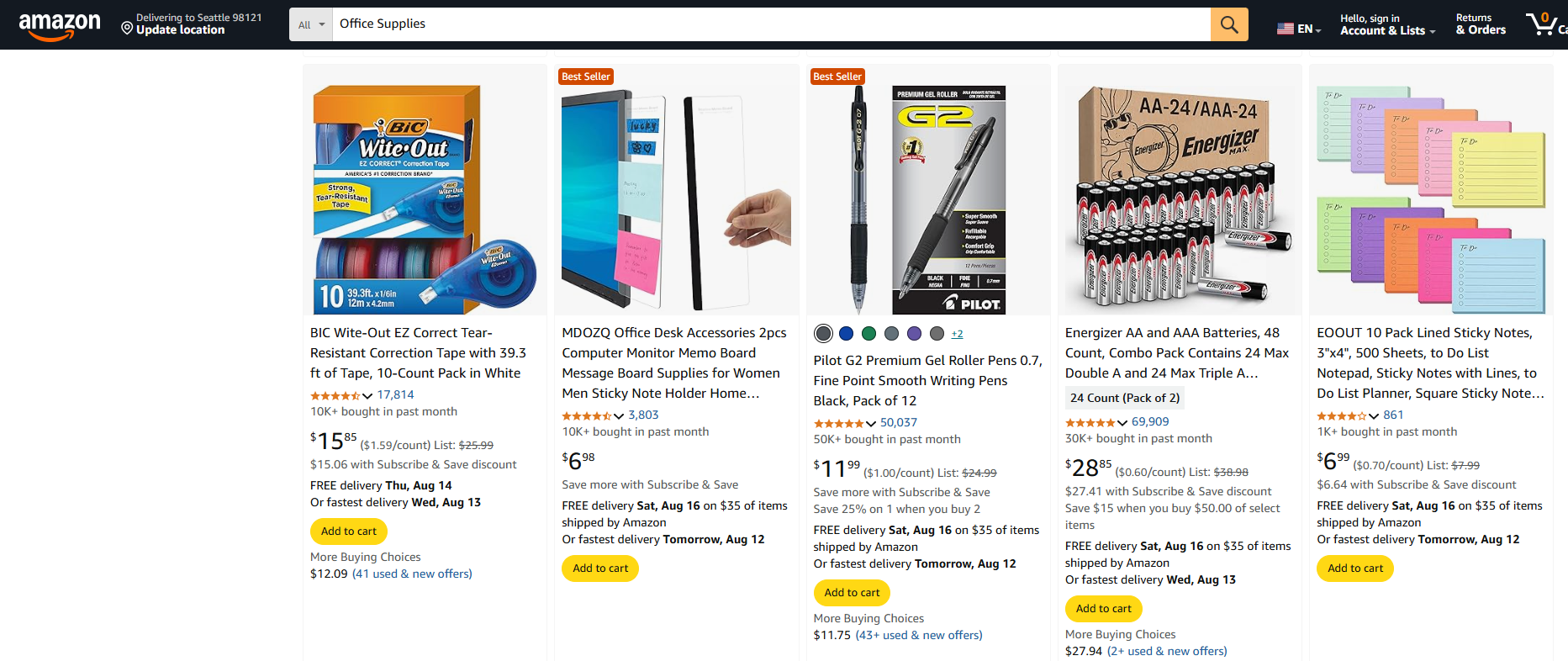
6. Sports Accessories: Many sports/outdoor products are ungated (except maybe certain protective gear categories). Items like water bottles, jump ropes, bicycle accessories, golf tees, yoga blocks etc., can be sold immediately. A timely example in 2025 is anything related to pickleball – a sport exploding in popularity. Selling a set of pickleball paddle grips or pickleball accessory kit would require no gating and meets a trending demand. Similarly, fitness accessories (think resistance bands, as earlier, or a gym bag) don’t need approvals. This category rides health trends and can bring free traffic as people search for workout gear upgrades.
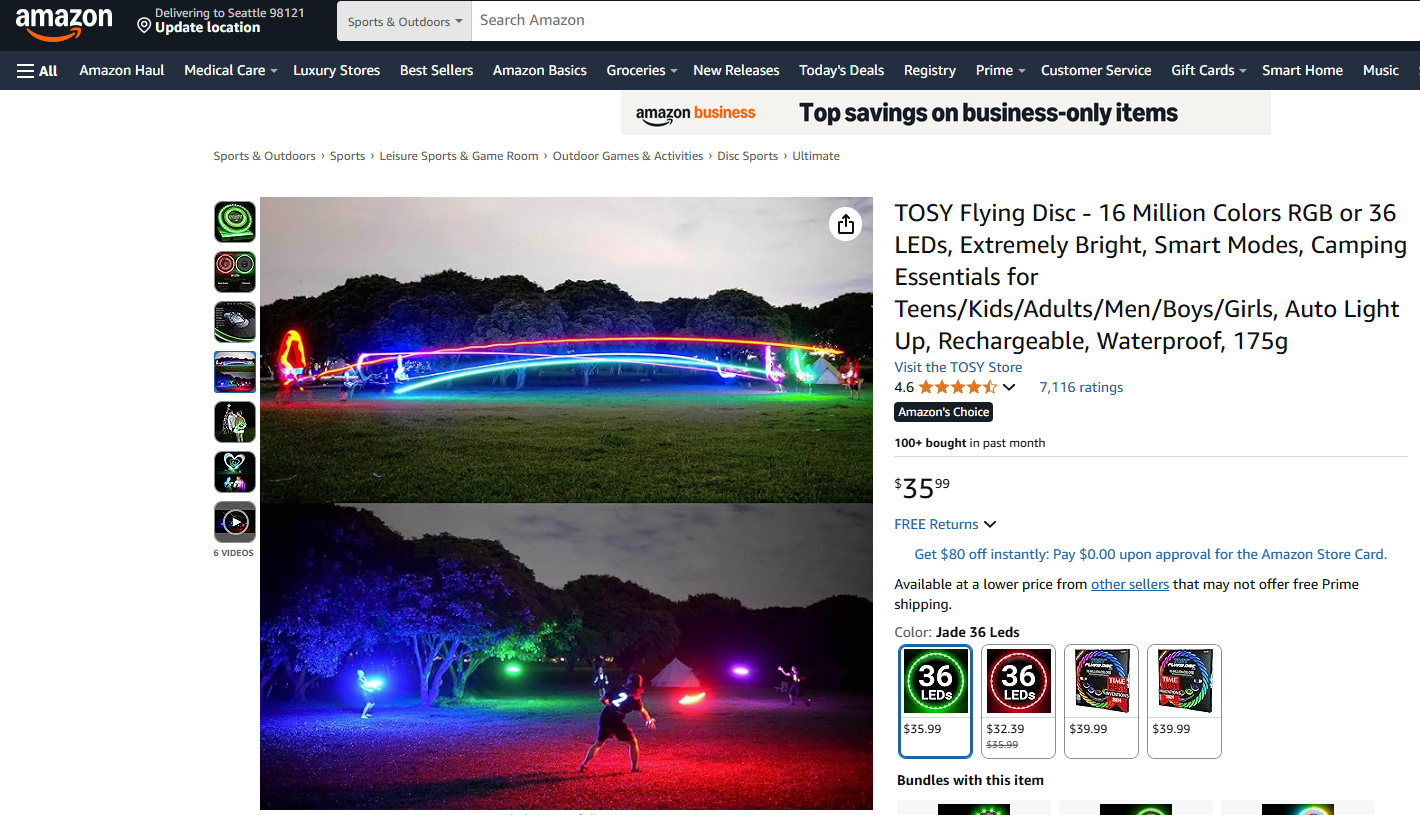
7. Arts & Crafts Supplies: Ungated and lucrative if you find the right niche. For example, painting canvases, sketchbooks, colored pencil sets, resin casting molds, and diamond painting kits are all craft supplies you can list freely. Crafting saw a boom and remains strong – people at home enjoy DIY art. A new seller could bundle a set of painting brushes of various sizes or a starter kit for a craft (like a candle making kit with wax and wicks – note: wax might fall under “Crafts” which is open). Check that any chemicals (like resin) are allowed; but most art tools and materials are open. These products often have communities around them (which you can target in marketing), and since they’re passion-driven purchases, customers eagerly leave reviews when they like the product.

8. Musical Instrument Accessories: While selling actual instruments can be tricky, musical accessories are ungated and have steady demand. Examples: guitar picks, guitar straps, instrument stands, drumsticks, microphone pop filters, violin rosin. These are small add-ons that musicians constantly need. If you have any knowledge in this area, it’s a great niche because you understand what makes a quality accessory. Even if not, simple items like a universal guitar hanger or a pack of mixed guitar picks (in cool designs) are easy entry points – no approvals needed. Music gear buyers often search Amazon first for these accessories due to convenience, so with the right keywords, you can tap into organic search volume.
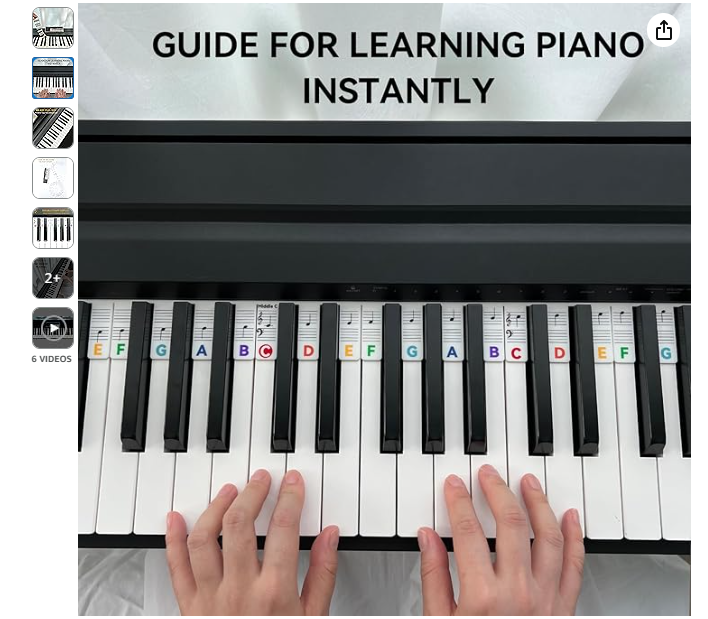
9. Generic Fashion Jewelry: High-end jewelry is gated, but costume jewelry (non-precious metals/stones) is generally open to sellers. This means you can list things like a set of bohemian style earrings, stackable fashion rings, or pendant necklaces freely. Jewelry is a crowded space, but also a huge market. Beginners succeed by targeting specific styles or trends – for instance, a charm bracelet kit that went viral on TikTok or minimalist geometric earrings. Keep the price low (many customers impulse-buy jewelry under $15). Quality is key to avoid returns (no one likes a necklace that breaks immediately or irritates skin – opt for hypoallergenic coatings). The beauty here is you can get very creative with branding and packaging, making your jewelry a nice gift option (which can get you more visibility around holidays).

10. Automotive Basic Parts: While many automotive parts are gated or require sourcing from authorized distributors, some generic parts are open. For example, windshield wiper blades for various car models can be sold ungated (there’s huge demand and many generic brands succeed). Also, things like car fuses, universal car battery terminals, floor mats, or seat gap fillers don’t need special approval. You must avoid trademarked car brand logos, but generic “fits most cars” products are fine. If you have some automotive know-how or access to wholesale, selling simple car maintenance parts can be lucrative (car owners often check Amazon for cheaper options than the dealership). Just double-check Amazon’s latest auto category policies to ensure the specific part is not restricted – but generally, basic accessories and maintenance items are open.

These ungated products give new sellers a “safe” path to start selling without delays for category approval. Always verify on Seller Central if any specific ASIN or subcategory has restrictions, but the categories and examples above are historically open. By focusing on ungated products, you can launch faster and start generating sales and reviews, which is crucial in the early stage. Additionally, sticking to ungated items helps avoid the frustration of account health warnings for selling in unapproved categories.
Pro Tip: Even in ungated categories, be mindful of intellectual property. For instance, selling a generic toy car is fine, but selling a toy car with a Disney character print would violate IP rights. Or listing a cell phone case with the word “Nintendo” in it could get you in trouble if you’re not careful (use phrases like “compatible with Nintendo Switch” rather than implying it’s official). We’ll talk more about specific IP-infringing products to avoid in the next section.
By choosing one of these top ungated product types, you set yourself up for a smoother start on Amazon. You can focus on marketing and customer service rather than paperwork for approvals. As you gain experience (and revenue), you might later pursue gated categories (like Grocery or top Beauty brands) – but many sellers find ample success sticking to ungated niches throughout their journey.
Find High-Demand Products with Helium 10 in 2025
Finding a winning product is like finding a needle in a haystack – but fortunately, tools like Helium 10 make product research much easier for Amazon sellers. Helium 10 is a popular suite of Amazon seller tools that can help you identify high-demand, low-competition products. In 2025, using data-driven research is practically a must for success on Amazon, and Helium 10 remains one of the best options. Here’s how beginners can leverage Helium 10 to find high-demand product opportunities step by step:
-
Step 1: Use Black Box (Product Research Database): Helium 10’s Black Box is a powerful product discovery tool. Think of it as a search engine that filters Amazon for products meeting your criteria. Begin by setting smart filters to narrow down to potential winners:
-
Choose a category you’re interested in (e.g., Home & Kitchen, Sports, Pets).
-
Set a monthly revenue minimum (to ensure demand). For instance, you might filter for products making at least $5,000/month in revenue – a sign of demand.
-
Set a price range (maybe $15 to $50, which often balances affordability with profit).
-
Set a review count maximum (e.g., < 100 reviews) to find niches where competition isn’t too entrenched.
-
You can also filter by monthly unit sales, weight, or whether FBA is used, etc., depending on your goals.
Black Box will then output a list of products or keywords that match. For example, you might discover that within Home & Kitchen, a certain type of gilding wax for furniture is selling 800 units per month with relatively few reviews – indicating a potentially unsaturated demand. This is exactly how one of the AMZScout case studies found gilding wax as a high-demand product. Use these results as leads to investigate further.
-
-
Step 2: Analyze Keywords for Demand (Magnet & Cerebro): High demand on Amazon is often evidenced by high search volume keywords. Helium 10’s Magnet (for keyword research) and Cerebro (to reverse-engineer competitors’ keywords) are gold mines. If you have a product idea from Black Box, run related keywords through Magnet to see how many people search for them. For instance, if “spiralizer for veggies” has, say, 50,000 searches a month on Amazon, that’s significant demand. Cerebro can be used by taking a top competitor’s ASIN and seeing all the keywords they rank for – often revealing high-volume terms you might not have thought of. Helium 10 will show search volumes; look for keywords with thousands of searches and perhaps not too many competing products. A practical find might be something like the term “heatless curling set” – Helium 10’s tools could show it spiked in searches due to TikTok trends, signaling high demand for that product.
-
Step 3: Check Seasonality and Trends (Trendster or Amazon Trend data): Helium 10 has a tool called Trendster that visualizes a product’s sales rank history over time, helping you spot seasonality. Additionally, the Helium 10 Chrome Extension’s Xray tool can show historical sales and price trends for a listing. Use these to ensure the demand is consistent or growing, not just a fleeting fad (unless you are intentionally chasing a trend). For example, a portable humidifier might show rising demand in Q4 and Q1 (dry winter months). That’s fine if you know to stock up for those seasons. But if a product’s demand falls off a cliff in recent months, you might avoid it. High-demand products ideally have an upward trend or at least stable year-round interest.
-
Step 4: Evaluate Competition and Saturation: Helium 10’s Xray or Market Analysis will give metrics like the number of sellers, average reviews, and a “Success Score” or “Niche Score” for the product. As a beginner, look for niches where the top sellers have, say, < 200 reviews on average – it’s a sign you could rank without thousands of reviews. Helium 10 might even show a 10/10 reselling score for certain trending items (e.g., it gave pimple patches a 10/10 score, indicating a great product for sellers to consider). Also, check the actual listings of top products: Do they look poorly optimized (bad photos, bad copy)? That’s opportunity – you can do better and capture demand. Helium 10’s Listing Analyzer can help identify listing quality issues too.
-
Step 5: Calculate Profitability (Profitability Calculator): All the demand in the world won’t help if you can’t profit. Helium 10’s extension has a profit calculator, or you can plug numbers into Amazon’s FBA calculator. Input the product’s estimated price, your landed cost (cost of product + shipping to Amazon), and it will spit out fees and profit per unit. Aim for at least 25% profit margin and ideally $5+ profit per unit on a high-demand item. Helium 10 can auto-populate the Amazon fees for you. For instance, if Black Box shows a product averaging a $30 price, and you find you can source it for $8 per unit (including shipping) and fees are $10, then profit ~$12 which is healthy (40% margin). If the margins look thin, even if demand is high, consider a bundle or value addition that lets you price a bit higher, or move on to a more profitable idea. The tools can’t guess your exact sourcing cost, so do reach out to suppliers (via Alibaba or others) to get real quotes for a more accurate calculation.
Using Helium 10 in this way turns the daunting task of product research into a more systematic process. You’re effectively harnessing Amazon’s data to make decisions rather than guesswork. In 2025, the marketplace is competitive, but also more data-rich than ever – high-demand niches can be uncovered by anyone willing to dive into the numbers.
For example, a Helium 10 search might reveal that “remote scrolling ring” devices (a gadget to scroll on your phone hands-free) had a big jump in searches to ~10,000 queries in January. That indicates a demand spike, perhaps from a viral video or influencer. If competition is still low (maybe one or two sellers), that’s a high-demand, low-competition opportunity to consider.
Another scenario: Helium 10 could show that an established product like pimple patches is selling 4,000 units a day – enormous demand – but if the top listings have thousands of reviews, you might use Cerebro to identify a related but less competitive keyword, like “acne dots for sensitive skin” where you could differentiate. Helium 10 essentially helps you spot these gaps.
Tips for Beginners Using Helium 10:
-
Take advantage of Helium 10’s tutorials and training content. They have a free beginners guide and plenty of videos (they want you to succeed so you remain a customer). In 2025, Helium 10’s blog and videos frequently share tips on using their tools to find products – utilize those.
-
Use the Chrome Extension Xray on Amazon search pages. For any product idea, search it on Amazon, then click the Helium 10 Xray button. It will display all the products on that page with sales estimates, revenue, reviews, etc. This snapshot is great for gauging if a keyword is worth pursuing. If you see many products with high revenue and not all with high reviews, that’s a good sign.
-
Black Box “Winning Product” filters: Helium 10 sometimes suggests using filters for “at least 300 sales/month, at most 50 reviews” to find low-competition winners. Play around with filters – you might discover odd but lucrative niches (for instance, someone discovered an overnight glow peel product in beauty had 76% margin and strong sales – data that came from using tools like Helium).
-
Keep an eye on Helium 10’s trending products feature. Helium 10 has a new tool (or integrated in Magnet/Cerebro) showing trending keywords and products. This can alert you to spikes in demand. For example, if “snail mucin serum” is trending because of K-beauty hype, you might consider sourcing snail mucin skincare or something complementary.
By systematically using Helium 10 for product research, you dramatically increase your chances of picking a high-demand product where customers are plentiful. It reduces guesswork and lets you approach Amazon more strategically, even as a beginner. Remember that Helium 10 and similar tools use estimates, so they’re a starting point – always double validate by looking at actual Amazon search results and perhaps small test orders in the market. But overall, data is your friend in 2025, and Helium 10 is like having an X-ray vision into Amazon’s demand patterns.
Avoid These 5 Copyright-Infringed Products on Amazon in 2025
When choosing products to sell, it’s not just about demand and profit – you must also avoid products that could land you in legal hot water. Amazon is very strict about intellectual property (IP) violations, and new sellers sometimes unintentionally pick products that infringe copyrights, trademarks, or patents. To keep your seller account safe (and have peace of mind), steer clear of the following 5 types of products that are notorious for IP infringement issues in 2025:
1.Unlicensed Fan Merchandise (Characters & Logos): One of the biggest pitfalls is selling products featuring popular characters, logos, or names without permission. For example, Disney, Marvel, or Anime character merchandise – think hats with Mickey Mouse, phone cases with Marvel superheroes, or stickers of famous anime characters. Unless you have a license from the rights owner, selling these is a copyright and trademark violation. Amazon will swiftly remove such listings and potentially suspend your account. Even if you see others selling similar items, do not assume it’s allowed (they might be slipping through or could be shut down soon). Avoid anything with sports team logos, movie images, or game characters as well. Example to avoid: A beginner might think selling Baby Yoda coffee mugs is a cute idea – but “Baby Yoda” is a Disney-owned character (Star Wars), so without a license, that’s infringement. Instead, sell generic designs that don’t use protected characters. Rule of thumb: if it’s from a famous franchise or brand and you don’t have explicit permission, don’t sell it.
2.Counterfeit or Imitation Branded Products: This one might sound obvious – don’t sell fake Gucci bags or knock-off Nike shoes – but it extends to any item that bears someone else’s brand without authorization. New sellers sometimes source “branded” electronics or fashion from dubious suppliers. These could be counterfeit. Not only is selling counterfeits illegal, but Amazon has zero tolerance; it can lead to a permanent ban and even legal action. This also includes trying to resell genuine branded products if they’re restricted. For instance, Apple and Nike are gated brands – you generally can’t sell their products as a new seller without invoices and approval. Trying to slip in those products will trigger IP complaints. Also, don’t list your generic product in a way that confuses it with a brand. For example, if you sell headphones, don’t call them “Beats Headphones” in the title to attract searchers – that infringes the Beats by Dre trademark if your product isn’t actually Beats. Avoid any listing that could make a customer think they’re buying an official branded item when they’re not. Stick to your own branding or clearly generic terms.
3.Using Trademarked Words in Product Titles/Descriptions: Some everyday words are actually trademarked brand names, and using them can get your listing flagged. Common examples: “ONESIE” (as in infant bodysuit) is a trademark of Gerber, “VELCRO” (hook and loop fastener) is a trademark of Velcro Companies. New sellers might innocently describe a baby outfit as a “cotton onesie” or a cable tie as “Velcro strap” – this can result in a trademark infringement complaint. Instead, use generic terms: say “baby bodysuit” instead of onesie, “hook & loop strap” instead of Velcro. Other examples: “Onesie,” “Onesies” (Gerber), “Bubble Wrap” (Sealed Air Corp), “Onkyo” (for audio jacks – trademarked), etc. Also, don’t use brand names of compatible devices in a misleading way. It’s okay to say “case for iPhone 14” because nominative use is allowed (describing compatibility), but not “iPhone 14 Case [YourBrand]” – implying it’s an Apple product. When in doubt, do a quick trademark search or consult Amazon’s restricted word list (there are community lists of hundreds of trademarked terms that sellers should avoid in listings). Keeping your listing language clean of others’ brand names will save you a lot of trouble.
4.DIY or Fan-Made Media (Copyrighted content): Selling media items like books, PDFs, music, or artwork that you didn’t create can be a violation if you don’t have rights. For example, some sellers think they can print and sell public domain books or Wikipedia content compiled – careful: many texts have embedded copyrights or require specific licenses. Also, avoid selling fan art or prints of famous images (like a poster of a celebrity or an artwork from a video game). Even if you drew it yourself, if it depicts a copyrighted character, it’s infringement. Another example: pirated software or game key codes – absolutely illegal and against Amazon policy. If you’re in the book or media space, stick to content you have full rights to (your own content or properly licensed). For print-on-demand, use only public domain or original images – don’t, say, sell t-shirts with the Olympic rings (trademarked) or famous quotes from movies (could be copyrighted). A common pitfall is music and movie-related merch: even a phrase like “May the Force be with you” on a mug is a Star Wars (Lucasfilm/Disney) IP violation. So, avoid any product that contains protected text or imagery from media.
5.Patented Product Knockoffs: This one is trickier to spot, but some products are patented inventions. If you copy that design, you could face a patent infringement claim. Beginners sometimes find a popular item and ask a factory to make a similar version. If that item had an active patent, the patent holder can file against you. Examples might include certain unique kitchen gadgets or novel toys. For instance, a few years back the fidget spinner was patented by someone – tons of sellers jumped on and later faced issues. In 2025, perhaps some hot-selling gadget (say a special kind of collapsible stool, or a patented bottle opener design) could be protected. How to avoid this? Do some due diligence: search the U.S. Patent and Trademark Office (USPTO) for patents related to the product name or ask the supplier if they know of any patent (sometimes they do, but don’t rely solely on them). Also, if a product listing says “Patent Pending” or such, steer away. If you’re private labeling a factory design, try to ensure it’s a generic one or sufficiently tweaked to avoid patent claims. In short, don’t directly rip off a unique product that someone likely protected legally. If an innovation is very successful and proprietary, it likely has a patent or at least design patent.
How to Stay Safe: Always err on the side of caution with IP. Amazon provides an Intellectual Property Policy and even a tool (Transparency program, Brand Registry) for brands to police their IP. That means brands are actively watching for violators. If you receive an IP complaint, it can harm your account health, and too many will get you suspended. So it’s best to avoid grey areas entirely. Here’s how:
-
Do your research: Before listing, search your product’s name or key features plus “patent” or check trademark databases for your branding and key terms.
-
Avoid famous names/likenesses: This includes not just fictional characters, but also real people. Selling a shirt with a famous singer’s face without permission = copyright of the photo and possibly right of publicity issues.
-
Source from reputable suppliers: They are less likely to offer you outright counterfeit branded items. If a supplier is offering “Branded” goods at cheap prices, big red flag.
-
Originality is key: If you design your own product or use original artwork, you control the IP and have nothing to fear. Put your energy there rather than chasing someone else’s IP.
By avoiding these five IP nightmare categories, you not only protect your Amazon account but also build a more sustainable business. Plenty of sellers have been shut down because they didn’t pay attention and listed a “forbidden” item. Don’t be that seller. It’s not worth the short-term sales to risk a permanent ban. Keep your catalog clean of infringing products, and you’ll earn Amazon’s trust (and that of your customers).
Finally, if you’re ever unsure about a product’s IP status, consult with an expert or skip it altogether. There are millions of products you can sell; it’s not worth it to gamble on one that might infringe. Stay creative, stay original, and you’ll do great!
6 Viral Products to Sell on Amazon in 2025
Sometimes success on Amazon can come from riding the wave of viral trends. Social media (especially TikTok, Instagram, and YouTube) frequently catapult certain products into sudden popularity. As a new seller, if you can catch a trend early (or offer a better version of a viral product), you can reap enormous sales. Here are 6 viral products in 2025 that have been making waves – these are hot sellers thanks to social media buzz:
1. Snail Mucin Serum (K-Beauty Skincare): Yes, you read that right – skincare products using snail mucin (extract from snails) have gone viral in the beauty world. TikTok influencers and K-beauty enthusiasts rave about snail mucin serum’s hydrating and skin-repairing properties. By 2025, this trend is massive, with the global snail mucin skincare market estimated around $500 million. Brands like COSRX have a famous snail mucin product, but the virality means there’s huge demand for similar serums, face masks, and creams. If you have connections to a cosmetic manufacturer, launching your own snail mucin serum could be lucrative – but note that formulating skincare has higher barriers (regulations, etc.) for beginners. Alternatively, you could sell accessories around it (like facial rollers that pair with serums). Regardless, snail mucin’s popularity demonstrates how a niche ingredient can explode via social media. It’s a reminder to keep an eye on beauty trends on TikTok – what’s hot there often translates to Amazon searches.
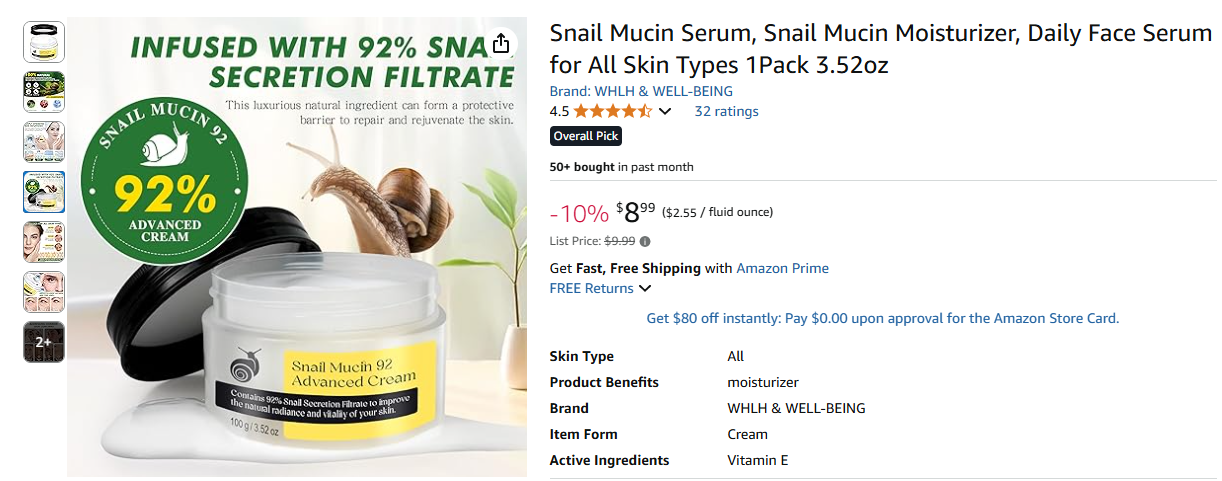
2. Heatless Hair Curling Set: This product became a TikTok sensation as more people looked for ways to curl hair without damaging heat tools. The heatless curling rod headband (basically a soft rod you wrap hair around and leave overnight) blew up with influencers showing dramatic before/after results. Demand for these sets – which usually include a fabric curling rod, scrunchies, and spray bottle – skyrocketed. The market for heatless hair curlers is growing at ~4.8% annually. If you jump on this trend, focus on quality of the satin material and comfortable design. Many consumers were dissatisfied with early cheap versions (fabric too rough, etc.), so a slightly improved version can outsell others. This is a classic case of a viral TikTok hack turning into an Amazon shopping frenzy. As a new seller, you could source this relatively easily (many suppliers now offer it). Ride the wave but also think long-term: perhaps position it as part of a “healthy hair” product line which could sustain after the initial viral boom.
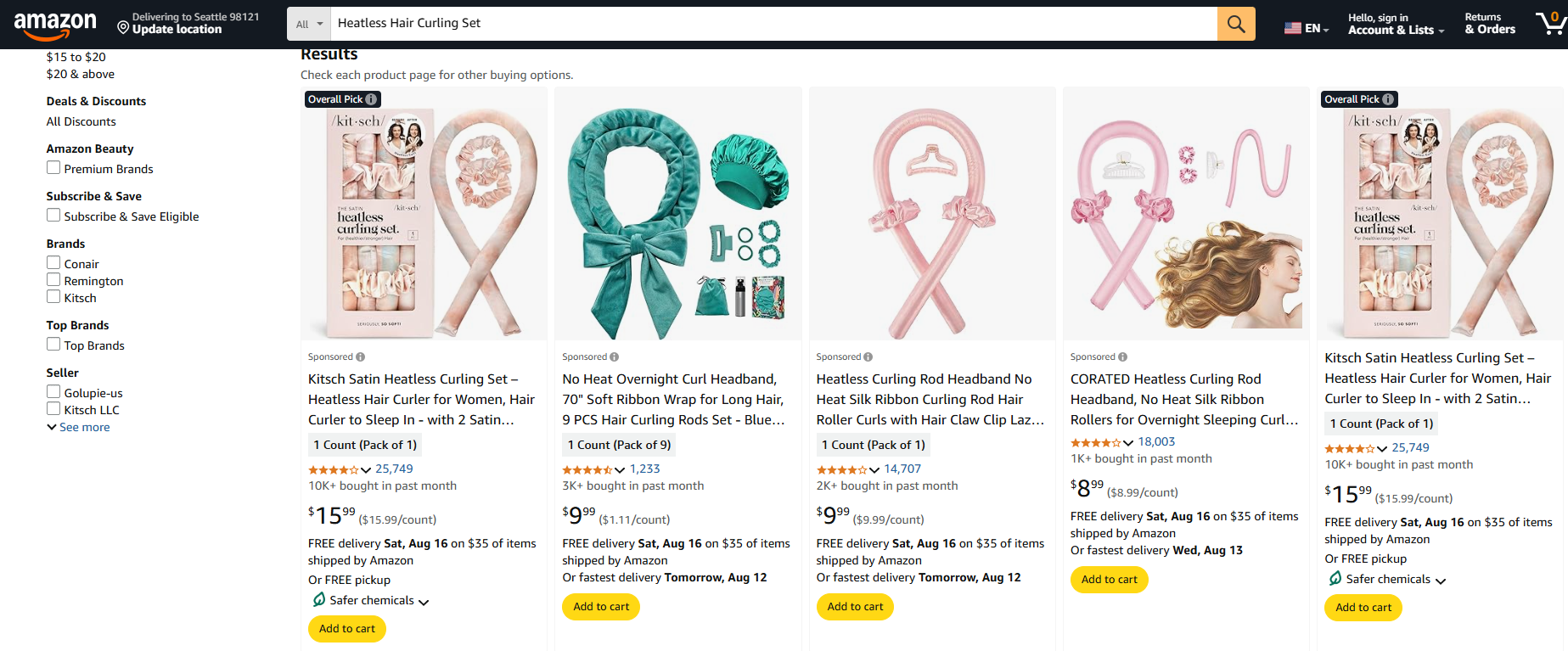
3. Standing Desk Treadmill (Walking Pad): With work-from-home continuing, another viral trend is the “walking pad” – a slim treadmill that fits under a standing desk, so people can walk while working. TikTok and YouTube are full of productivity enthusiasts showing their desk treadmill setups. These under-desk treadmills surged on social media as a way to stay active during long computer hours. Wired versions currently lead the market (65% share) but wireless models are quickly gaining popularity. This product is pricier and bigger than typical beginner fare, but the virality means demand is high. If jumping into this, a new seller might consider drop-shipping or partnering with a manufacturer, as it’s a bit heavy for direct FBA unless you have capital. However, lighter related items also trended (like desk bike pedals). The key is the concept of mixing work and exercise – that trend is viral and likely here to stay. Even if you don’t sell the treadmill itself, think accessories: e.g., anti-fatigue mats for standing desk users, or a laptop holder for treadmills – such tie-ins can piggyback on the trend.
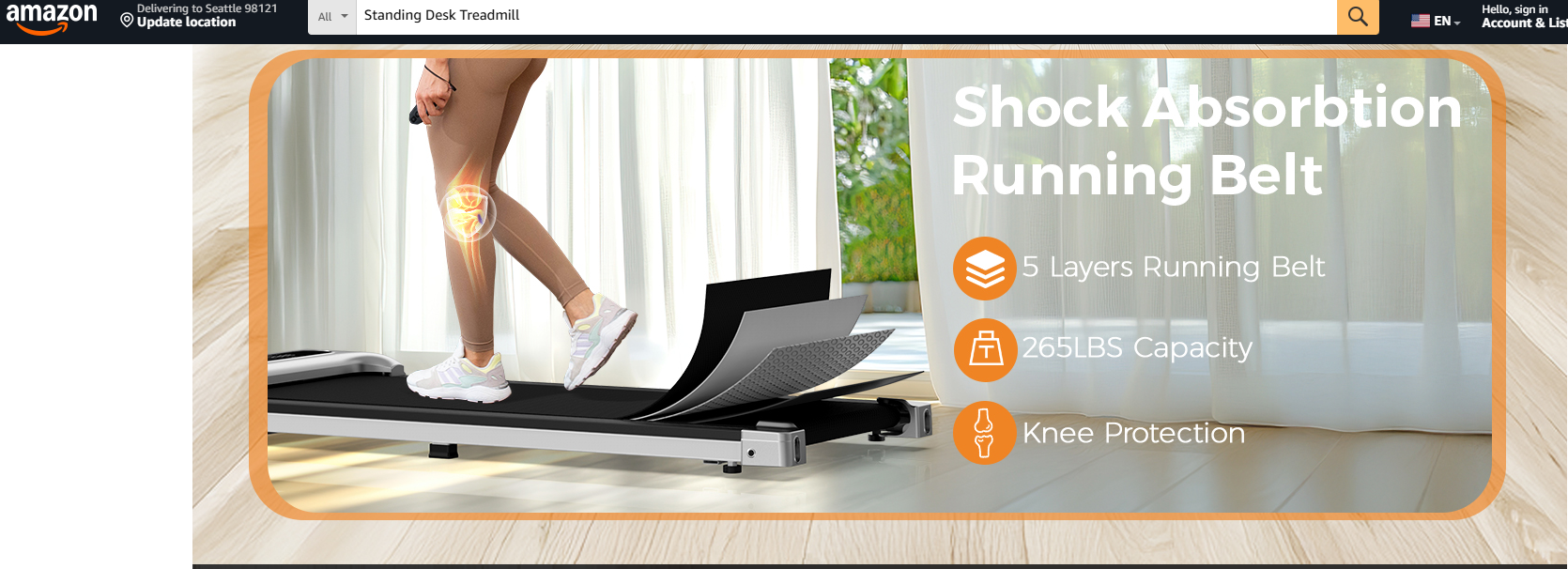
4. Small Portable Charger (Lipstick-Sized Power Bank): Portable gadget chargers have been around, but a specific type went viral: those small, lipstick-sized power banks that can give your phone a quick charge on the go. Influencers showcased how these tiny chargers fit in a purse and save the day when your phone’s dying. TikTok users love convenience, so this resonated. Regions like Asia-Pacific are leading innovation in charging tech, and one result is these high-capacity but miniaturized power banks. If selling these, you must ensure certifications (they contain batteries – need proper UN38.3, CE, etc.). Many Amazon sellers did well with cute designed mini chargers. Also, now we see magnetic wireless power banks (for iPhones with MagSafe) trending – small batteries that snap to the phone. Those too had viral moments. So a mini charger that’s both wired and wireless could be a hit. Virality tip: styling matters – some that went viral had aesthetic appeal (nice colors, sleek design) making them “Instagrammable” tech.
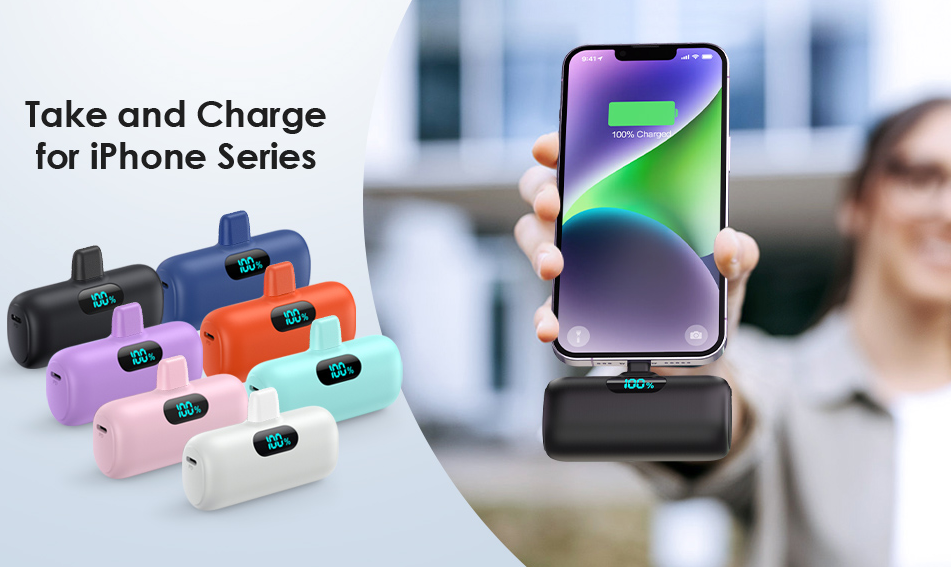
5. Remote Scrolling Ring: As mentioned earlier, a quirky gadget – a ring that you wear on your finger which can remotely scroll on your phone or TikTok feed via Bluetooth – became a hit among content creators. It sounds niche, but for avid social media consumers, it’s a novelty that went viral. Amazon search data showed a spike of nearly 10,000 monthly searches for “scrolling ring” in January after a successful ad campaign. This indicates a viral marketing push translated to demand. The scrolling ring is appealing for people who want to scroll TikTok without swiping, or presenters advancing slides etc. If you can source this kind of gadget, you might catch a trend early. Just be cautious: verify any patents (if it’s a novel device) as mentioned in pitfalls. Alternatively, keep an eye if the trend sustains or fizzles. But it’s a great example of how an unusual product can catch fire through social media in 2025’s landscape.
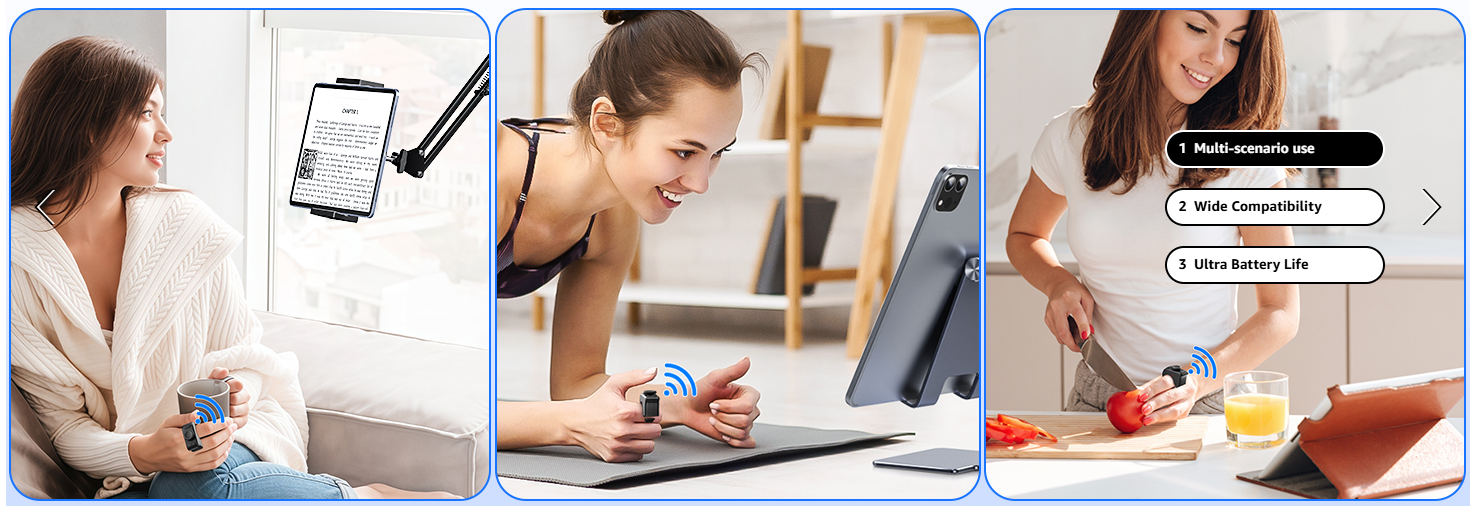
6. Jellyfish Lamp (LED Jellyfish Aquarium): On the home decor front, LED jellyfish lamps (tanks with fake glowing jellyfish that float around) became a TikTok-famous aesthetic item. People love them for a calming vibe or Zoom background. Cosmo’s list of TikTok-viral deals in 2025 even mentions jellyfish lamps as a must-have. They’re relatively low-tech – just water, some artificial jellyfish, and color-changing LED lights. For new sellers, this is a moderate risk item (needs secure packaging, some quality to ensure jellyfish move realistically). But the viral appeal is strong: it’s an eye-catching product that taps into the “oddly satisfying” visual trend. It also crosses into multiple audiences: kids love it as a nightlight, adults use it for stress relief. If you list one, use video on your Amazon listing to show the mesmerizing movement (important for conversion). Since it’s trending, search volume on Amazon is likely high for “jellyfish lamp”, meaning organic traffic is available if you rank.
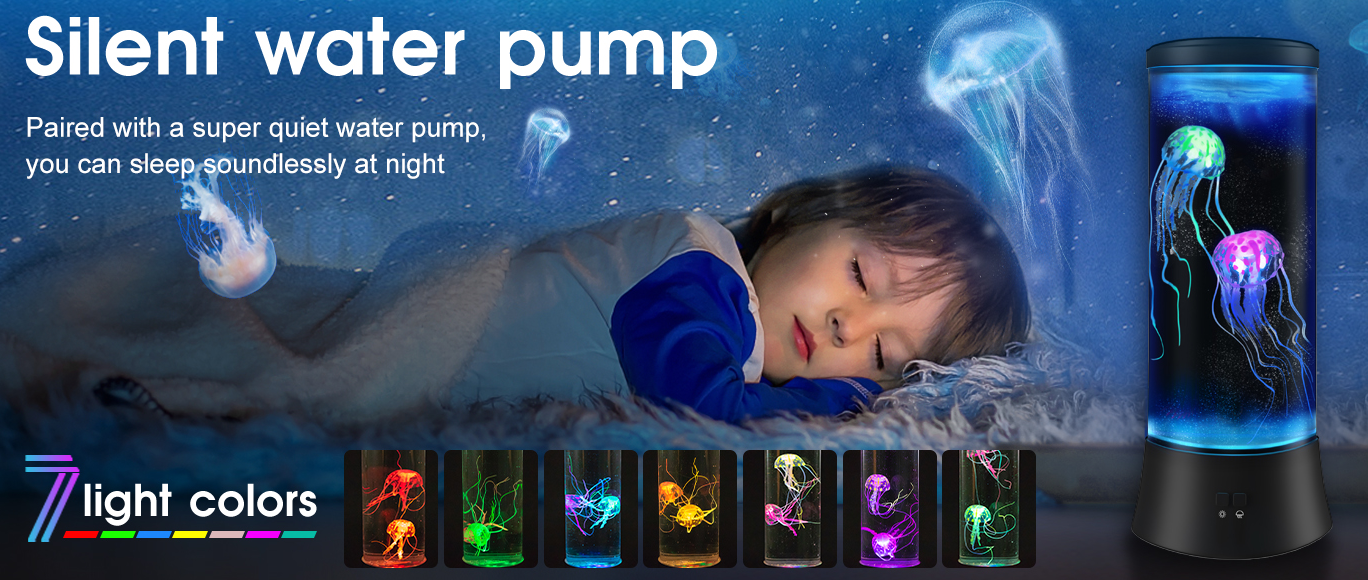
Why do these specific products matter? Because they underscore a strategy: social media trend-spotting. Each of the above went viral because of certain cultural trends:
-
K-Beauty and novel skincare ingredients (snail mucin).
-
DIY beauty hacks (heatless curls).
-
Work-life balance gadgets (desk treadmill).
-
Everyday convenience tech (mini chargers).
-
Creator-focused tools (scrolling ring).
-
Aesthetic room decor (jellyfish lamp).
As a new seller, if you keep your ear to the ground on platforms like TikTok – especially among niches like BeautyTok, HomeTok, etc. – you can identify potential product hits early. A product doesn’t need to be brand new; sometimes it’s an old product rediscovered by Gen Z and made cool again (e.g., facial ice rollers and gua sha stones are other examples of viral rejuvenated products).
How to leverage viral products: Speed is key. If you see a product trend going viral and you can source it quickly, do so, but also gauge if it has staying power or seasonal timing. Also, improve upon what’s out there – viral doesn’t always mean quality (some initial viral heatless curlers were flimsy). By checking reviews of existing offerings, you can launch a version that addresses complaints, riding the trend while being the “better mousetrap.”
Finally, don’t forget to actually use social media in your marketing if possible. Some sellers send their viral products to micro-influencers or encourage customers to share on TikTok. A little push can feed the virality loop, boosting Amazon sales further.
In conclusion, selling a viral product can catapult a beginner seller into rapid sales – but always have a plan for after the trend or how to differentiate within it. Use trends as a stepping stone to establish yourself, then build a brand that can introduce the next big product.
Top Niches with 80%+ Free Traffic on Amazon (2025)
Wouldn’t it be great to sell in a niche where most of your customers find you organically, without needing to spend big on ads? Such niches do exist – they’re often characterized by products that shoppers actively search for on Amazon (or via Google which then leads to Amazon), rather than brands pushing ads. In these niches, a high percentage of traffic is “free” (organic). Here are some top niches in 2025 where sellers report 80% or more of their traffic coming organically, meaning you can potentially thrive with minimal advertising:
1. Pet Supplies for Dogs (especially Dog Toys & Beds): Pet owners notoriously search Amazon for pet needs. Items like dog beds, chew toys, pet grooming tools, and pet treats generate tons of organic searches because when someone gets a new puppy, they type in “dog bed” or “durable chew toy” and browse. If you rank well for those terms, you’ll get a flood of free traffic. The dog niche isn’t dominated by one or two brands; it’s fragmented, so organic results get a lot of clicks. Many successful pet product sellers find that once they hit first page for “indestructible dog toy” or “memory foam dog bed”, the sales keep flowing largely from organic placement – often 80-90% organic vs maybe 10-20% from their sponsored ads (which they may only use for backup). The sheer volume of pet ownership (over 63 million households have dogs in the US) means persistent search demand. Additionally, Amazon’s algorithm favors pet products with good reviews and those get recommended (Frequently Bought Together, etc.), further amplifying free exposure. So, if you enter this niche and optimize well, you could enjoy a torrent of organic pet-loving traffic.
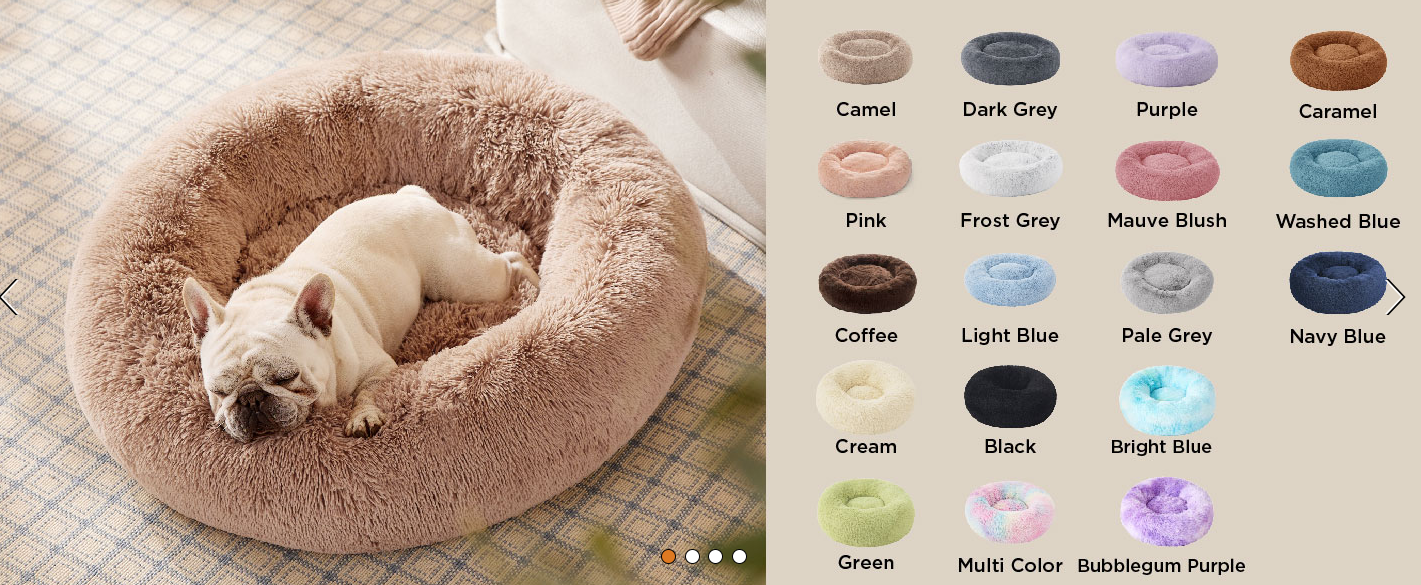
2. Home Organization & Storage: Think of all the people searching for solutions to tidy up their homes – closet organizers, shoe racks, pantry storage containers, drawer dividers. These types of products align perfectly with keywords people naturally search. For example, a term like “under bed storage bag” or “hanging closet organizer” has high search volume. If you sell a quality organizer and optimize your listing SEO (title, bullet points with those keywords), you can climb up in the search results. This niche gets a lot of organic traffic because when someone decides to organize their home, they often start on Amazon with a generic search. Many have no specific brand in mind; they just want a solution that fits their space. Thus, a huge portion of conversions come from organic browsing and searching. Good photos and reviews will clinch the sale once they land on your listing – without you paying for a click. Home organization had a boom in recent years (influenced by Marie Kondo, etc.) and remains strong. With the ongoing “tidy home” movement, products in this niche can see 80%+ free traffic, since utility-focused shoppers often scroll through organic results patiently to find the item with right dimensions/features.

3. Health & Personal Care Basics: Consumable basics that aren’t dominated by megabrands often see primarily organic traffic. For instance, things like vitamin organizers, earplugs, orthotic shoe insoles, heating pads, reusable gel ice packs – people search these by the product name. They might type “7-day pill organizer large” or “gel ice pack for knee” and then buy whichever well-rated listing appears. If you have one of those well-rated listings, you’ll get that sale organically. These items fulfill a need and buyers are usually looking for the best solution, not a specific label. So SEO-optimized listings with lots of customer Q&A and reviews will naturally rise. Health devices like a simple digital thermometer or a blood pressure cuff (assuming they’re class I devices which are mostly ungated) often get a ton of organic traffic. Why? Because Amazon has become the default pharmacy/store for many basic health needs – users search directly for the item. Often more than 80% of the traffic for a top pill organizer or heating pad listing is from organic search and Amazon’s own recommendations (like Amazon’s Choice tags), not ads. One caveat: ensure any health-related product meets regulations (FDA class if needed) to avoid trouble.

4. Office & Stationery Supplies: Amazon is the new Office Depot for many. Business owners, teachers, students – they search Amazon for printer paper, notebooks, pens, file folders, desk organizers and more. Many of these searches are purely generic like “A4 printer paper 500 sheets” or “planner 2025 weekly”. If you sell, say, a planner or journal and manage to rank for those terms, you’ll get a flood of free traffic around back-to-school or New Year planning season. The office supply niche has some big brands but also plenty of room for unbranded or private label products to rank. People often choose based on price, reviews, and Prime shipping rather than brand loyalty in these categories. A top listing for something like “gel pens 20 pack” might see only a small fraction of traffic from ads (maybe when launching), but once established, nearly all sales come from organic placement and Amazon’s “customers also bought” suggestions, etc. In fact, a lot of businesses order supplies via Amazon and they often click the first reasonable result – meaning being at the top organically is key and very rewarding.

5. Replacement Parts & Accessories: This is a bit of a secret goldmine. If you sell replacement parts or add-ons for popular items, customers will seek you out via search. Examples: vacuum cleaner filters (compatible with a certain model), coffee machine water filters, replacement toothbrush heads (for a brand-name electric toothbrush), or camera lens caps. Often, the original brand sells these at a premium, so shoppers look for cheaper alternatives by searching “compatible with X model filter”. If you position your product well (and specify compatibility clearly), you can absorb a lot of that traffic. These searches are highly targeted (buyers know exactly what they need), and conversion rates are high if your product matches the need. What’s more, hardly anyone runs ads on these long-tail terms except maybe the original brand – which might not even bother if they rely on brand name. Thus, organic search is how people find you. I’ve seen sellers of vacuum filters or electric toothbrush heads say 90%+ of their sales were organic because users just search the model and find them. However, ensure to follow Amazon’s rules on stating compatibility (you typically should say “Replacement filter for [Brand X Vacuum], compatible with model Y” without using the brand name in a deceptive way). Done right, these listings can rank high and attract lots of eyeballs for free.
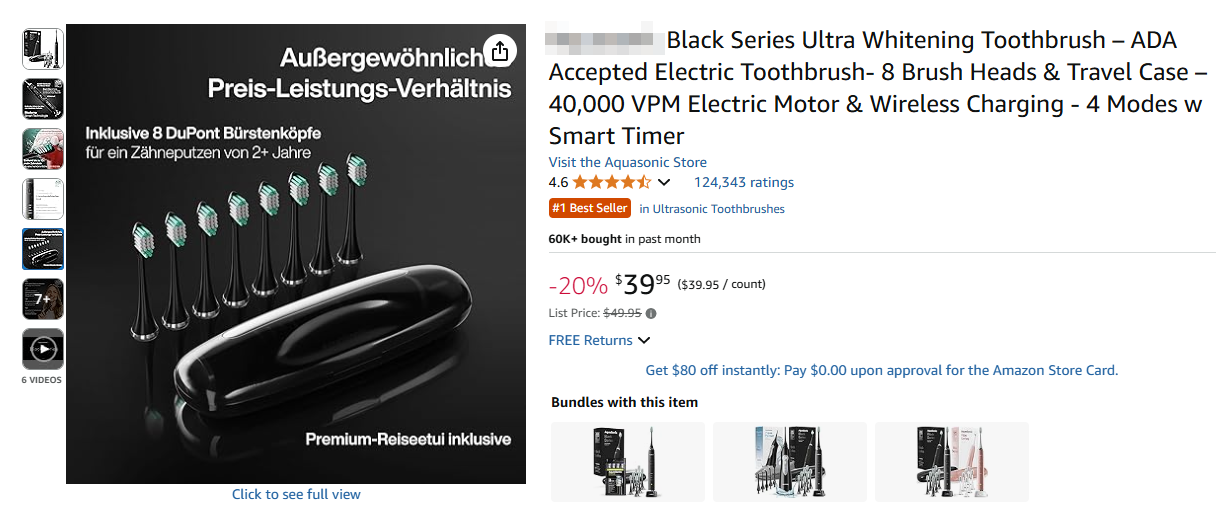
6. DIY and Hardware Essentials: Many homeowners and DIY enthusiasts go straight to Amazon to search for hardware bits and pieces: screws, wall anchors, craft supplies like resin or wood carving kits, LED strip lights, etc. For instance, someone might search “M6 stainless steel screws” or “epoxy resin kit 16 oz”. These queries have strong purchase intent and usually they’re not browsing ads but the organic results that best match the specification they need. If your product listing is rich with detail (exact sizes, what it’s used for, compatibility), Amazon’s algorithm will surface it for those searchers. The nice thing here is that often there’s not a dominant brand for, say, generic screws or generic LED strips (there are many sellers). So one with better SEO and reviews can organically outperform others. Traffic is largely search-driven or from category browsing (e.g., someone drills down into Industrial & Scientific > Fasteners). Either way, that’s organic navigation. Sellers in the DIY niche often find they don’t need to spend heavily on PPC except when new – the steady demand from people fixing, building, and creating drives consistent free traffic.

In all these niches, the common theme is customer-driven search behavior. People actively look for these products on Amazon, rather than needing to be convinced by ads. As a result, once your product ranks well, a large proportion of visitors (and buyers) come to you without cost. To maximize this, focus on:
-
Keyword Optimization: Make sure you include all relevant keywords in your title, bullets, backend, etc. If people search “BPA-free water bottle 32oz”, and you sell a water bottle, you want to show up by having those terms.
-
Excellent Content and Reviews: Organic traffic means nothing if you don’t convert it. High free traffic niches are competitive in that the best listings soak up most sales. So invest in great images, clear descriptions, and encourage positive reviews. Amazon’s algorithm also boosts listings that convert well – it’s a virtuous cycle.
-
Inventory in Stock: If you rank well and get tons of free traffic, the worst thing is to stock out. Then your rank (and free traffic share) plummets. So plan inventory carefully in these niches with steady demand.
Finally, while these niches have high organic potential, starting from scratch means you will likely use some PPC to gain initial traction. But the idea is, unlike some categories (e.g., supplements or electronics where PPC is ongoing and heavy), in these niches you can taper off ads once you’re established and let the organic engine run at 80%+ capacity. That’s the dream scenario for profitability – minimal ad spend, maximum natural sales.
10 High-Demand Products on Amazon (2025)
Let’s broaden our view and look at 10 products (or product types) that are in very high demand on Amazon in 2025. These are products with huge sales volumes (some evergreen, some currently trending) – meaning lots of customers are buying them. For a beginner, these represent big opportunities if you can find a way to differentiate or carve a niche within them. Even if you can’t compete with the top sellers head-on, knowing what these products are helps you understand consumer behavior on Amazon. Here are 10 high-demand products:
1.Wireless Earbuds: Unsurprisingly, with the world going wireless, earbuds are among the top-selling electronics on Amazon. Apple AirPods dominate, but there’s also massive demand for cheaper alternatives. Generic or lesser-known brand earbuds selling for $20-$50 move huge volumes because not everyone wants to pay $150+ for the top brands. This category is fiercely competitive, but demand is essentially guaranteed as new phone models drop headphone jacks and people need replacements. If entering this, quality control and distinguishing features (like extra battery life, waterproof, etc.) are critical.

2.Face Masks (Skincare): Specifically, things like Korean sheet masks, clay masks, and acne pimple patches are booming. Pimple patches, for example, sell in astonishing quantities (one source noted 4,000 patches/day selling for one brand). The skincare/self-care trend is huge, plus these are consumable so customers repurchase. There are established players, but new ones can still enter by targeting specific skin concerns or ingredients (tea tree, snail mucin, etc.). Note: We’re talking skincare masks here, not COVID masks – those had demand surge in 2020 but not as much now.
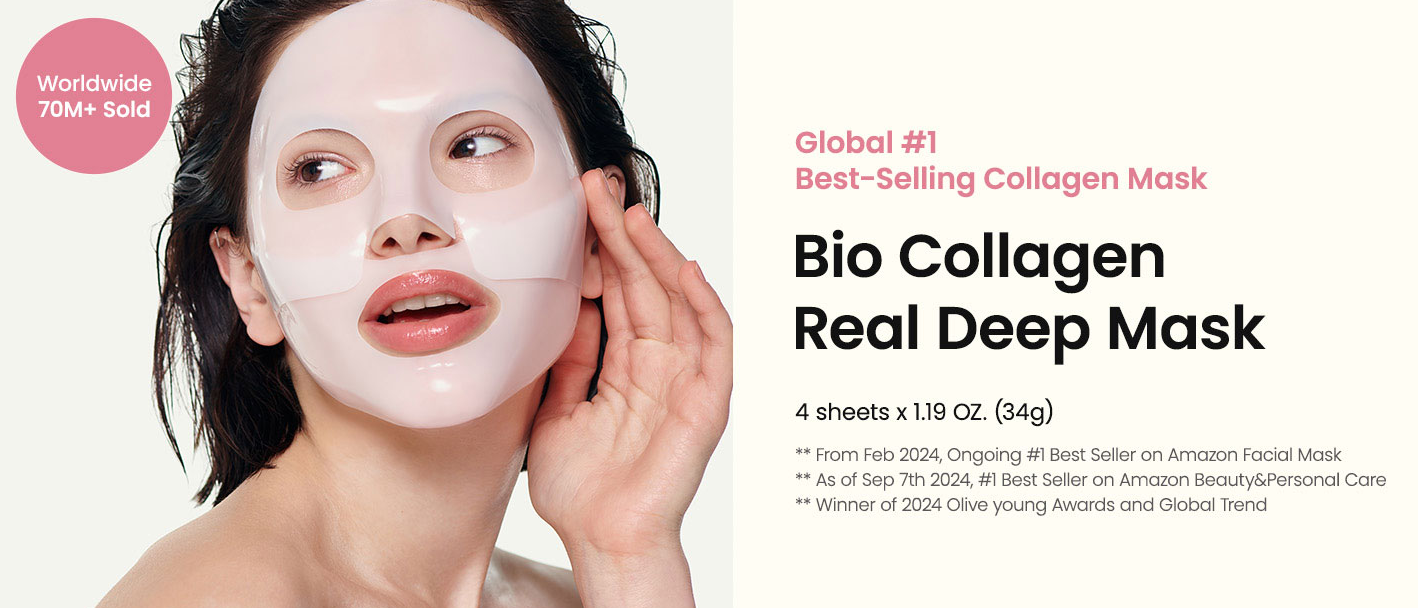
3.Stanley Quencher Tumbler (and dupes): The Stanley Quencher (a large insulated tumbler cup) became a viral favorite and top seller. It often sells out and has spawned many similar products. Demand for large insulated tumblers with handles (40 oz size, etc.) is sky-high thanks to social media. If you can’t sell Stanley, selling a high-quality similar tumbler (with unique colors or features) can ride that demand. People want to hydrate and carry aesthetic cups – it’s become a lifestyle product.

4.Gaming Chairs: With gaming and streaming on the rise, gaming chairs (those racing-style ergonomic chairs) have huge demand. Search volume for “gaming chair” is consistently high, and many models have thousands of reviews. Gamers, home office workers, even teens doing remote school – a wide market. The market has multiple brands (DXRacer, Secretlab, and lots of Amazon brands). It’s competitive in price and shipping is costly (bulky item), but demand is not going away. A variant is standing desks which also are high demand for work-from-home, though chairs seem to have even broader appeal among younger demographics.

5.Robot Vacuum Cleaners: The Roomba and its competitors (Eufy, Roborock, etc.) are extremely popular. On Amazon, robot vacuums consistently rank in top appliance sales. People love the idea of automated cleaning. While the name-brand ones are pricey, there’s demand at all price points. Selling one as a new brand would require serious investment and tech knowledge (likely not viable for a beginner), but one could sell accessories (replacement brushes, filters – tying back to the replacement parts niche). Still, it’s worth noting how big the demand is – showing consumers are willing to spend on home automation.
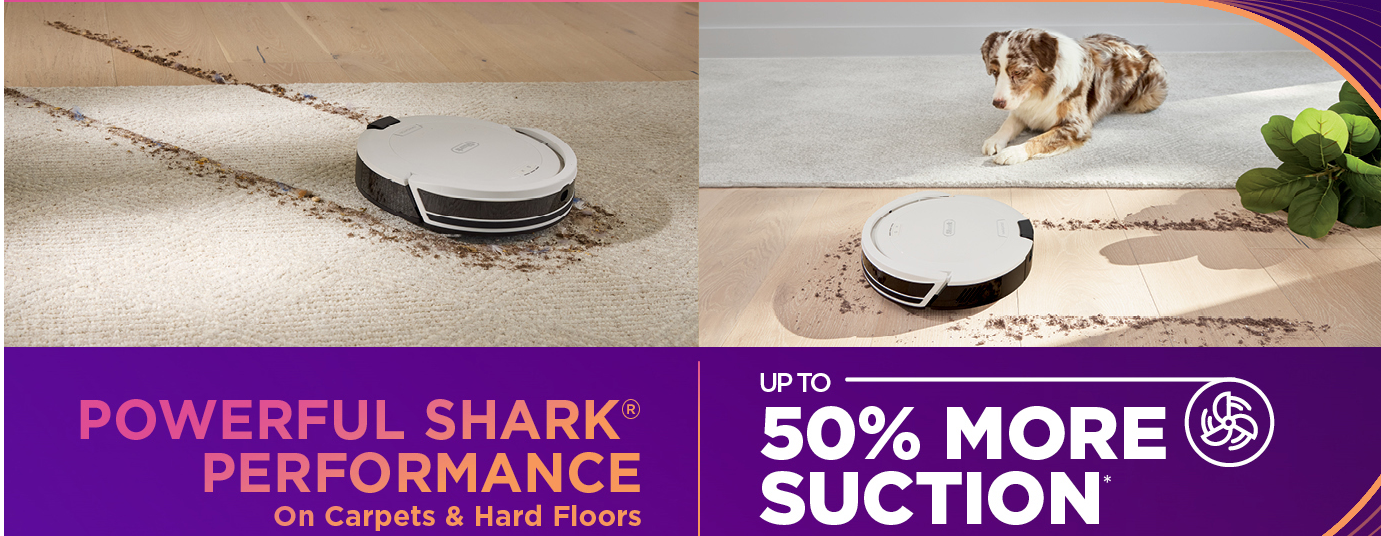
6.Air Fryers: In the kitchen category, air fryers have been a top-selling appliance for a few years and remain in high demand. They cater to health-conscious cooking and convenience. Every holiday season they top gift lists, and many households now consider them a must-have. The market is flooded, but maybe accessories (like air fryer liners, cookbooks, accessory kits) are opportunities since the devices themselves are dominated by known brands. Nonetheless, “air fryer” searches indicate a huge volume of shoppers.

7.Disposable Gloves & Masks (Healthcare): Even after the peak of the pandemic, Amazon sees high demand for basic health protection items like nitrile gloves and face masks (for medical, industrial, or personal use). Businesses and individuals continue to buy these in bulk on Amazon. They’re commodity items – often price-sensitive – but volume is enormous. For gloves, for example, sellers ship tens of thousands of boxes. If you have a supply chain for these, they can be steady sellers (though watch out for any future regulation changes).
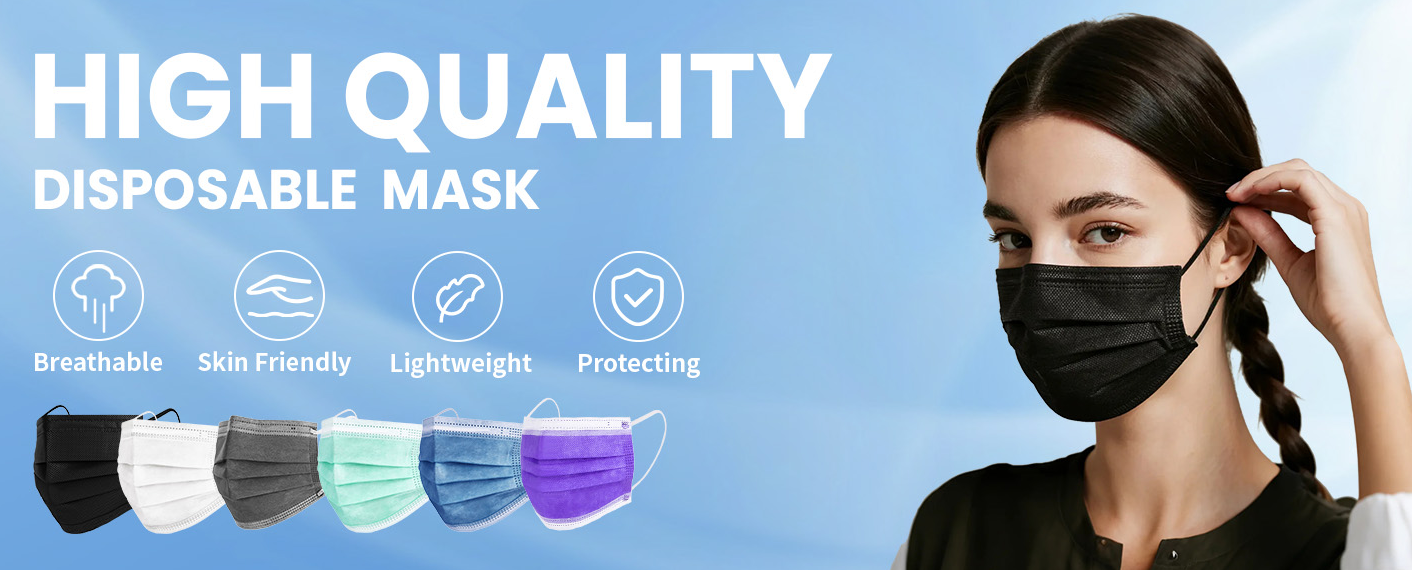
8.Video Game Consoles & Accessories: The latest PlayStation, Xbox, or Nintendo Switch consoles sell out quickly on Amazon when available. While you as a beginner likely won’t be selling the consoles directly (unless doing retail arbitrage), consider accessories. Things like controller charging docks, carrying cases, extra controllers, headset stands – these are all in high demand because the console market is huge. With PS5 and Xbox Series X in full swing, their accessories see continuous sales. Also, gaming headsets (even generic ones) have large demand, as not everyone buys the high-end ones. Being a part of the gaming ecosystem (even peripherally) taps into a giant customer base.
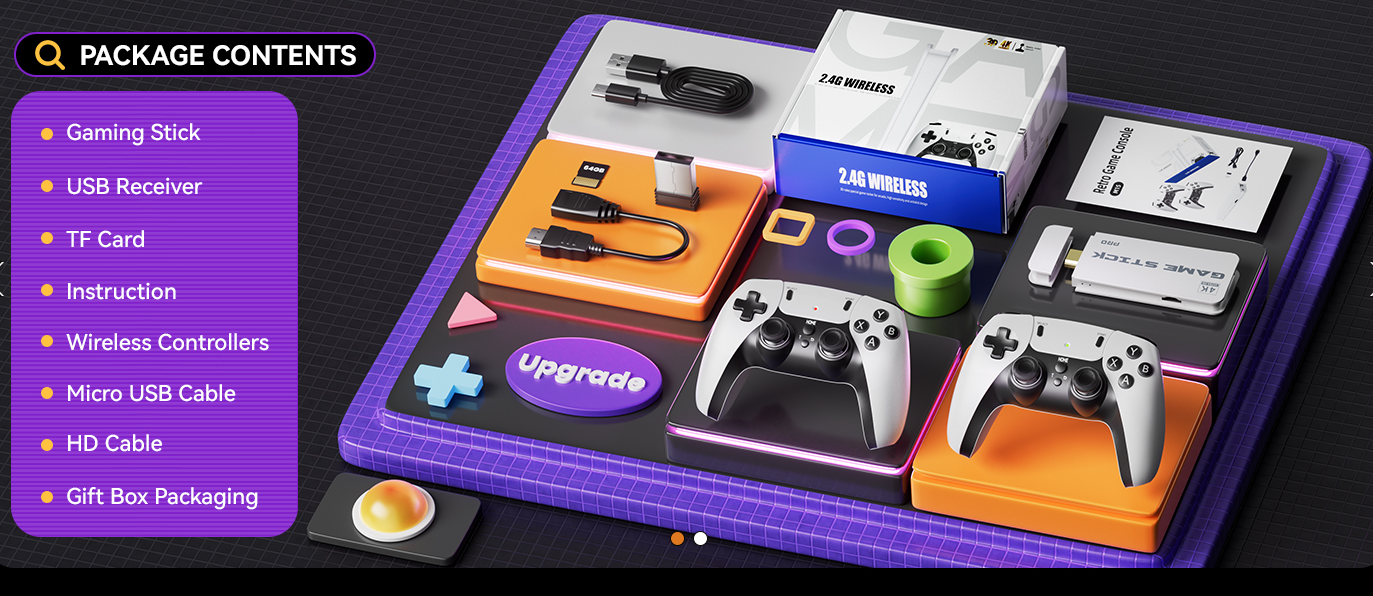
9.Kids’ Educational Toys: Particularly STEM toys or Montessori-style educational kits are hot sellers as many parents look for productive toys. Amazon’s toy category is huge, but within it, educational toys (like coding robots for kids, science experiment kits, wooden Montessori toys for toddlers) are in high demand. They often rank during holiday seasons but also year-round as educational supplements. For example, a kids’ electronics discovery kit or building blocks set might quietly be selling thousands of units a month. If you can innovate or curate a good quality toy in this space, organic parent searches (“STEM toys for 5 year old”) will bring lots of traffic.

10.Dietary Supplements (Vitamins, etc.): This is a massive category on Amazon – think multivitamins, protein powders, fish oil, collagen peptides, etc. Products like Vitamin D, Vitamin C, probiotics, biotin, omega-3 are all bestsellers. Demand is essentially infinite as these are consumables that people rebuy monthly. However, it’s an extremely competitive and somewhat saturated market with heavy advertising and some gating (you may need approvals or at least to follow strict labeling rules). Not to mention trust issues – customers prefer known brands or highly reviewed products since it’s ingestible. So while demand is high, it’s not the easiest for a beginner to break into. It’s listed here to acknowledge the scale: some of the top-selling items on Amazon period are supplements, sometimes doing tens of millions in sales annually per product. If you do venture here in the future, know that success requires quality product formulation, certifications, and strong branding. It’s high demand but also high stakes.

These high-demand products show where money is flowing on Amazon. As a beginner, you may not immediately sell these exact items, but consider related accessories, or use this insight to gauge consumer trends. For instance, you see smart home gadgets (robot vacuums) and health devices (air fryers, etc.) trending – maybe you opt to sell a simpler smart home accessory or a unique kitchen gadget. Or noticing wireless earbuds in demand might steer you to sell a protective case for earbuds (accessory with less competition). High demand often means high competition, so the strategy is either differentiate the product heavily or attach yourself to the ecosystem via accessories or niche variations.
Also, keep an eye on Amazon Best Seller lists in major categories – Amazon even suggests using Best Sellers to spot trending products. They listed examples like false eyelash mascara, rice cookers, fitness trackers, etc., as popular items. You can glean ideas where demand is proven. Just remember to validate if you can offer something unique or better to capture a slice of that demand.
In essence, high-demand products are a double-edged sword: easy to sell (lots of customers), but hard to stand out. Use the knowledge of what sells to inform your product research (maybe combine a couple of trends, like an air fryer accessory that appeals to health and eco-friendliness). And if you do go after a high-demand category directly, be prepared with a strong differentiation and marketing plan.
Best Amazon Products for Dropshipping
If you’ve decided to pursue the dropshipping model on Amazon (meaning you’ll be listing products and having a supplier ship directly to the customer when you get a sale), choosing the right products is crucial. You want items that fit dropshipping well: reliable supply, not too competitive, not requiring branding, and ideally small/medium size for shipping ease. Below are some of the best types of products for dropshipping on Amazon in 2025, along with why they work:
-
Toys & Games (Trendy and Lightweight): Dropshipping toys can be very effective, especially around trends or movies. For example, when a new Disney movie hits, related toys (if ungated) spike in demand. According to one guide, the U.S. toy retail sales hit $28.3 billion in 2024 – a huge market. Items like remote control cars, fidget toys, puzzles and outdoor water slides were highlighted as strong sellers with tens of thousands in monthly revenue. These are great for dropshipping because:
-
They often come from suppliers in China at low cost.
-
They’re usually not heavy, so shipping is manageable.
-
Demand can surge unexpectedly (like a fidget toy trend), and you as a drop shipper can capitalize without holding stock.
-
Example: A remote control car that’s trending can generate ~$125k/month; as a dropshipper, you could list it when it’s hot and have your supplier fulfill orders. Just ensure the supplier can keep up with timely shipping, especially if it’s a gift season.
-
-
Home & Kitchen Gadgets: This category is evergreen on Amazon and well-suited to dropshipping. Items like cheese board sets, specialty pillows, dish racks, and kitchen organizers sell steadily. In fact, Home & Kitchen is one of the most reliable dropshipping categories, since shoppers always look for home improvement items. For dropshipping, look for unique gadgets or decor pieces that aren’t widely available at local stores – e.g., a bamboo bathtub tray or a novel fruit slicer. The key is perceived value; people buy these on impulse when browsing Amazon. Some top dropshipped home products by sales: cheese plates ($18.5k/mo), bamboo memory foam pillows ($133k/mo!), and dish drying racks (~$90k/mo). You likely find such products on Alibaba or AliExpress easily. Ensure your supplier’s item photos match what you list, since you won’t handle the item yourself.
-
Electronics Accessories: While core electronics can be tricky (due to brand dominance and tech issues), accessories are golden for dropshipping. Think phone chargers, earbuds, tripod stands, LED strip lights, smart gadgets. People constantly search for affordable versions of these. According to data, the electronics category is huge ($119B in 2025 US sales), and accessories like gaming headphones, star projectors, and LED curtains are raking in tens of thousands per month. As a dropshipper, you can partner with suppliers of the latest cool gadget – for example, a trending galaxy star projector night light (a viral item last year) – and list it on Amazon. Many such items are unbranded and perfect for drop shipping. Just be mindful of quality and certifications (avoid anything needing FCC that doesn’t have it). Quick tech cycles mean you can test many products; if one flops, move to the next trending gadget without being stuck with inventory.
-
Fitness and Outdoor Gear: Items such as resistance bands, cycling accessories, camping gear, hiking gadgets are popular and can be dropshipped. People often go to Amazon for specialized gear that local stores might not carry. For example, portable camping showers, hammocks with mosquito nets, or bike repair toolkits. The Sports & Outdoors category offers diverse products and is friendly to dropshipping because a lot of it is unbranded gear from manufacturers. Some top sellers: yoga mats ($100k/mo), massage guns ($20k/mo), weighted hula hoops or waist trainers (~$50k/mo). If you see a fitness trend (like a certain style of resistance band exercise going viral), you can list the relevant product quickly via dropship. Shipping can sometimes be higher for heavier gear, so lean toward lighter or smaller items to keep delivery times and costs reasonable.
-
Pet Supplies & Accessories: Pet products are ideal for dropshipping – pet owners are avid shoppers and like trying new things. You can dropship unique pet toys, pet grooming devices, pet travel accessories (foldable pet pools, pet carrier backpacks), etc. Many of these are available via dropship suppliers. Since pet items often aren’t high-tech or fragile, the risk is lower. Also, trends happen (like a cat toy going viral). One example, a magnetic rings fidget toy was even a pet+family crossover item, making $30k/mo – think of interactive pet toys similarly. With dropshipping, you could list a variety of pet products and see which catches on. Just ensure any pet-related item is safe and non-toxic.
Why Dropshipping These Makes Sense: In dropshipping, you don’t hold stock, so you can be flexible and test many products. The above categories have lots of low-cost items that can be bought as-needed from suppliers (often in China) after you get an order. They’re also “hot” categories – meaning if something picks up in ranking, it can sell a lot.
For instance, if you dropship a puzzle and it unexpectedly becomes popular (maybe a competitor sold out or a Reddit community talked about it), you could suddenly get 3,500 sales a month and your supplier can directly send to each customer. You’d just pass along orders via CSV or an app if integrated. No need to manage a warehouse for 3,500 puzzles – a dream scenario for a small operation.
A Few Considerations for Amazon Dropshipping:
-
You must ensure your supplier is reliable and will not include any invoices or marketing from them in the package (per Amazon’s dropshipping policy, you must appear as the seller of record). Communicate this clearly.
-
Check shipping times – on Amazon, customers expect reasonably fast shipping, especially with Prime everywhere. If your supplier is overseas, consider using an expedited ePacket or similar. Alternatively, look for suppliers with US warehouses or use dropship aggregators.
-
Quality control is out of your hands physically, so vet suppliers via samples and reviews. A string of defective drop-shipped items will result in returns and bad reviews, hurting your account.
-
Even if you don’t use FBA, mind your metrics: late shipments or tracking issues can hurt your seller health.
Dropshipping on Amazon can be tougher than on Shopify due to strict performance metrics, but by choosing products wisely (the ones above are in proven demand and usually straightforward), you improve your odds. Many successful Amazon dropshippers focus on a niche (say, all pet products or all home gadgets) and become known for it via good reviews. You can too, by curating the best dropship products in your chosen category and delivering reliably to customers.
In short, the best products for dropshipping on Amazon are those that align with market demand and can be sourced from reliable suppliers on a per-order basis. The examples above – toys, home gadgets, accessories, fitness gear, pet supplies – all fit that bill. Start with a handful, test the market, and scale winners. Dropshipping can be an excellent way for beginners to get their feet wet without heavy upfront costs, as long as you follow Amazon’s rules and keep customers happy with timely deliveries.
How to Find Profitable Products on Amazon (Step-by-Step)
Finding a profitable product is like being a detective – you gather clues (data) and systematically narrow down suspects (product ideas) until you find the one that has both strong demand and good profit margin with manageable competition. Here’s a step-by-step guide for beginners on how to unearth those golden opportunities on Amazon:
Step 1: Define Your Product Criteria (Your “Checklist”)
Before diving into research, set some criteria for what a “profitable product” means to you. Common criteria include:
-
Price range: Aim for a selling price that isn’t too low to make profit or too high to deter impulse buys. A sweet spot is often $20 to $70. Products in this range have enough margin to absorb fees (a $30 item has about $4.50 Amazon fee at 15%) yet are affordable to many consumers.
-
Demand volume: Look for evidence of at least 200 sales per month on Amazon for similar items. That indicates a healthy demand. This can be gauged using tools (like Xray’s estimated sales or Amazon’s BSR – Best Seller Rank – typically a BSR under ~20,000 in a broad category often means decent sales).
-
Competition level: Ideally, find niches where the top sellers have under 100-200 reviews. Low reviews often mean the market isn’t dominated by entrenched players, giving you a chance to compete. Also see if any big brands are present; it’s harder to beat, say, Apple or KitchenAid, but many niches have no famous brand.
-
Product size/weight: Smaller and lighter is easier and cheaper. If you stick to items that fit in a shoebox and weigh under 2-3 lbs, FBA fees are lower and shipping to FBA is cheaper. Plus, no need to worry about oversized storage or high dimensional fees.
-
Non-seasonal: As a beginner, you might want a product that sells year-round, not just at Christmas or summer, unless you have a strategy for seasonal items. Check Google Trends or Amazon’s sales rank history to ensure stable year-round interest.
-
No major quality issues: Avoid products that easily break or have complex electronics (less returns and headaches). Simpler is often better – fewer moving parts, durable materials.
-
Not gated or risky: Ensure your idea isn’t in a restricted category (e.g., don’t pick “supplements” as your first product due to regulations). Also avoid obvious IP issues (no trademarked characters or patented mechanisms as covered earlier).
Step 2: Brainstorm and Research Product Ideas
Now with criteria in mind, generate a list of potential product ideas. Here are methods:
-
Use Product Research Tools: As discussed, tools like Helium 10 Black Box or AMZScout Product Database let you plug in your criteria and they’ll spit out products meeting them. For example, set category = Kitchen, price $20-50, sales >300/month, reviews <100. See what pops up. You might discover something like “ceramic butter crock” – a niche kitchen item selling well with few sellers.
-
Browse Amazon Best Sellers/New Releases: Skim through the Best Sellers in categories you like. Look at sub-categories too, where niche items hide. Amazon’s own blog suggests using Best Seller lists to spark ideas. If something catches your eye, note it. Also check “Movers & Shakers” (fast gainers) – could show trends. And “Customers’ Most Wished For” lists for what people want.
-
Check Competitor Marketplaces: Sometimes trending products on Etsy, eBay, or AliExpress can inspire Amazon ideas. If an item is trending on AliExpress (meaning dropshippers or international buyers like it), maybe it’s not saturated on Amazon yet.
-
Social Media Trends: As noted, TikTok, Instagram, Pinterest can show emerging product trends (e.g., a unique lamp or kitchen hack device). Jot these down if they meet your criteria (or could, with a twist).
-
Consider Personal Passions/Problems: Think of products you or family use that aren’t mainstream. Or a problem you have that a product could solve. Niche communities (camping, baking, pet training, etc.) often have specific product needs that aren’t fully met on Amazon yet – if you’re part of one, use that insight.
Make a list of, say, 10-20 ideas from the above steps.
Step 3: Narrow Down with Deeper Analysis
For each idea on your list, do the following analysis:
-
Validate Demand and Competition: Use the Helium 10 Xray extension or AMZScout PRO on the Amazon search results page for that product keyword. For example, search “ceramic butter crock” on Amazon, run the extension. Look at:
-
Average monthly sales (are multiple sellers > 200 units/month? Good).
-
Number of reviews (are there sellers with <50 reviews but still ranking and selling well? That’s a great sign!).
-
Niche Score (some tools give a score out of 10 for opportunity; e.g., AMZScout’s AI might label something high opportunity if demand >> supply).
-
How many sellers are FBA vs FBM (if everyone is FBA, you’d likely use FBA too to compete).
-
Check if the results are almost identical products or lots of variation (if lots of identical, might be saturated; if variations, maybe room for your unique spin).
-
-
Read Reviews and Q&A: Click into the top 3-5 listings for that product. Skim reviews especially the 3-star ones (they often list pros/cons). Also read Q&A section. This is gold for figuring out how to differentiate. Maybe all customers complain the butter crock lid falls off easily – you could design one with a latch. Or they ask “does it fit X size stick of butter?” often – meaning confusion about size, so you ensure to clarify that and perhaps design it to fit standard sticks.
-
Calculate Profit: Roughly estimate if it’s profitable. Let’s say the item sells for $25. Use Amazon’s FBA calculator (you can get to it via Seller Central or a tool) – input product weight/dims (maybe find a similar product’s listing info). Suppose FBA fees + referral = $8. Now, can you source/make it for $5 or less? If yes, you have $25 - $8 - $5 = $12 profit per unit (~48% margin, which is great). If sourcing likely costs $15, then $25 - $8 - $15 = $2 (8% margin, too thin). You might quickly browse Alibaba for a generic similar item to gauge cost. For instance, see that butter crocks go for $3 each at 500 units order; that’s promising. If costs seem too high or margin <20%, probably drop that idea. Focus on ideas with healthy margin potential.
-
Check Seasonality: Using Helium 10’s Trendster or even Google Trends. E.g., some items (like “beach picnic mat”) might show big summer spikes. If you’re okay with seasonal, fine, but most beginners want year-round. Seasonal items can still be profitable (just manage inventory to not overstock in off-season).
-
Assess Differentiation Angle: Ask yourself, “Can I improve or differentiate this product enough?” If the top sellers are all clones, you’ll need a unique angle: a bundle (butter crock + spreader knife), design improvement, better materials, or targeting a sub-niche (e.g., butter crock with cow patterns for farm style kitchens). If you cannot think of any improvement and it’s just a commodity, the battle will be price-based which is tough. So lean towards ideas where you do see room for innovation or at least creative branding/marketing.
At this stage, you should whittle your list down to maybe 2-3 highly promising products that meet criteria and show real potential in data.
Step 4: Source Samples and Validate Further
For your top 2-3 ideas, reach out to suppliers (Alibaba, etc.) to get quotes and possibly samples. This does a few things:
-
Confirms your cost assumptions (maybe you find a supplier who can do your improved design for $4/unit).
-
Lets you inspect product quality with a sample. You don’t want surprises after ordering 500 units.
-
You can photograph the sample or use it for early marketing content prep if you move ahead.
Simultaneously, consider doing a small test listing if possible without big orders (some sellers do a trial by listing a small quantity or even dropshipping a few units to see response – but careful with Amazon rules). Alternatively, gauge interest via friends or small social media ad to a landing page, etc., if you have the savvy – see if people would sign up to buy.
Step 5: Make the Decision & Launch Properly
With data and samples in hand, pick the one product that ticks the most boxes. That’s your winner to launch. Now:
-
Create a stellar listing: use those review insights to write great copy (emphasize how your product solves X problem others had). Use high-quality images (maybe hire a photographer or use 3D renderings if applicable), including infographics highlighting your differentiation.
-
Plan your initial marketing: some PPC budget (on Amazon ads) to get visibility in the first weeks, possibly small promos or rebates to garner early reviews (within Amazon’s terms of service – no incentivized reviews, but you can use the Early Reviewer Program or Vine if available).
-
Keep an eye on metrics: once launched, watch your conversion rate, tweak price if needed, and ensure you don’t stock out if demand is more than expected.
Finding a profitable product is not magic, it’s methodical. One analogy: you’re panning for gold. The criteria are your pan’s sieve (filtering out big rocks and sand you don’t want), the tools and research are the river you’re panning in (where the info flows), and your own analysis is the act of shaking out the dirt to reveal shiny nuggets. It takes some effort, but by following steps and using data, you significantly raise the chances that the product you choose won’t be a dud.
Remember, patience and persistence are key. You might rinse and repeat this process a few times to find “the one.” Many expert sellers say they research dozens of products to pick a single winner. That’s normal. But once you do find that profitable product and launch it, the reward is not just monetary – it’s the foundation of your Amazon business, proof that your research skills paid off. And then, you can do it again and again to expand your product line.
Private Label vs Reselling vs Dropshipping: Which Is Best for New Sellers?
As a new seller, you have a few different business models to choose from on Amazon. The three main ones are Private Label, Reselling (Wholesale/Arbitrage), and Dropshipping. Each has its pros and cons, but which is best for a beginner in 2025? Let’s break them down and see why, for most newbies, dropshipping might be the most accessible route (though not without its own challenges).
Private Label (PL): This is when you create your own brand/product, usually by customizing or developing a product and having a manufacturer produce it with your branding. For example, getting a factory to make a kitchen spatula with your brand name on it and unique color/design.
-
Pros: You have full brand control and potentially higher profit margins because you own the brand. You can differentiate your product and build brand loyalty. If successful, a private label brand can even be sold as a business (some build brands to sell to aggregators).
-
Cons: It usually requires a larger upfront investment – you have to pay for inventory (often $1k-$5k+ to start, for manufacturing and shipping a batch of products) with no guarantee it’ll sell. It takes time to develop (sourcing samples, production lead time). Marketing is on you – you’re introducing a new brand no one has heard of. Risk is higher if you pick wrong product or misjudge demand, you could be stuck with unsold inventory. Also, because you’re investing more, mistakes (like a design flaw) are costlier.
As a beginner, private label can be overwhelming – you have to learn sourcing, freight, branding, listing optimization, etc., all at once. It’s certainly a proven model for those who do it right, but the learning curve and capital required are steep. Many beginners do succeed with PL, but often after a lot of upfront research and sometimes a failed product or two to get it right.
Reselling (Wholesale or Retail Arbitrage): This model means you sell existing products from other brands. Retail arbitrage is buying from retail stores (clearance, etc.) and selling on Amazon; online arbitrage is similar but online; wholesale is buying in bulk from distributors/brands and reselling on Amazon.
-
Pros: Lower branding effort – you’re selling known products, so demand is already there. No need to create a listing (if it exists, you just add your offer) – you compete for the Buy Box on that listing. Upfront cost can be moderate; for arbitrage, you can start with just a few hundred dollars sourcing discounted items. For wholesale, you might need to invest a couple thousand to buy case packs. It’s a straightforward concept: buy low, sell high.
-
Cons: Competition can be fierce on listings with multiple sellers. Price wars often ensue, shrinking profit. Some big brands are gated to new sellers (requiring approval or are outright not allowing 3P sellers). Margins in wholesale are usually thinner (maybe 10-20%) compared to PL. Retail arbitrage is also quite labor-intensive (scouting stores, limited scalability). Plus, Amazon has been getting stricter on invoices and authenticity – you need to ensure supply is legit or risk account issues. You also don’t create your own customer base or brand – you’re always piggybacking on others’. And popular products can suddenly tank if Amazon itself starts selling it or if the brand restricts sellers.
For beginners, reselling is a common starting point because of lower investment – e.g., scanning clearance items with an app and sending them in. Many learn Amazon’s ropes this way. But long-term, it can be hard to scale a stable business since you have to constantly find new products, and competition and Amazon policy changes can squeeze you.
Dropshipping: As discussed, this means you list products on Amazon that you don’t stock yourself; when you get a sale, you purchase it from a supplier who ships it directly to the customer. (Important: On Amazon, true dropshipping must hide the supplier’s identity and make it seem the package is from you, per policy.)
-
Pros: Lowest upfront cost of the three. You don’t pay for inventory until you have a sale (so no inventory risk). You can quickly test many products without financial risk – if something doesn’t sell, you just delist it. It’s very flexible; you can react to market trends swiftly. Also, no need for warehousing or FBA fees if you do FBM dropshipping (though some do a hybrid, drop shipping to FBA). This model has enabled some to start with literally a few hundred dollars or less. For a beginner unsure of what to sell, it allows experimentation.
-
Cons: Amazon’s policy constraints – you must ensure your supplier is on point. Slow shipping from AliExpress, for example, can lead to late shipments and angry customers (remember Prime has spoiled customers with 2-day delivery). You don’t control quality, so a bad supplier = bad reviews = trouble. Amazon requires you to be seller of record, so you need to communicate with suppliers to not include their receipts, etc. It can be logistically tricky to automate (but there are software tools to help route orders to suppliers). Additionally, Amazon customers have high expectations; if a drop-shipped item takes 3 weeks from China, you’ll get complaints. So you might need to focus on domestic suppliers or faster shipping options (which could raise costs). Margins in dropshipping can be thinner than PL, because you’re basically a middleman marking up supplier’s price. Also, since you don’t physically inspect items, there’s always a risk of a bad batch or listing not matching exactly what customers receive.
However, given these cons, you can mitigate a lot by choosing reliable suppliers (even domestic dropship wholesalers) and picking the right products as previously discussed.
Why Lean Toward Dropshipping as a Beginner:
-
Minimal risk: You’re not buying 500 units of a garlic press that might end up unsold. You can try selling a garlic press via dropship and if it doesn’t move, no harm done (maybe a bit of time lost, that’s it).
-
Learning experience: Dropshipping forces you to learn product research, listing optimization, customer service, etc., without the heavy financial burden. You can even treat it as market research – use dropship to find a product that sells well, then consider private labeling that product to maximize profit with your own brand once you’ve validated demand.
-
Budget friendly: If you don’t have much capital, dropshipping is the way to start making cash flow. That cash can later fund a private label venture if you want to go that route. It’s like training wheels for e-commerce with much lower cost.
-
No storage logistics: You won’t need to figure out sending inventory to FBA or storing boxes in your garage. The supplier handles it. As a beginner, that simplicity helps you focus on core tasks (finding and marketing products).
-
Flexibility: If something changes (say a trend dies or Amazon rules change), you can pivot quickly in dropshipping. With private label, if you’re sitting on inventory and something goes awry, you’re stuck.
Now, that being said, dropshipping isn’t a get-rich-quick – you still have to put in effort to find good products and reliable suppliers, and margins per product might be smaller, so you compensate by volume and variety. But for someone starting out in 2025, particularly with limited funds, dropshipping edges out as a more forgiving model.
Private Label could be the end goal – building your own brand that maybe you discovered via dropshipping success. Many sellers do exactly that: for example, they dropship pet toys, find one style that sells like crazy, then decide to private label their own improved version of that toy to build a brand, using the earnings and data from dropshipping.
Reselling can make you money (especially wholesale) but usually requires relationships with distributors and more capital than dropshipping, and Amazon is increasingly competitive there (plus there’s risk of brand gating unpredictably). Some newbies do well with retail arbitrage to start small, but it’s like a part-time hustle and not easily scalable to a big business.
So, in summary: Dropshipping is often best for new sellers due to low cost and low commitment, enabling you to learn and fail fast without devastating losses. Private label offers greater upside but is riskier upfront – perhaps best tackled once you have some experience or funds. Reselling is a middle path but can be limiting and subject to external brand decisions.
For a beginner reading this, if you want a straightforward recommendation: Start with dropshipping (just make sure to follow Amazon’s dropship policy carefully to avoid violations). Use it to learn the market and generate cash. Then, as you gain confidence, you might branch into creating your own brand (private label) or scaling with wholesale deals. Each model can work – many successful sellers do all three even – but the agility and low barrier of dropshipping make it the winner for most new Amazon entrepreneurs in 2025.
Sourcing: Where to Find Reliable Suppliers for Beginner Products
Once you’ve identified a great product to sell, the next critical step is finding a reliable supplier to provide that product (or manufacture it if it’s private label). Supplier problems can sink your business – late shipments, poor quality, or scams are nightmares you want to avoid. So, where and how should beginners source products? Let’s explore the main sourcing avenues and tips to ensure they’re reliable:
1. Alibaba (for Private Label or Bulk Wholesale):
Alibaba.com is the go-to international marketplace to find manufacturers and trading companies, especially in China (but also suppliers from India, Vietnam, etc.). If you are private labeling or buying inventory in bulk, Alibaba is a prime resource. Although Alibaba isn’t a dedicated dropshipping platform (it’s more for bulk), it has an enormous selection of suppliers for virtually any product. You can communicate directly with manufacturers, negotiate prices, and even have products customized with your logo.
To ensure reliability on Alibaba:
-
Check supplier credentials: Look for Gold Supplier status, years in business, and Trade Assurance (Alibaba’s built-in payment protection). Also check if they are a manufacturer or trading company (manufacturers make the goods; trading companies resell – both can be fine, but it’s good to know).
-
Read reviews/ratings: Alibaba shows some feedback. And a trust score – Alibaba has a 4.2/5 trust score on TrustPilot from many users, which indicates the platform itself is generally seen as reputable for connecting with suppliers.
-
Order samples: Never place a big order without sampling. Pay the $50 or $100 for a sample to verify quality and see how the supplier communicates. It’s worth it.
-
Negotiate and clarify terms: Be clear about production time, payment terms (use Trade Assurance for your first order if possible – it acts like escrow), and quality standards. Good suppliers won’t shy from detail; if one is evasive, consider that a red flag.
Alibaba is a powerful tool for finding a long-term supplier who can grow with you. Many suppliers will also dropship for you in small quantities if asked (or redirect you to their AliExpress page for small orders).
2. CJdropshipping (for Dropshipping and Small Orders):
CJdropshipping is a dedicated dropshipping platform that provides a wide range of products at competitive prices, with services designed specifically for dropshippers. Unlike traditional marketplaces, CJdropshipping integrates product sourcing, order processing, and worldwide fulfillment — often with faster delivery options thanks to its global warehouse network.
If you’re dropshipping, CJdropshipping is a popular choice because you can place orders one-by-one as your customers buy, without holding inventory, and still offer competitive shipping times to major markets.
To use CJdropshipping effectively:
-
Choose reliable suppliers or sourced products: Many items on CJdropshipping come directly from their own stock or from vetted suppliers. Pay attention to product ratings, order volumes, and warehouse locations to ensure consistent quality and delivery speed.
-
Review product details and images: CJdropshipping provides detailed descriptions and high-quality images. You can also request custom photography to ensure the product matches your brand image.
-
Communicate with your CJ agent: CJdropshipping assigns agents to help with sourcing, order issues, or special requests (like removing invoices, adding custom packaging, or bundling products). A responsive agent can make your dropshipping business run much smoother.
-
Select optimal shipping methods: Depending on the destination, CJPacket, USPS, or other trackable shipping options can deliver faster than standard ePacket times. With warehouses in the US, Europe, and other regions, local fulfillment can cut delivery to just a few days.
-
Place test orders: Ordering a sample to yourself lets you check the packaging, delivery speed, and product quality before selling. You can also see how the product is labeled to ensure it’s dropshipping-friendly.
CJdropshipping is a strong option in 2025 because it helps meet customers’ demand for faster shipping and consistent quality. With its global warehouses, product customization services, and hands-on agent support, it’s often more dropshipper-focused than general marketplaces — making it a great alternative to platforms like AliExpress or Banggood.
3. Domestic Wholesale Suppliers (for Reselling or Fast Dropshipping):
If you want faster shipping or to sell known brands, consider domestic suppliers/wholesalers. For example:
-
Wholesaler directories like SaleHoo or Worldwide Brands list vetted wholesale suppliers (though often for eBay/Shopify sellers).
-
Distributor portals: Some brands have official distributors – e.g., a big toy distributor in the US can supply various toy brands at wholesale. You might need a business license/resale certificate to sign up.
-
Local trade shows: Attending trade shows (or now, virtual ones) in your product category can connect you to suppliers. For instance, ASD Market Week in Las Vegas has tons of wholesale vendors for general merchandise.
For reliability:
-
Vet the supplier’s reputation (look for reviews from other retailers, check BBB if in the US).
-
Start with a small order to test their fulfillment speed and product quality.
-
Ask about dropshipping services – some domestic wholesalers will dropship for you (they may charge a fee per order or have slightly higher prices for the service).
The advantage of domestic suppliers is shipping to your customer is much faster (often 3-7 days within the country). The products also often come ready for retail (with proper labeling, etc.). On the flip side, prices are higher than overseas, but many customers might pay a premium for faster delivery.
4. Print-on-Demand (POD) for Custom Products:
If you want to create custom designs (shirts, mugs, phone cases, etc.) without inventory, POD suppliers like Printful, Printify, or Gooten can be integrated with Amazon (through Amazon Merch or Seller Central via integration). They will print and ship items as orders come in.
-
Reliability here means checking their product quality and print quality. Order samples of your own designs.
-
Turnaround times: ensure they can ship in a timely manner (POD usually takes a few days to print then ships).
-
The POD model is great for unique branded merchandise or trending slogans/memes with low risk.

5. Amazon’s Global Sourcing (Supplier Database & Requests):
Recently, Amazon launched tools to help sellers find suppliers (e.g., Amazon has a Global Supplier database if you have a brand registered, and you can post requests for quotes). It’s like taking Alibaba-like activity inside Amazon’s ecosystem. As a beginner you might not have access or know of this, but it’s emerging. It’s worth exploring as Amazon might vet those suppliers to an extent.
General Tips for Reliable Sourcing:
-
Verify business legitimacy: For overseas, tools like Alibaba Trade Assurance protect you. For domestic, maybe pay on credit card or through secure means initially. Simple checks like a valid company website, address, and communication professionalism go a long way.
-
Start small: Even if MOQs (minimum order quantities) are high, often you can negotiate a smaller trial order. This limits your risk and tests the relationship.
-
Build relationships: If you find a good supplier, treat them well (pay on time, communicate respectfully). Having a reliable supplier is like gold. They might tip you off to new product versions or accommodate special needs if you’ve built rapport. Some suppliers go above and beyond for sellers they trust (like checking items for you, adding a thank-you card, etc.).
-
Backup options: Don’t put all eggs in one basket. Especially for dropshipping, have 2-3 alternative sources for your product (maybe the same item on AliExpress from another seller, or a similar product from another supplier) in case one runs out or fails to deliver.
-
Quality control: If doing private label manufacturing, consider a third-party inspection service before shipment. It’s worth a few hundred bucks to avoid a whole batch of defective items.
-
Understand cultural differences and time zones: When dealing internationally, be patient with communication differences and plan for time zone delays (e.g., Chinese suppliers might reply late at night US time due to the time difference, and have holidays like Chinese New Year when factories close).
For a beginner, the easiest starting points are often AliExpress for dropshipping and Alibaba for private label. They have huge supplier pools and built-in protections if used wisely. Many success stories began with an Alibaba supplier making a custom product for a startup brand, or an AliExpress supplier fulfilling the first hundred orders until the seller could switch to bulk buying.
In conclusion, sourcing is about diligence and due diligence. The places above are where you’ll likely find your product sources. Use the tools and tips to filter out unreliable ones. When you do find a reliable supplier, it can be the backbone of your business – you worry less about fulfillment and can focus more on marketing and scaling. So invest time in this step; it’s worth it.
Pricing, Fees & Margin: How to Calculate Profit for Amazon Products
Making a profit on Amazon isn’t just about picking a hot product – you must crunch the numbers to ensure your sales will actually be profitable after all costs. Many new sellers are surprised by Amazon’s various fees and other expenses. Let’s break down how to calculate your profit per unit and overall margin, taking into account pricing, Amazon fees, and other costs, so you can price your product correctly and know your true profitability.
1. Understand Amazon’s Fees:
When you sell on Amazon, the main fees to consider are:
-
Referral Fee: This is essentially Amazon’s commission for each sale. It’s a percentage of the sale price, typically 15% for most categories. Some categories have different rates (e.g., electronics might be 8%, apparel 17%, etc.), but 15% is a good baseline. Amazon will take this cut from the total amount including shipping you charge.
-
FBA Fulfillment Fee (if using FBA): If you use Fulfillment by Amazon (where Amazon stores and ships your product), there’s a fee per unit shipped based on size/weight. For example, a standard small item might cost around $3 to $4 to fulfill (pick, pack, ship) for a one-pound item. Larger or heavier items have higher fees. Amazon publishes tables for these fees that update yearly (non-peak and peak rates).
-
Monthly Storage Fee (FBA): If your product sits in Amazon’s warehouse, you pay a small monthly storage fee per cubic foot. It’s usually negligible for small items unless you have huge inventory or it’s Q4 when storage rates increase. For example, maybe $0.75 per cubic foot per month for Jan-Sep, and higher in Oct-Dec. If you sell through inventory quickly, this cost is minimal on a per-unit basis.
-
FBM costs (if fulfilling yourself or dropshipping): If you fulfill orders yourself (or via dropship supplier), you won’t pay FBA fees, but you have shipping costs to account for. Also, if not on a Pro Seller plan (which is $39.99/month flat), you’d pay $0.99 per item sold extra (but most will use Pro plan if serious).
-
Other Fees: Potentially things like long-term storage fees (if stock doesn’t move for 365 days), return processing fees (for certain categories like apparel), and if you advertise, the ad spend is an extra “fee” in a sense.
2. Calculate Your Per-Unit Costs:
Aside from Amazon fees, you need to know what each unit costs you. This includes:
-
Cost of Goods (COG): What you pay your supplier per unit. E.g., $5 per item.
-
Shipping to Amazon (for FBA) or to customer (for FBM/dropship): If you order inventory, include freight cost divided by units (like $0.50 per unit to ship by sea to Amazon warehouse). If dropshipping, the supplier likely incorporates shipping in their price or charges separately. For FBM from your location, your postage is a cost.
-
Customs/Duties: If importing, add the duty/taxes per unit. For example, if you import something with 5% duty, that adds maybe $0.25 to a $5 item.
-
Packaging costs: If you’re shipping yourself, cost of boxes, labels, packing materials. FBA includes packaging in their fee. If dropshipping, supplier covers it but ensure no extra cost.
-
Any prep or labeling fees: If you use a prep center or Amazon’s labeling service ($0.30/unit if Amazon labels your item with an FNSKU, for instance).
Sum all these up to get total cost per unit. Let’s do a quick example:
Say you private label a kitchen utensil:
-
COG from supplier: $4.00 each.
-
Freight and import duty: $0.50 each (in bulk).
-
FBA fulfillment fee: $3.00 (small standard item).
-
Referral fee: 15% of selling price (if price is $20, that’s $3.00).
-
Storage: negligible per unit, maybe $0.05 during its stay.
So total cost/fees per unit = $4 + $0.50 + $3 + $3 + $0.05 = $10.55.
If you sell at $20, Amazon collects $20, takes $3 referral and $3 FBA, leaving $14 to you. Out of that you pay supplier $4, freight $0.5, storage $0.05, leaving $9.45 before Amazon's cut, but that $9.45 already had Amazon’s FBA? Wait, let me separate: Actually, let's do it clearly:
-
Price: $20.00
-
Amazon referral 15%: -$3.00 (Amazon keeps this)
-
Net after referral = $17.00
-
FBA fee: -$3.00 (Amazon keeps this)
-
Net after FBA = $14.00 that Amazon will disburse to you per sale.
-
Now your costs outside Amazon: $4 (COG) + $0.50 (freight) + $0.05 (storage) = $4.55.
-
Subtract that: $14.00 - $4.55 = $9.45 profit per unit.
Profit per unit $9.45 on $20 sale is pretty good (47% margin, which is high). That means your gross margin (profit/price) is ~47%, and markup (profit/COG) is about 2.1x.
3. Factor in Advertising and Other Overheads:
A common mistake is forgetting non-unit-specific costs like advertising, returns, and overhead:
-
Advertising (PPC) cost of acquisition: Suppose on average you spend $2 on Amazon ads to get a sale (ACoS = advertising cost of sale). That effectively reduces your profit per unit by $2. In the above example, $9.45 profit would become $7.45 after ads. If you can generate sales organically, great, but realistically you’ll have some ad spend especially at launch.
-
Return costs: Different categories have different return rates (electronics and clothing are high). If 5% of your units get returned and you can’t resell them (or you have to refurbish), that’s an added cost. Amazon might charge a return processing fee in some cases (like apparel). Build in a small allowance, say $0.20 per unit (if 1 in 50 is returned at your expense, etc.).
-
Monthly fixed costs: Like that $39.99/month pro account, software subscriptions, etc. Initially, this might be negligible per unit if you sell a lot. But if you only sell 50 units a month, $39.99 is $0.80 per unit overhead. So plan accordingly (though ideally, your volume grows to cover fixed costs easily).
4. Determine Your Profit Margin:
After accounting for all those, you can compute profit per unit and then profit margin. There are different margin concepts:
-
Gross Profit per Unit: Selling price minus all direct costs (Amazon fees, COGS, shipping, ads, etc.). In our example with ads considered, maybe around $7.5 per unit.
-
Gross Margin (%): Gross profit per unit / selling price. E.g., $7.5 / $20 = 37.5% gross margin. It’s good to target at least 20-30% margin to have a buffer. Many private labelers aim for ~30% or higher.
-
Net Profit: This is after any other business costs (like if you have VA salaries or office supplies). As a solo beginner, those are minimal. Net margin would be slightly lower after those.
5. Breakeven ACoS (for ads):
A useful calculation: figure out what Advertising Cost of Sales (ACoS) you break even at. If your profit margin is 37%, then if your ACoS is 37% (meaning you spent 37% of revenue on ads), you’d break even. Lower than that and you profit; higher and you lose money on ad-driven sales. Knowing this helps manage PPC bids.
6. Set Your Price Strategically:
Once you know costs, you can set a price that yields desired profit. Also consider:
-
Competition’s price: Are you within a reasonable range? If everyone sells at ~$19.99, you likely have to price similarly unless you have a differentiator to charge premium.
-
Psychological pricing: $19.99 vs $20 can sometimes affect conversion, etc.
-
Potential future fee changes: Amazon often adjusts FBA fees annually. In 2025, Amazon announced no new fee increases and even lowered some fees, but always keep an eye. Also note the Low-Price FBA rate: items <$10 have a special lower fulfillment fee structure, which might encourage lower pricing if you’re on cusp, but usually you wouldn’t plan around that unless your product is intentionally cheap.
7. Example Calculation Recap:
Let’s do another quick example for clarity:
Product: Fitness Resistance Band Set
-
Target Sell Price: $29.99
-
Supplier cost (incl packaging): $8.00
-
Freight per unit: $1.00 (a bit heavier maybe)
-
Amazon referral fee 15%: ~$4.50
-
FBA fee: say $4.00 (since a band set might be small but a bit heavy).
-
Pro-rate storage: $0.10
-
Expected PPC per unit: $3.00 (some competition).
Total Amazon fees = $4.50 + $4.00 = $8.50
Total other costs = $8.00 + $1.00 + $0.10 + $3.00 = $12.10
Sum all costs = $8.50 + $12.10 = $20.60
Selling price $29.99 - total cost $20.60 = $9.39 profit per unit.
Margin = 9.39/29.99 = 31.3% gross margin. That’s decent. If PPC can be optimized lower, margin goes up.
If profit looked slim, you’d either reconsider the product or see if you can cut costs (maybe find supplier at $7 instead, or raise price a bit if market allows). It’s better to know beforehand than after selling hundreds at a loss.
8. Don’t Forget Sales Tax/VAT implications:
Depending on where you or your customers are, you might have to account for sales tax or VAT. In many regions, Amazon now collects sales tax from buyers and remits it, so it doesn’t come out of your pocket directly (except in your home state for your own purchases maybe). But if you do need to pay any additional taxes on sales, factor that in. For example, in Europe, if you sell for €20 including VAT, about €3.33 is VAT which you owe, effectively making your sale price €16.67 net to you. That would drastically affect margin if not accounted for.
9. Aim for Healthy ROI:
Many sellers also think in terms of ROI on cost. If something costs you $5 and after all fees you profit $5, that’s a 100% ROI. ROI is important for cash flow – higher ROI means you can recoup and reinvest faster. A rule of thumb often cited: aim to sell at 3x your landed cost. That typically covers the 1/3 Amazon+other fees, 1/3 cost, 1/3 profit. In our first example: cost ~$5, price $20 (which is 4x cost) yielded healthy profit. If you can’t at least double or triple your cost in price, you might struggle to profit after fees.
10. Use Amazon’s Calculator Tools:
Amazon provides a free FBA Revenue Calculator (you can even Google it for a public version). You plug in price, shipping cost to Amazon, product cost, etc., and it’ll spit out expected profit per unit. This is very handy to double-check your math with Amazon’s official fees. Always do that before ordering stock.
By carefully calculating pricing, fees, and margins upfront, you ensure you’re not working for nothing (or a loss). Running a business with slim margins can be stressful, as unexpected costs can wipe out profit. So choose products and price points that give you comfortable margins. A 20-30% net margin after all is a good target; some do more, some less, but below 15% net you have little room for error or future fee hikes or price competition.
Remember to revisit your calculations periodically. Costs change (shipping rates, Amazon fees, etc.), and you might find ways to reduce costs (bulk buying, cheaper logistics) or increase price (if you differentiate or competitors stock out). Adjust pricing if needed to maintain profitability – but do so carefully, as price affects conversion.
In summary: be a numbers nerd. The successful Amazon sellers know their cost and profit numbers intimately. By doing so, you can scale confidently, knowing each sale is actually adding to your bank account, not emptying it.
Common Pitfalls New Amazon Sellers Make (And How to Avoid Them)
Venturing into Amazon for the first time is exciting, but there are many rookie mistakes that can cause setbacks or even suspension. Here are some common pitfalls new sellers fall into, and tips on how to avoid each:
Pitfall 1: Picking an Over-Saturated or Restricted Product
Many newbies choose products based on what they personally like or what they see others doing, without checking competition or category restrictions. For example, deciding to sell an iPhone case because everyone has a phone – but phone cases are ultra-competitive (thousands of similar listings, razor-thin margins) and you might not have a prayer of ranking. Or trying to sell in a gated category like Beauty or Automotive without realizing you need approval or certifications (leading to your listing being removed).
Avoid it: Do thorough product research (as detailed earlier). Use tools to gauge competition, and lean towards niches where you can compete. Always check Amazon’s category guidelines – see if “Approval Required” is listed for that category or if certain products need testing (children’s products, electronics, etc.). Start with ungated, simpler categories like Home, Toys (non-branded), etc. If you find a great product in a gated category, you can go for approval but be prepared with required documents. In short, don’t choose products blindly – validate viability and compliance first.
Pitfall 2: Underestimating Amazon Fees and Pricing Wrong
We’ve covered the importance of fee calculation. A common pitfall is pricing your product too low (to attract buyers) but then realizing after Amazon takes its cut and you cover shipping, you’re actually losing money per sale. This especially happens in low-price items. Or not factoring in advertising costs, then discovering your ad spend wipes out profit.
Avoid it: Calculate everything before you list. Use the Amazon revenue calculator to play with price points. Ensure you have a healthy margin at your target price after all fees. If you feel you must price super low to compete, maybe the product isn’t a good choice unless you can source it extremely cheaply. Additionally, continuously monitor your profit – sometimes fees change or you might need to raise price if costs go up. Don’t be the seller who sells 1000 units and then realizes they lost $0.50 on each.
Pitfall 3: Poor Listing Quality (Bad Photos, Titles, Keywords)
Some new sellers throw up a listing with a single mediocre photo and a one-line description, and then wonder why sales aren’t coming. Amazon is a visual marketplace and its search algorithm also relies on keywords in your title and bullets. If your listing doesn’t look professional or isn’t optimized, customers won’t convert and you won’t even get visibility.
Avoid it: Invest in high-quality images – at least 5-7 images, including a clear main image on white background, and additional images showing the product’s use, size (maybe with a reference object), benefits, and what’s included. Lifestyle shots (product in use in context) help customers imagine it. Ensure images meet Amazon specs (1000px+, etc.) to allow zoom. For text, write a keyword-rich title (don’t just say “Cool Mug” if you can say “Ceramic Coffee Mug 14oz – Cool Design, Dishwasher Safe”). Use all 5 bullet points to highlight features and address common questions. Fill in the product description or A+ Content if you have brand registry. Research keywords (via Helium 10 Magnet or Jungle Scout) and incorporate relevant ones naturally. A polished, informative listing builds trust and improves conversion rates, which leads to better ranking and more sales.
Pitfall 4: Ignoring Feedback & Account Health
New sellers might not realize how crucial Amazon’s performance metrics are. They may ship orders late (if FBM) or ignore customer messages/complaints. Or they get negative feedback/reviews and shrug it off. Over time, this can erode your account health and Amazon can suspend or limit you. Another example: not monitoring for IP complaints (maybe you listed a product and the brand filed against you, and you didn’t address it, so your account gets dinged).
Avoid it: Take account health seriously from day one. If you do FBM, ship on time or early; use tracking. For FBA, respond to customer messages or return requests promptly when needed. Keep an eye on your Amazon Account Health dashboard – it will show if you have any policy violations, late shipment rate, order defect rate, etc. If anything goes into the red, act immediately (figure out the cause and fix it). Also, address negative feedback: For seller feedback, you can reach out to customers or request removal if it’s about product (Amazon might remove it if it violates feedback rules). For product reviews, you can’t remove them, but do read them carefully. If people complain about something, improve that in your product or listing info. Show that you care by using Amazon’s “Request a Review” button (to get more positives) or reply to reviews via comments if appropriate (to clarify or assure future buyers). Many new sellers overlook these, but these details set apart a professional seller from a sloppy one.
Pitfall 5: Running Out of Stock (or Overstocking)
Inventory management is tricky. Beginners often don’t order enough product, run out of stock if sales go better than expected, and then lose their sales momentum (and ranking) while waiting to restock. On the flip side, some might over-order due to optimism and then get stuck with too much inventory that they can’t move (incurring storage fees or capital tie-up).
Avoid it: For your first order, it’s okay to lean on the conservative side (to not invest too much upfront), but have a plan with your supplier for quick reorders if demand is good. Keep an eye on your daily sales velocity. When you see you’ll hit, say, 4-6 weeks of stock left, initiate a reorder (depending on supplier lead time). It’s a balance: you want to avoid stockouts because regaining rank is costly, but also avoid huge orders until you have proven consistent sales. Forecast using a simple spreadsheet: if you sell 5/day and lead time is 30 days + shipping 15 days, and you want a buffer, reorder point might be when you have ~ (5*45 + buffer) units left. Tools can help forecast too once you have data. On the other hand, to avoid overstocking, don’t let a one-week spike trick you into ordering a year’s supply. Scale orders gradually as confidence in sales patterns grows. Amazon’s Inventory Performance Index (IPI) will penalize you if you stock way too much that isn’t selling (leading to storage limits potentially), so maintain healthy sell-through.
Pitfall 6: Violating Amazon Policies (Even Unknowingly)
Whether it’s review manipulation (like a new seller might be tempted to ask friends for reviews or offer gift cards for reviews – which is against policy), or listing prohibited items (like a patented product or a product with false claims), policy breaches can kill your account quickly. Some newbies copy images or text from other listings (IP infringement), or include forbidden terms (like “FDA approved” on supplements, which is not allowed unless true).
Avoid it: Read Amazon’s seller policies. It’s not thrilling literature, but it’s necessary. There are policies on product reviews (you cannot incentivize or direct them in a biased way), on product listing (certain words and claims are restricted, as our earlier IP discussion emphasized), and on what you can sell (no knockoffs, no illegal items, etc.). Also, never try to game the system (like creating fake orders, or clicking your own ads to hurt competitors – Amazon is very sophisticated in detecting manipulation). Use Amazon’s provided tools legitimately: e.g., use the Request a Review button in Seller Central which is an allowed way to ask for reviews (sends a standardized email to buyer). If you follow the rules, you won’t risk suspension and you can build a long-term business. When in doubt about a certain strategy you heard (like “ASIN rebate funnels” or other grey tactics), err on the side of caution or consult seller forums or experts – often if it sounds too good or sneaky, it’s against policy.
Pitfall 7: Trying to Do Too Much Too Soon
New sellers sometimes want a whole brand line immediately or expand to multiple marketplaces too fast. This can stretch thin your capital and attention. For instance, launching 5 products at once means splitting your budget and possibly not doing any one of them well (insufficient marketing for each). Or trying to sell on Amazon US, EU, and Canada from day one – now you juggle different regulations and logistics prematurely.
Avoid it: Start focused. It’s better to nail one product and one marketplace, then replicate the process. Success with one good product can fund the next. And each product has a learning curve. If you launch many at once and one flops, you might not know why because you couldn’t monitor closely. Or if they all sell, you might have cashflow issues to restock all. So pace yourself. Amazon isn’t a sprint; you can grow methodically.
By being aware of these pitfalls, you can proactively prevent them. A lot of them boil down to doing your homework and staying disciplined. It helps to connect with communities (like seller forums, Facebook groups) to learn from others’ mistakes as well – you’ll often hear war stories about these very pitfalls.
Finally, when mistakes do happen (and they might despite best efforts), treat them as lessons. Perhaps you’ll run out of stock once – use that experience to refine your inventory planning. Or you get a policy warning – instead of panicking, fix the issue and implement safeguards. Every seller, even veterans, hit bumps. What sets successful ones apart is they continuously improve their operations to avoid making the same mistake twice.
By avoiding these common pitfalls, you’ll have a smoother journey and set yourself up for sustainable success on Amazon. Good luck, and happy selling!
FAQ: Amazon Selling for Beginners
Q1: How much money do I need to start selling on Amazon as a beginner?
A: It depends on your business model, but you can start with a few hundred dollars in some cases. If you’re doing dropshipping or retail arbitrage, your upfront costs can be very low – perhaps $100-$500 to cover basic account fees, initial product samples, or small inventory. For private label, you’ll typically need more, as you have to purchase inventory and packaging – many new PL sellers start with $2,000-$5,000 to be safe (this covers manufacturing say 300-500 units, shipping, design, etc.). Keep in mind additional costs like the $39.99/month Professional seller plan fee, advertising budget, and tools (if you use product research tools, etc.). I always suggest starting lean – test the waters with one product. You can gradually reinvest profits to grow. Also note, Amazon will hold your payouts for about 2 weeks for new sellers, so ensure you have enough cashflow to fulfill orders in that initial period. In summary, you can start small (a few hundred via arbitrage/dropship, or a couple grand for private label) and scale up as you learn.
Q2: Do I need an LLC or business license to start selling on Amazon?
A: No, you don’t strictly need an LLC or formal business entity to begin selling as an individual on Amazon – you can register as an Individual or Sole Proprietor. Many sellers launch as sole proprietors and only form an LLC later once they gain traction or want liability protection. However, having an LLC or business license can be beneficial. For one, some wholesale suppliers require a business license or resale certificate to work with you. An LLC also separates your business liabilities from personal assets (useful if, say, a product were to cause an injury and you faced a lawsuit, though that’s rare for most simple products). There’s also some tax advantages in certain cases and being able to get an EIN (tax ID) instead of using your SSN. But these are not prerequisites to selling on Amazon. When you sign up, Amazon will ask for identity verification (passport/ID, bank account) and tax interview info – you can use your SSN as individual or EIN if you have a company. So you can absolutely start without an LLC. If your business grows, consider consulting a professional about setting one up. Also, if you operate under a brand name, you can later add that as your “Doing Business As” in Amazon’s settings once you have it official.
Q3: What’s the difference between FBA and FBM, and which should a beginner use?
A: FBA (Fulfillment by Amazon) means you send your inventory to Amazon’s warehouses, and Amazon handles storage, picking, packing, shipping to customers, and even customer service/returns for those orders. FBM (Fulfilled by Merchant) means you (or your supplier) handle shipping the product to the customer when it sells – you store inventory at home or in a warehouse, or you dropship from a supplier. For beginners:
-
If you have your own inventory (private label or wholesale), FBA is often recommended. It gives Prime eligibility to your listings (which can boost sales since Prime customers prefer fast free shipping) and offloads logistics to Amazon. It does come with fees (fulfillment & storage fees), but often it’s worth it for the increased conversion and convenience. Beginners benefit because you can focus on marketing rather than shipping each order. Also, Amazon’s excellent at logistics – your customers get items fast, which can lead to better reviews.
-
If you’re doing dropshipping or small-scale arbitrage, you’ll be using FBM (since you can’t send stock you don’t hold to FBA). FBM can work fine, but ensure you can meet Amazon’s performance standards – ship quickly, provide tracking, etc. As a beginner, FBM might be necessary for dropshipping, but if you’re arbitraging or wholesale and have product on-hand, you could consider using FBA (e.g., buy 50 units of a product and ship to FBA to sell).
-
One strategy some use is to launch new private label products with a small batch via FBM (to test demand), then switch to FBA once confident. But keep in mind, FBM listings might not get the Prime badge, putting you at a slight disadvantage in competitive categories.
In short, if feasible, FBA is beginner-friendly in the sense that Amazon handles a lot of the heavy lifting and you tap into Prime. Just be sure to incorporate FBA fees into your pricing. FBM is fine if your model requires it or if you want to start without sending inventory to Amazon right away.
Q4: How do I get reviews as a new seller without breaking the rules?
A: Getting those first few reviews is a common concern for new sellers, since reviews are crucial for social proof. But Amazon has strict policies against review manipulation (no offering incentives, no reviewing your own product, etc.). Here are legitimate ways:
-
Provide an excellent product and customer experience: This sounds basic, but it’s the foundation – if customers are delighted, they’re more likely to leave positive feedback organically.
-
Use the “Request a Review” button in Seller Central: Within 5-30 days after an order, you can go to the order detail and click “Request a Review.” Amazon then sends a standardized email to the buyer asking for a star rating and review. This is completely within policy and an easy thing to do for each order (there are even tools that can automate hitting that button). It often nudges happy customers to actually leave that review.
-
Early Reviewer Program / Amazon Vine: Amazon used to have an Early Reviewer Program for brand registered sellers to get a few reviews, but that’s been discontinued as of mid-2021. Now, Vine is the main Amazon-run program (available if you have Brand Registry). Vine allows you to give away some units (up to 30) to Amazon’s Vine Voices (trusted reviewers) who will then likely write a review. There’s a fee to enroll (around $200) and you must have fewer than 30 reviews to use it. If you have a brand and can afford a few free units, Vine is a great jumpstart.
-
Follow-up (within policy) via buyer-seller messaging: You are allowed to send one follow-up message to customers (if you don’t use the Request a Review button) asking in a neutral way for feedback. Ensure you follow the guidelines: no incentivizing, no directing them to leave only positive reviews or to contact you for negatives (that’s not allowed phrasing). A polite message like, “Thank you for your purchase of [Product]. We hope you’re enjoying it. We’d love to hear your feedback – you can leave a review on Amazon so we and others know how you liked the product. If you have any issues, feel free to reply so we can assist. Thanks!” This is generally acceptable. But Amazon’s rules here are strict – some sellers prefer to skip manual messaging and just use the official review request to be safe.
-
Don’t have friends/family review or use discount campaigns improperly: Amazon can detect linked accounts and unnatural review patterns (e.g., a surge of reviews from people who got it at a heavy discount or who share your last name or address). It’s not worth risking a ban. Organic slow growth of reviews is normal.
-
Drive external traffic carefully: Some advanced sellers use funnels where they might encourage reviews off-Amazon, but as a beginner, I’d avoid any gray area techniques. Focus on Amazon’s built-in systems.
Remember, even one or two 5-star reviews can significantly boost conversions early on, so those initial efforts are important. But also, don’t panic if you get a negative review early – it happens. Respond professionally if you can (comment on the review addressing any issues) and gather more positive ones to outweigh it. Over time a good product will naturally accumulate good reviews.
Q5: Can I sell the same product as others (like unbranded products) or do I need a unique brand?
A: On Amazon, you can do both. You can resell generic or existing branded products – for example, you could source “Stainless Steel Tumblers” that are generic and list them on an existing Amazon listing if one matches (same specifications), or create your own listing. Many sellers start by selling generic, unbranded items, effectively white-label products, especially in categories like electronics accessories or home goods. However, note that if there’s an existing listing, you can only list against it if your product is identical. If it’s slightly different, you should create a new listing (ideally under your own brand name, even if it’s not a registered trademark yet, you can just come up with a brand name to list under as the “manufacturer”).
There’s no rule you must have a trademark or unique brand to sell, but building a brand identity has advantages long-term (customer loyalty, brand registry benefits like A+ content and protection).
As a beginner, it’s perfectly fine to start with off-the-shelf products – many do retail arbitrage or wholesale exactly doing that. If you choose a generic product that’s widely available, consider the competition: there might be many sellers with the same item. You could differentiate by bundling (e.g., tumbler + brush cleaner) or just try to compete on price/service. But competing solely on price can be tough.
If you go the private label route (unique brand), you’ll be essentially selling the “same type of product as others” but under your branding and possibly with a slight design tweak. That is often more profitable if done right, because you control the listing and Buy Box entirely (no other sellers on your listing if it’s your brand) and you can cultivate a brand following. It does require more work to set up (logo, packaging, etc.).
One caution: avoid selling counterfeit or trademarked items. If a product is clearly someone’s brand, you can’t just sell a lookalike with their logo (e.g., don’t source “Nike” shoes from Alibaba – they’d be fake and illegal). Selling the same generic products as others is fine, selling someone else’s protected brand without authorization is not.
For instance, lots of people sell generic phone chargers – some list them as their own brand, some try to list on an “OEM charger” listing. That’s allowed as long as you don’t misrepresent it as Apple/Samsung brand. If the listing says “for iPhone, by XYZ brand,” you can sell if you have that item. Just be clear in the listing who the brand is and that it’s compatible with certain devices (using “for”).
So in summary: You don’t need your own brand to start, but having one can help you differentiate. Many beginners test with generic products, then gradually brand them. Amazon’s marketplace allows both models – being one of several sellers on a product or owning your own product listing. Consider your long-term strategy: if you want to build an asset, building a brand (even if simple at first) is valuable. If you want quick flips, reselling generic items works too.
Feel free to explore and find what model suits you best, and remember you can pivot – maybe resell to raise capital, then invest into a private label brand once you understand the market. Amazon is flexible like that.

